Foreword

The recent economic recovery in the euro area has also brought a recovery in corporate activity that has reduced many of our worst fears about economic scarring and rising credit risk. Instead, risks of high rates of corporate defaults and bank losses are now significantly lower than six months ago. Across the euro area, reliance on policy support schemes has been shifting and a number of schemes have expired without creating disruption.
But risks stemming from the pandemic have not disappeared entirely, not least because vaccination progress has remained slow in many areas of the world, while global supply chain pressures and rising energy prices pose new challenges to the strength of the recovery and the outlook for inflation. Pandemic-related losses are likely to continue materialising for some time, amid a legacy of higher debt.
Meanwhile, a number of vulnerabilities have intensified. The markets for equity and risky assets have maintained their striking buoyancy, making them more susceptible to corrections. There have been examples of established market players exploring more novel and more exotic investments. In parallel, euro area housing markets have expanded rapidly, with little indication that lending standards are tightening in response.
Against this backdrop, the November 2021 Financial Stability Review (FSR) assesses financial stability vulnerabilities and their implications for financial market functioning, debt sustainability, bank profitability and the non-bank financial sector.
This issue of the FSR also includes three special features focused on addressing some long-standing challenges which affect the strength of euro area banks. They examine the usability of capital within the regulatory buffer framework, consider how mergers and acquisitions (M&As) could help the sector to return to more sustainable levels of profitability and explore approaches for managing non-performing loans, which can be a long-term drag on bank balance sheets.
This issue of the FSR has been prepared with the involvement of the ESCB Financial Stability Committee, which assists the decision-making bodies of the ECB in the fulfilment of their tasks. The FSR exists to promote awareness of systemic risks among policymakers, the financial industry and the public at large, with the ultimate goal of promoting financial stability.
Luis de Guindos
Vice-President of the European Central Bank
Overview
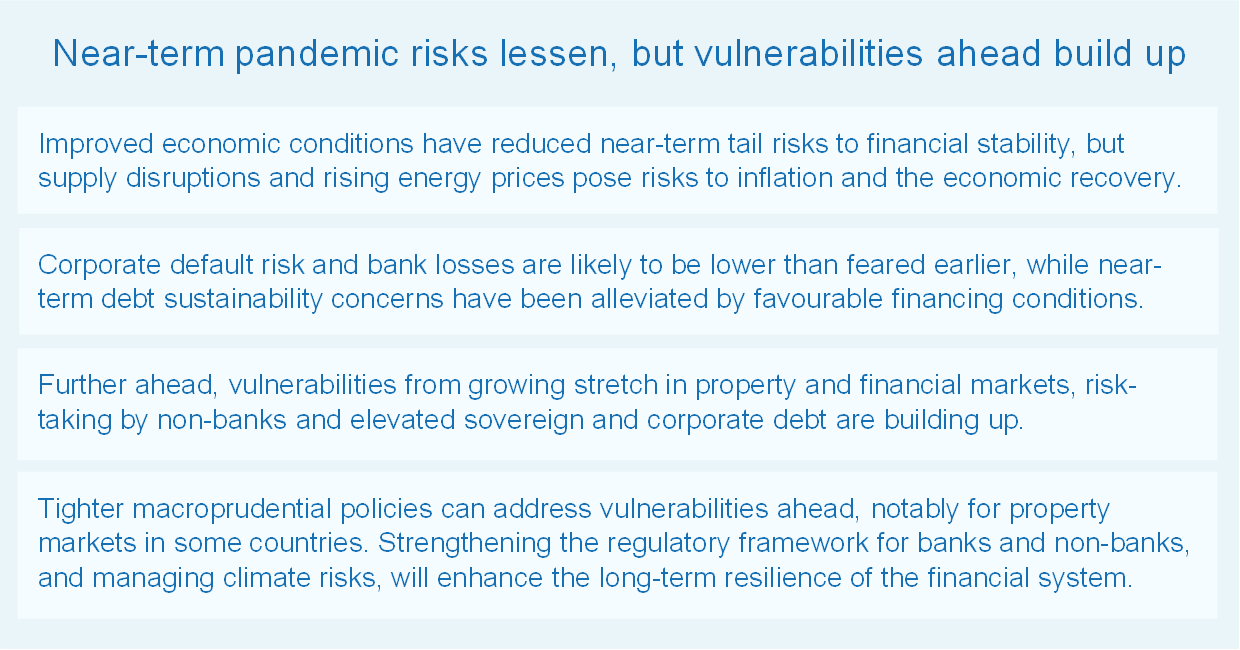
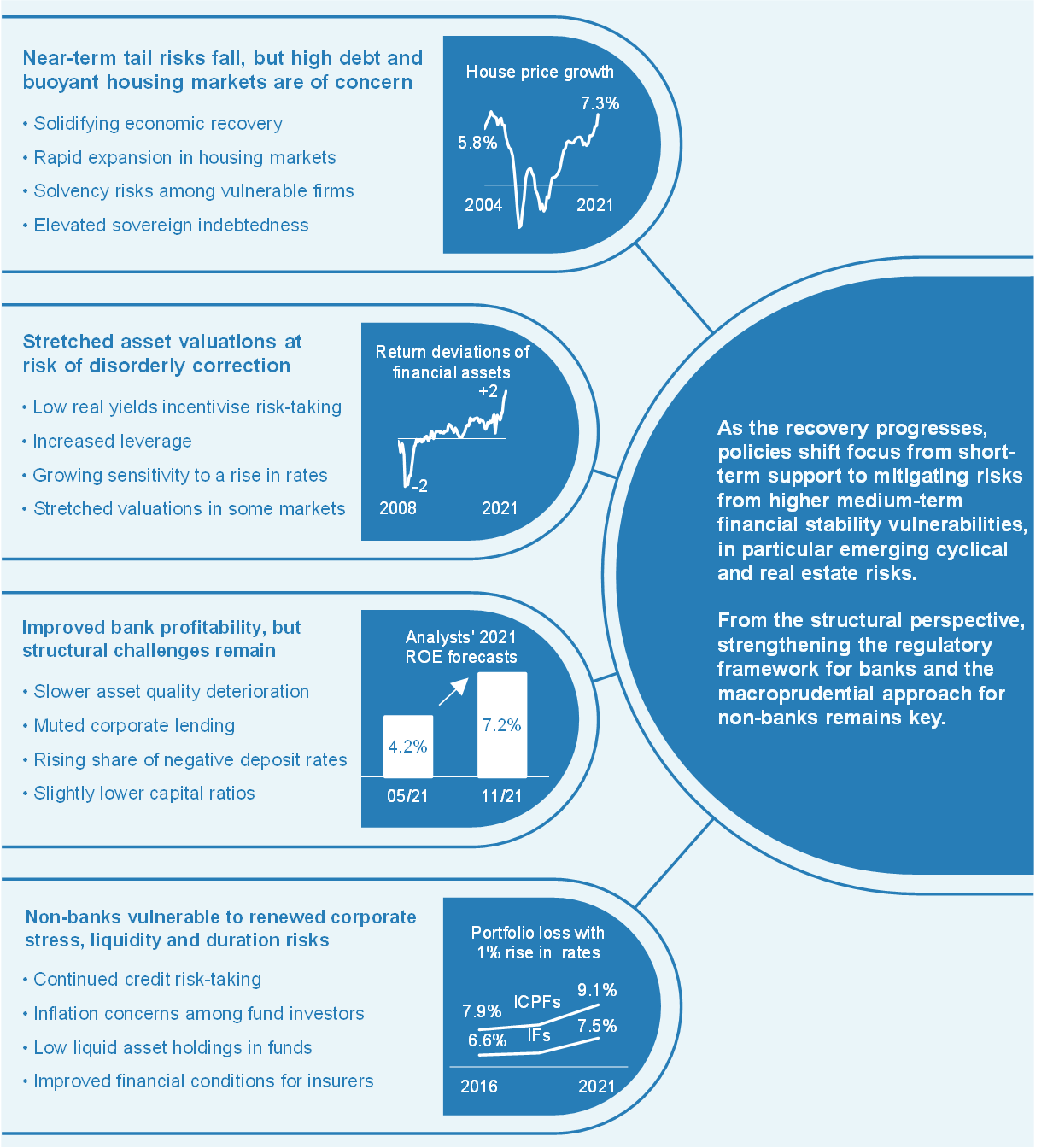
Near-term pandemic risks lessen, as vulnerabilities ahead build up
Improved economic conditions have reduced near-term tail risks to financial stability. Indicators of near-term financial stress have fallen to pre-pandemic lows since the previous FSR (see Chart 1, panel a), in line with the recovery seen in euro area economic activity in the first half of 2021. While the recovery has broadened across euro area countries and sectors as lockdown measures have eased, some near-term risks remain, as corporate fragility remains high in certain sectors which were more heavily impacted by pandemic restrictions and had higher pre-existing indebtedness. There is also a risk that recent strains in global supply chains and the spike in energy prices could have longer-lasting effects on inflation than expected and weigh on the economic recovery.[1] Low vaccination rates in some parts of the world and growing vulnerabilities in major emerging market economies, notably the strains experienced by major property developers in China, also add to risks.
Chart 1
Near-term risks have lessened in the financial sector and the real economy as pandemic-related uncertainty fades, but vulnerabilities further out are on the rise

Sources: ECB and ECB calculations.
Notes: Panel a: “Probability of default of two or more LCBGs” refers to the probability of simultaneous defaults in the sample of 15 large and complex banking groups (LCBGs) over a one-year horizon. On the composite indicator of systemic stress in financial markets, see Holló, D., Kremer, M. and Lo Duca, M., “CISS – a composite indicator of systemic stress in the financial system”, Working Paper Series, No 1426, ECB, March 2012. On the composite indicator of systemic stress in euro area sovereign bond markets, see Garcia-de-Andoain, C. and Kremer, M., “Beyond spreads: measuring sovereign market stress in the euro area”, Working Paper Series, No 2185, ECB, October 2018. Panel b: the systemic risk indicator has been adjusted to assume Q4 2019 GDP in the computation of the bank credit-to-GDP contribution. For more details on the systemic risk indicator, see Lang, J.H., Izzo, C., Fahr, S. and Ruzicka, J., “Anticipating the bust: a new cyclical systemic risk indicator to assess the likelihood and severity of financial crises”, Occasional Paper Series, No 219, ECB, February 2019. Panel c: growth-at-risk is the 5th percentile prediction of the quantile regressions model estimated for a panel of euro area countries. Explanatory variables include a lag of GDP growth and indicators of cyclical systemic risk, financial stress and economic sentiment. RRE: residential real estate.
Vulnerabilities further out have been building up. Indicators of medium-term systemic risk have continued increasing in recent months (see Chart 1, panel b), while rising medium-term growth-at-risk estimates also point to a changing time profile of risks (see Chart 1, panel c). Concerns particularly relate to pockets of exuberance in credit, asset and housing markets as well as higher debt levels in the corporate and public sectors as a legacy of the pandemic.
Generally improved outlook for sovereigns and firms
Sovereign debt positions in the euro area, although historically high, have benefited from the ongoing recovery and continued favourable financing conditions. Sovereign debt levels have risen sharply since 2019 to nearly 100% of GDP on aggregate for the euro area. While government action was instrumental in avoiding deeper pandemic-related scars on the euro area economy, it still adds to medium-term sovereign debt challenges, particularly for the more highly indebted countries. For the time being, current favourable financing conditions, driven in part by European initiatives such as the Next Generation EU instrument, have allowed governments to lock in long-term financing at historically low interest rates across the rating spectrum (see Chart 2, panel a). The related increase in the residual maturity of outstanding government debt helps reduce rollover risks going forward.
Chart 2
Stress in euro area sovereign bond markets is mitigated by favourable financing conditions, while the sovereign-bank-corporate nexus has loosened

Sources: Bloomberg Finance L.P., S&P, Moody’s, Fitch, IHS Markit, ECB and ECB calculations.
Notes: Panel a: the rating score represents the average rating by the three major rating agencies: Moody’s, Standard & Poor’s and Fitch. The bond yields indicate the long-term interest rate for convergence purposes (secondary market yields of government bonds with maturities of ten, or close to ten, years). Panel b: sovereign CDS spreads on five-year senior bonds are in relation to the average for five countries (France, Germany, Italy, the Netherlands and Spain). For corporate spreads, the iBoxx EUR Non-Financials option-adjusted spread is used. Bank CDS spreads are based on an average across five-year senior bonds of 12 listed euro area banks. CDS: credit default swap.
The ongoing economic recovery has also helped debt-to-GDP ratios to stabilise. The transition from blanket fiscal support to more targeted measures, coupled with the gradual exit from support schemes, has reduced strains on public finances. The positive role that fiscal (and monetary) policies have had in limiting lasting damage to corporates and banks has in turn limited negative feedback to governments via the sovereign-bank-corporate nexus (see Chart 2, panel b). That said, if financing costs were to rise and economic growth were to fall short of expectations, this could put sovereign debt dynamics on an unfavourable trajectory, in particular in higher-debt countries (see Box 1), and contribute to some reassessment of sovereign risk by market participants going forward.
Chart 3
Corporate solvency concerns have lessened, but some sectors continue to feel the impact of the pandemic more than others

Sources: Moody’s Analytics, Eurostat and ECB calculations.
Notes: Panel a: European speculative-grade default rates forecast by Moody’s Analytics as at May 2020, November 2020, May 2021 and September 2021. In the baseline scenario, declining default rates among speculative-grade credits are assumed to be supported by increasing vaccination rates and continued low policy rates. The optimistic scenario builds on the favourable baseline, expecting markets to remain very supportive of speculative-grade issuers in 2021. By contrast, the pessimistic scenario acknowledges a particularly weak ratings mix among European speculative-grade issuers. For more details on the different scenarios, see Moody’s website. Panel b: “Bankruptcy declarations” refers to the number of legal units that had started bankruptcy proceedings at any time during the second quarter of 2020 and the second quarter of 2021 respectively. “New business registrations” captures the number of legal units entered in the company register.
Near-term euro area corporate insolvency concerns have fallen, although some firms remain vulnerable, notably in pandemic-sensitive sectors. Corporate profitability has shown a broad-based recovery in 2021 as economic activity has expanded. Corporate debt servicing capacity has also improved on account of low financing costs, improved revenues and continued public support measures. On average, corporate defaults have come in lower than the most optimistic expectations earlier in the pandemic (see Chart 3, panel a), while insolvencies have remained around 15% below pre-pandemic levels. However, insolvencies in those sectors most affected by the pandemic did rise strongly and without being offset by a rise in new business registrations, suggesting a more pessimistic outlook for those sectors (see Chart 3, panel b). Going forward, corporate insolvencies could still rise further, due to a backlog of unresolved bankruptcy cases and a gradual phasing-out of policy support measures, although by less than feared in the initial phases of the pandemic. That said, more vulnerable and highly leveraged firms may be challenged by the scaling-back of support measures and, in the medium term, debt sustainability concerns may re-emerge given the sizeable debt accumulation during the pandemic.
Euro area banks’ structural problems resurface as pandemic-induced vulnerabilities dissipate
Market sentiment towards euro area banks has remained favourable, as the near-term profitability outlook has improved. Continuing the trend that started in July 2020, banks’ equity price valuations have returned to pre-pandemic levels (see Chart 4, panel a). This was driven, among other things, by better than expected bank results on aggregate in the first half of the year, the lifting of the ECB Banking Supervision recommendation on limiting dividends as of October 2021[2] and a steeper yield curve. At the same time, the overall credit risk outlook for banks has improved in tandem with more benign conditions in the non-financial corporate sector (see Chart 4, panel b). Bank valuations were additionally bolstered by the confirmation of the resilience of the sector to adverse shocks in both the July 2021 stress test and the October 2021 macroprudential stress-test exercise (see Box 6). Taken together, these factors seem to indicate that investors consider the banking sector to have largely overcome the initial pandemic-induced challenges.
Looking ahead, bank profitability remains hampered by euro area banks’ structural challenges. Bank profitability has improved overall since the start of 2021 on the back of lower loan loss provisions and stronger revenue streams from investment banking (see Box 5), but the profitability outlook continues to depend on the path of overall economic recovery and the pandemic. While the non-performing loan (NPL) ratio has dropped to levels last seen before the global financial crisis on account of further progress made in NPL sales, asset quality concerns may resurface as government support measures are gradually withdrawn, reinforcing the need for effective NPL solutions (see Special Feature C). Euro area bank profitability remains lower than in other jurisdictions (see Chart 4, panel c). Thus, even as pandemic-related challenges abate, pre-pandemic structural challenges, such as low cost-efficiency, limited revenue diversification, overcapacity and compressed margins in a low interest rate environment, remain. Consolidation via mergers and acquisitions could be one potential avenue for helping the sector to return to more sustainable levels of profitability (see Special Feature B). Looking ahead, euro area banks also face increasing urgency to meet digital transformation needs and to manage the implications of the transition to a greener economy.
Chart 4
Sentiment remains positive towards euro area banks as dividend payments resume and asset quality concerns fade, but structurally low profitability is still a concern

Sources: Bloomberg Finance L.P., ECB supervisory data and ECB calculations.
Notes: Panel a: 2022 bank ROE expectations indicate the median of a sample of 31 listed euro area banks. Panel b: based on a balanced sample of 92 significant institutions. Panel c: based on a sample of 31 listed euro area banks, 15 listed US banks, 4 listed UK banks, 11 listed Japanese banks and 7 listed Nordic banks. “Nordic countries” refers to Denmark, Finland and Sweden. The forecasts for 2021 and 2022 are as of 9 November 2021. E: estimated; HH: household; P/B: price-to-book; ROE: return on equity.
Continued exuberance leaves parts of real estate and financial markets increasingly susceptible to corrections
Euro area house prices rose at their fastest pace since 2005 in the second quarter of 2021, amid signs of easing mortgage lending standards. While the economic recovery has also supported near-term fundamentals for the housing market, continued strong house price growth of around 7% at the euro area aggregate level remains a cause for concern amid signs of more broad-based price increases across both urban and non-urban areas (see Chart 5, panel a). Some of this rise could reflect an increase in demand for housing (including larger properties) during the pandemic. But growing signs of overvaluation for the euro area as a whole render residential real estate (RRE) markets more prone to a correction, in particular in countries with more elevated valuation levels (see Section 1.5). In some countries, the strength of RRE markets is coupled with buoyant mortgage lending, and there is evidence of a progressive deterioration in lending standards, as reflected by the increasing share of loans with high loan-to-value and loan-to-income ratios (see Chapter 5). High and rising levels of household indebtedness also contribute to heightened medium-term vulnerabilities in some countries (see Chart 5, panel b). Taken together, these developments have strengthened the case for considering further activation of macroprudential policy measures, where appropriate.
Commercial real estate (CRE) markets have benefited from the improving economic outlook, but parts of the market remain vulnerable to further price corrections. Investor sentiment has improved over recent quarters, but a substantial share of CRE investors still see the market in a downturn. The outlook seems particularly poor for lower quality CRE assets, with market intelligence flagging remote working, health concerns and the rush for greener property as channelling demand towards the prime segment. This intersects with elevated vulnerabilities among those sectors most affected by the pandemic, namely retail and office assets. Transaction data suggest substantial holdings of these most vulnerable assets across the euro area financial system, in particular for non-banks.
Chart 5
Vulnerabilities are on the rise in non-financial asset markets amid buoyant credit dynamics in some countries
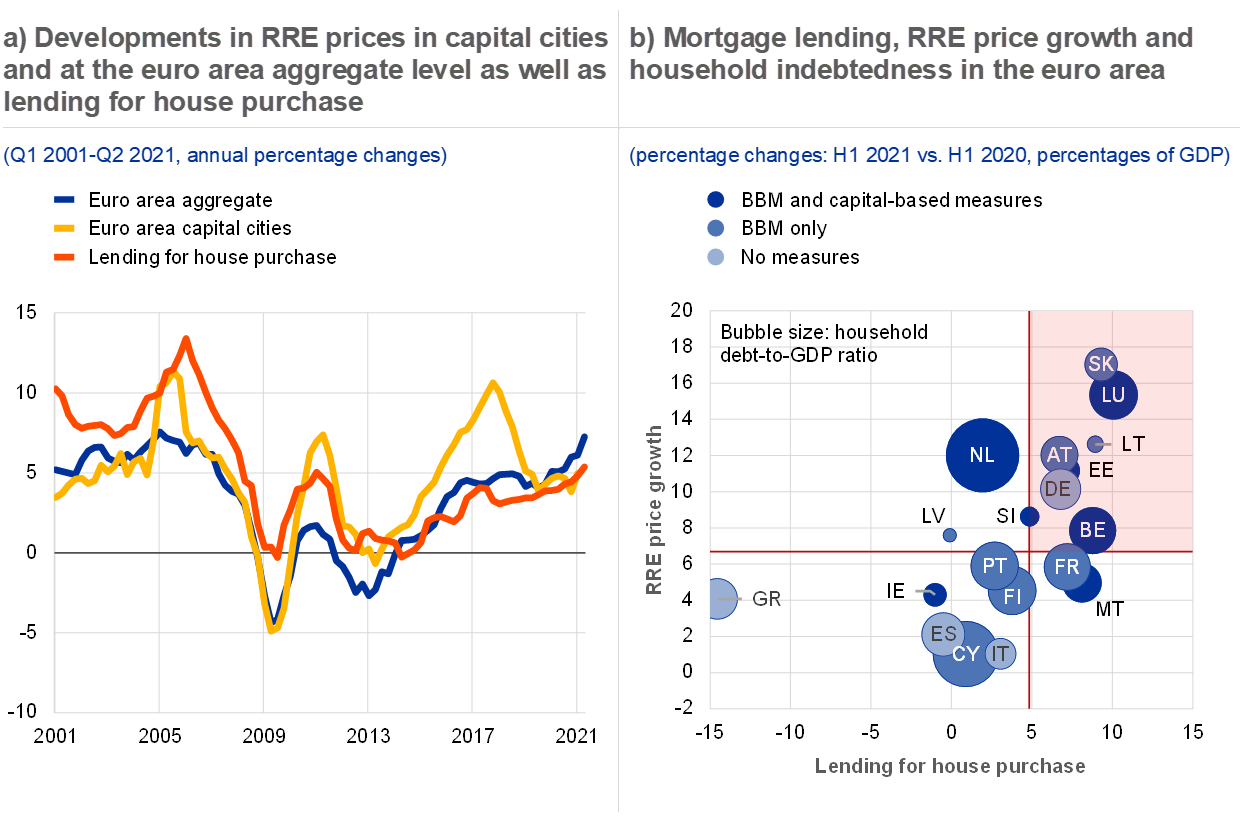
Sources: ECB and ECB calculations.
Notes: Panel a: the composition of the sample underlying the time series on RRE price developments in capital cities changes over time and includes Austria, Belgium, Estonia (from 2003), Finland (from 2010), France, Germany, Ireland (from 2005), Italy, the Netherlands, Slovenia (from 2010) and Spain. The euro area series is a weighted average based on 2014 GDP weights. Panel b: the bubble size indicates the household debt-to-GDP ratio as at March 2021. Light blue bubbles refer to countries which have applied borrower-based macroprudential measures such as collateral or income-based limits. Dark blue bubbles refer to countries that have applied both capital-based (e.g. risk weights on RRE exposures) and borrower-based macroprudential measures. Grey bubbles indicate countries with no capital or borrower-based measures in place. The red horizontal and vertical lines indicate the euro area aggregate. BBM: borrower-based measures; RRE: residential real estate. In the Netherlands, the announced CRR measure (Article 458) foreseen for Q3 2020 (LTV-dependent risk weights floor for domestic IRB mortgage loan portfolios) was postponed in March 2020 in light of the COVID-19 pandemic. The measure should come into effect on 1 January 2022.
Signs of exuberance are increasingly visible in some financial market segments as real yields fall and the search for yield continues. Real yields fell to all-time lows amid indications of a moderating pace of the economic recovery and increased inflationary pressures (see Chart 6, panel a), incentivising risk-taking in financial markets. Euro area and global equity markets have continued to advance since the publication of the previous FSR, also bolstered by a better than expected corporate earnings season and continued accommodative financial conditions. The stock prices of pandemic-sensitive firms have continued to underperform the market, indicating a continued concentration of risk in some sectors. Issuance activity in high-yield corporate credit markets has reached new highs in 2021 (see Chart 6, panel b). Despite large issuance volumes, spreads remain at record lows, pointing to strong investor appetite for risky assets.
Chart 6
Exuberance in markets continued amid lower real yields, and high valuations render some financial markets vulnerable to repricing if global liquidity conditions change

Sources: Refinitiv, Dealogic, Bloomberg Finance L.P., ECB and ECB calculations.
Notes: Panel a: “EA 5Y5Y forward inflation swap rate” refers to the euro area five-year forward inflation-linked swap rate five years ahead. Panel b: government option-adjusted spreads are employed. Panel c: the basket of global financial assets used to compute the valuation metric includes: real yields on euro area, Japanese, UK and US ten-year government bonds; euro area and US investment-grade and high-yield bonds; euro area, Japanese, UK and US equity; US real estate investment trusts and mortgage-backed securities; and emerging market sovereigns and equity. EA: euro area.
Buoyant financial asset price developments raise overvaluation concerns in some markets, increasing the likelihood of market corrections. The combination of historically low real yields and elevated valuations (see Chart 6, panel c) leave sub-investment-grade bond and some equity markets vulnerable to adverse interest rate and growth shocks (see Chapter 2). The presence of a cohort of vulnerable firms could increase the sensitivity of corporate securities prices to risk-off shocks (see Box 3). A correction in markets could be triggered by a weaker than expected economic recovery, spillovers from adverse developments in emerging market economies, a re-intensification of stress in the non-financial corporate sector or abrupt adjustments in market expectations regarding the prospective path of monetary policy normalisation. In addition, more persistent inflationary pressures than currently anticipated could push nominal yields higher, which may put valuations under pressure. Beyond core markets, some more exotic market segments, such as crypto-asset markets, also remain subject to speculative bouts of volatility, with the growing popularity of stablecoins increasing interlinkages between crypto-asset and conventional financial markets (see Box 4).
In parallel, the non-bank financial sector continues to face elevated credit risk. Non-banks continue to be an important source of financing for non-financial corporations (NFCs) as the economy recovers. However, in their search for yield, investment funds (IFs) have increased credit risk in their portfolios by purchasing around 70% of euro area-domiciled NFCs’ newly issued BBB and high-yield bonds, leading to increased holdings of lower quality bonds in their portfolios (see Chart 7, panel a). Similarly, insurance corporations and pension funds (ICPFs) have further expanded their lower-rated corporate debt holdings (see Chart 7, panel b). While reduced corporate sector vulnerabilities alleviate related credit risks in the short run, non-banks remain exposed to the risk of substantial credit losses should conditions in the corporate sector deteriorate. For insurers, risks are partly mitigated by a more favourable operating environment, underpinned by the sector’s robust capitalisation.
Chart 7
Non-banks continue to absorb the bulk of the record-high issuance of lower-rated instruments amid growing credit, liquidity and duration risks
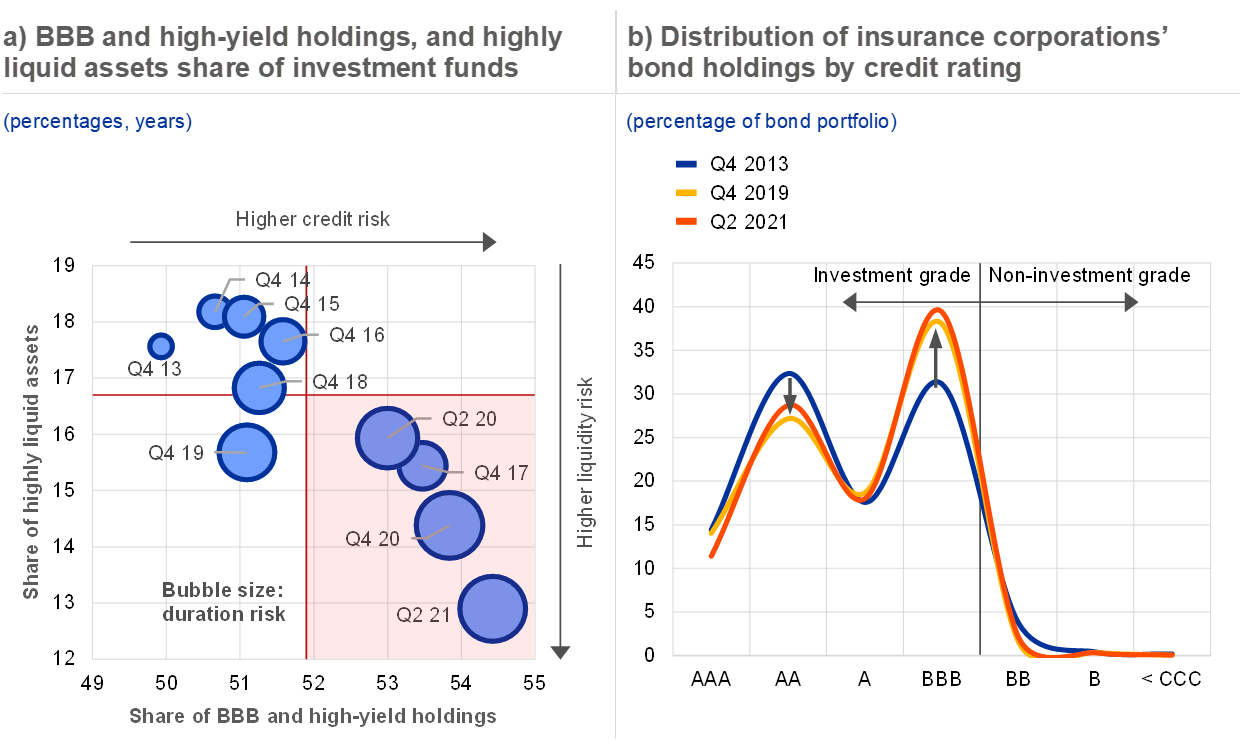
Sources: ECB (securities holdings statistics and Centralised Securities Database) and ECB calculations.
Notes: Panel a: the red horizontal and vertical lines indicate long-term sample averages between Q4 2013 and Q2 2021. The bubble size indicates the duration risk approximated by the weighted average residual maturity of the investment fund sector’s bond holdings and scaled exponentially for visualisation purposes. The credit rating refers to debt securities’ worst rating in the given period. Highly liquid assets are holdings with HQLA level 1. Panel b: holdings include globally issued long and short-term debt securities excluding non-rated assets. Credit rating refers to debt securities’ worst rating in the given period. HQLA: high-quality liquid assets.
For investment funds, growing credit risks are exacerbated by high liquidity risk as well as increasing duration risk exposure. Low liquidity holdings leave the sector vulnerable in the event of large-scale outflows (see Chart 7, panel a). At the same time, the average duration of exposures has increased during the pandemic. Were bond yields to rise, valuation losses could trigger outflows from investment funds which – when coupled with the low liquidity buffers – could force bond funds to liquidate assets to meet investor redemptions. Such procyclical selling behaviour could also amplify other financial market shocks. Overall, elevated levels of credit, liquidity and duration risks underscore the importance of strengthening the resilience of the non-bank financial sector, including from a macroprudential perspective.
Climate change-related vulnerabilities call for policies to support an orderly transition
A rapid deepening of green financial markets continues, but greenwashing risks warrant monitoring. Investor interest in green finance has continued to grow rapidly over the course of 2021, alongside green investment more generally (see Chart 8, panel a), indicating increasing awareness of the need to transition to a low-carbon economy. While financial markets can play an important role in financing this transition, greenwashing concerns persist. These need to be tackled through better information, especially in relation to forward-looking commitments and plans, and enhanced standards, both to ensure that green finance effectively supports the transition and to foster efficient market mechanisms. Ongoing official sector initiatives in Europe and in global standard-setting bodies to shore up disclosures, standards and taxonomies should help in addressing some of these issues.
Chart 8
Financial markets, non-banks and banks all face the challenge of achieving an orderly transition to a low-carbon economy
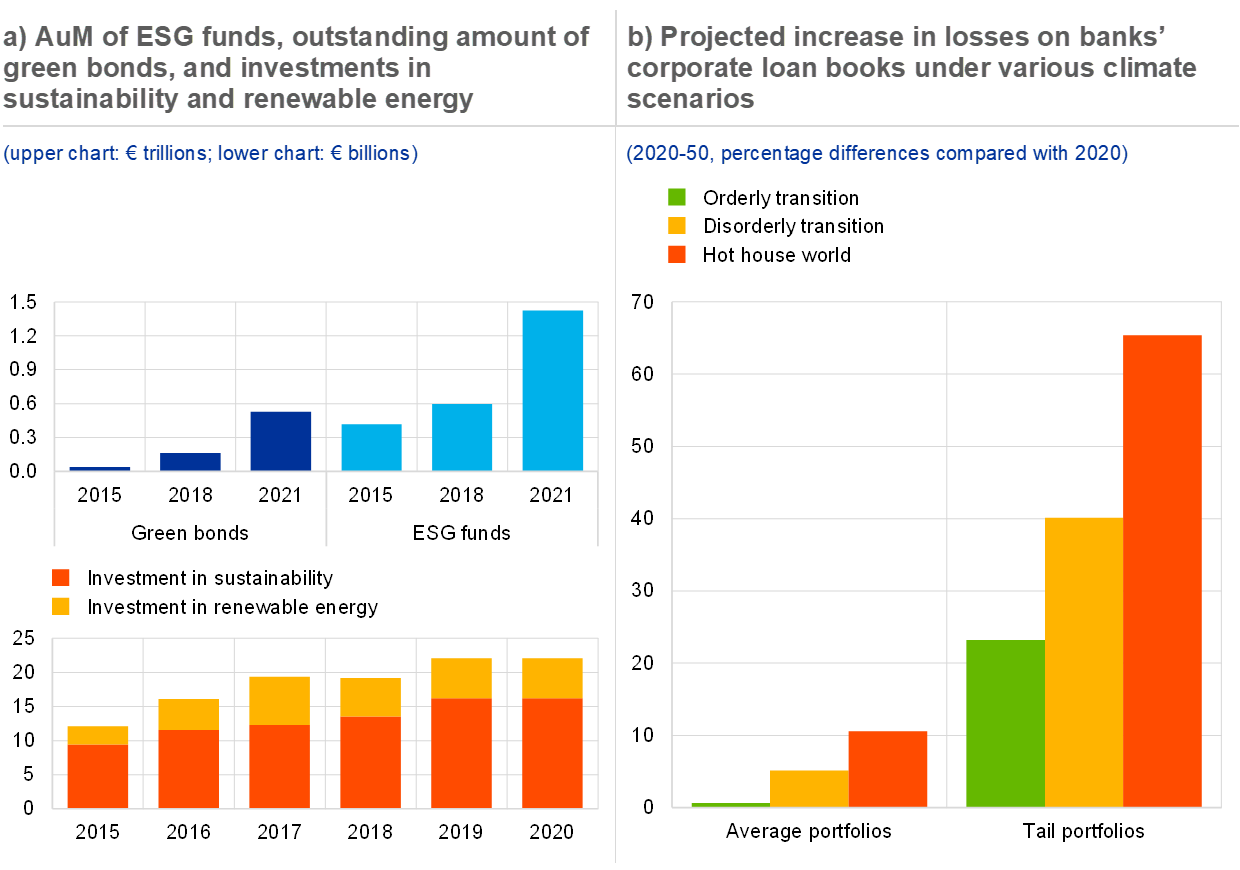
Sources: Bloomberg Finance L.P., ECB and ECB calculations based on NGFS scenarios (2020).
Notes: Panel a: “Investment in sustainability” includes investments in operational environmental and social compliance and other internal environmental and social initiatives (e.g. the amount invested in pollution prevention, recycling, employee training and environmental remediation). Panel b: the average percentage change in median loan portfolio PDs is presented relative to 2020 values for the top 10% of banks in terms of expected loss dispersion, and is compared with the same values for the median results across all banks in the sample. “Tail portfolios” are those banks within the 90th percentile of highest relative increase in expected losses between 2020 and 2050; “Average portfolios” refers to the total sample. For the specification of the scenarios, see Alogoskoufis, S., Dunz, N., Emambakhsh, T., Hennig, T., Kaijser, M., Kouratzoglou, C., Muñoz, M., Parisi, L. and Salleo, C., “ECB economy-wide climate stress test”, Occasional Paper Series, No 281, ECB, September 2021, and “NGFS Climate Scenarios for central banks and supervisors”, Network for Greening the Financial System, June 2020. AuM: assets under management; ESG: environmental, social and corporate governance; PD: probability of default.
Timely, concerted action would ensure an orderly transition to a greener economy and the resilience of the financial system to climate-related risks. The results of the ECB’s recent top-down climate stress test highlight the benefits of a timely and orderly transition to mitigate climate-related vulnerabilities, in particular for the tail of banks most exposed to climate risks (see Chart 8, panel b). The floods and wildfires in Europe earlier this year illustrate financial impacts of climate-related hazards. This includes not only impacts on bank lending, but also on insurers directly exposed to losses from natural catastrophes. From a systemic perspective, insufficient and potentially diminishing insurability of climate-related risks and associated risk pooling could also significantly amplify future economic losses.
As near-term risks fall, policy moves to address financial stability vulnerabilities further out
Recent months have seen attention shift from near-term financial stability risks associated with the pandemic to increasing medium-term vulnerabilities. Improved economic conditions have contributed to a decline in near-term vulnerabilities for sovereigns, corporates and banks, even if heterogeneity at the country and sector levels remains. Vulnerabilities from mispricing in some financial and tangible asset markets have increased, however, amid continued risk-taking by non-bank financial institutions. Moreover, the pandemic has left a legacy of significantly higher levels of indebtedness across sectors. These vulnerabilities could unravel in a disorderly manner through shocks such as: (i) an abrupt change in market expectations regarding the pace of monetary policy normalisation; (ii) a premature withdrawal of government support to non-financial sectors; or (iii) a re-intensification of the spread of the coronavirus. The potential for these vulnerabilities to materialise simultaneously and to possibly amplify each other further increases the medium-term risks to financial stability.
Policies are also shifting from providing short-term support towards addressing financial stability vulnerabilities ahead. Fiscal, supervisory and monetary policies have remained supportive, thereby avoiding strong adverse real-financial feedback loops. However, policies have started to shift from containing the immediate economic fallout from the pandemic and ensuring the near-term recovery to managing medium-term risks to financial stability. While the new ECB monetary policy strategy foresees a flexible approach to considering financial stability going forward (see Box 8), macroprudential policies remain the first line of defence against the build-up of systemic risk. A tightening of macroprudential policies may need to be considered in a number of countries as the economic recovery progresses and medium-term vulnerabilities rise, notably in property markets (see Section 5.1). At the same time, there is a need for structural policies to play a greater role in managing the transition to more resilient economic and financial structures that support sustainable economic growth.
Strengthening the regulatory framework, in both the bank and non-bank financial sector, is crucial for the stability of the financial system. From a broader regulatory perspective, strengthening the banking union and the timely, full and consistent implementation of the final leg of Basel III reforms are essential to address shortcomings in the existing framework. That said, the effectiveness of the framework could be improved, as some banks may be reluctant to use available capital buffers in periods of economic distress (see Special Feature A), while some features of the current structural buffer regime could unintentionally create disincentives for cross-border mergers (see Special Feature B). Finally, from a system-wide perspective, further progress towards developing a macroprudential approach for non-banks is needed given their increasing role in funding the real economy and their close interlinkages with the wider financial system (see Section 5.2). In particular, the Financial Stability Board (FSB) has recently issued policy proposals to tackle vulnerabilities in money market funds, with a key aim being to ensure that they hold sufficient safe and liquid assets. It is now important for the FSB to move towards developing concrete policy proposals in relation to open-ended investment funds and margining practices.
1 Macro-financial and credit environment
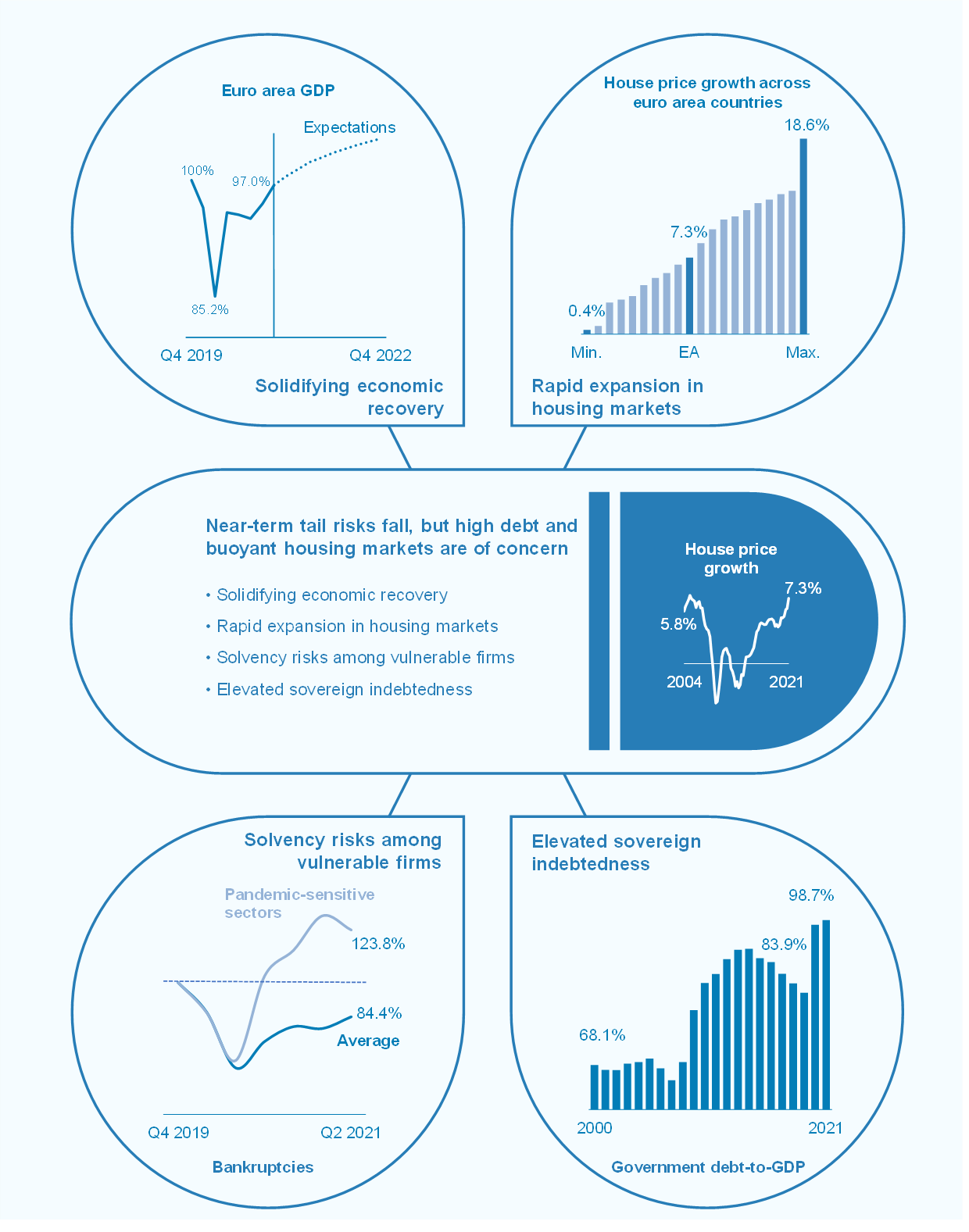
1.1 The economy reopens, but inflationary pressures pose downside risks to the recovery
Economic growth surprised to the upside in the first two quarters of 2021, although growth momentum has slowed more recently. Overall, real GDP in the third quarter of 2021 was about 0.5% below its level in the fourth quarter of 2019, as the euro area continued to recover. However, the momentum of the growth has moderated to some extent recently, with the rise in energy prices and supply chain bottlenecks posing downside risks to economic growth going forward. At the same time rising coronavirus (COVID-19) incidence rates had a more limited impact so far on hospitalisations and deaths than in previous waves (see Chart 1.1, panel a). Moreover, mobility data indicate that time spent at home as well as time spent on retail and recreational activities remain near pre-pandemic levels (see Chart 1.1, panel b). Despite the slowdown in the recovery, it is still likely that real GDP will surpass its pre-pandemic levels in the fourth quarter of 2021, two quarters earlier than had been expected at the start of the year.
Chart 1.1
COVID-19 cases on the rise as society and economies have largely reopened
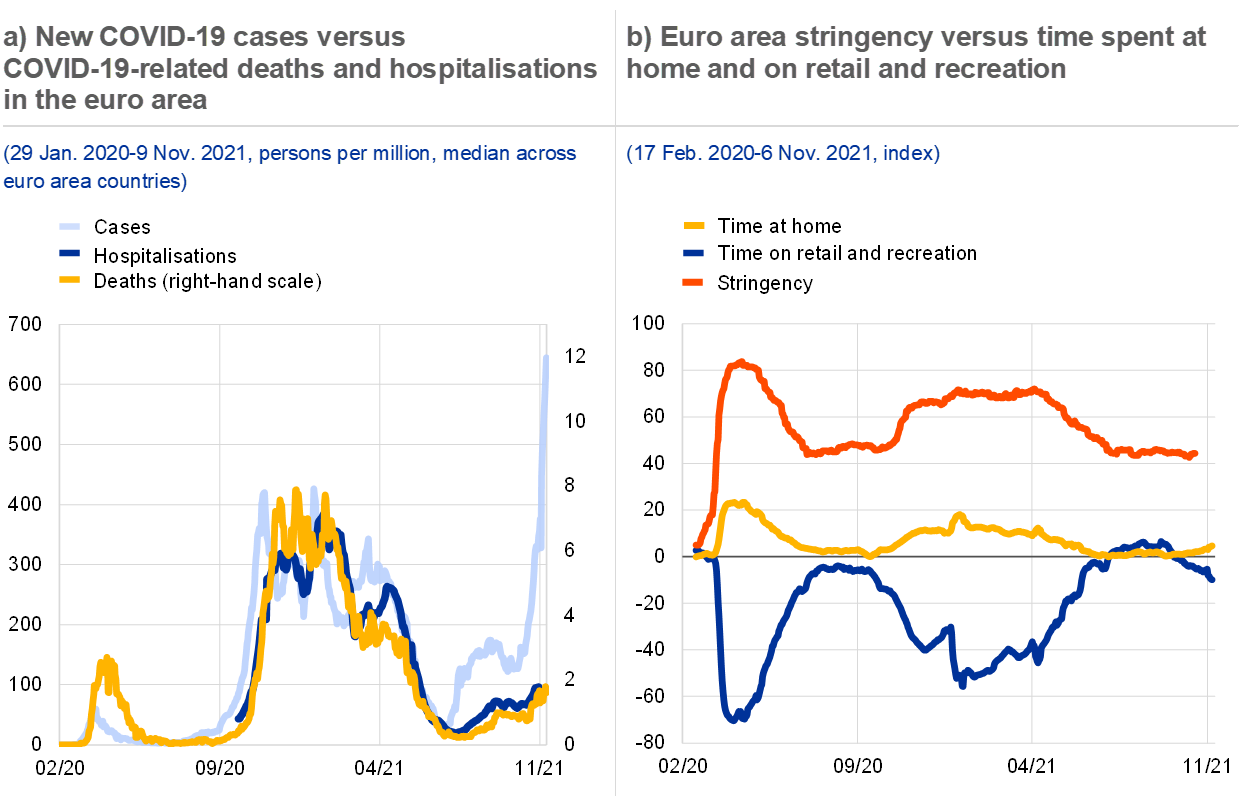
Sources: Our World in Data, Hale et al., Eurostat, Google LLC “Google COVID-19 Community Mobility Reports” and ECB calculations.
Notes: Panel a: hospitalisations exclude Germany and Greece. Panel b: the stringency index used is the Oxford COVID-19 Government Response Tracker from the Blavatnik School of Government, University of Oxford. It is based on 20 indicators, ranging from information on containment and closure policies (e.g. school closures and restrictions on movement) to economic policies (e.g. income support provided to citizens) and health system policies (e.g. COVID-19 testing regimes or emergency investments in healthcare). It reports the strictness of lockdown-style policies that primarily restrict people’s behaviour, on a scale of 0 to 100. See Hale, T. et al., “A global panel database of pandemic policies (Oxford COVID-19 Government Response Tracker)”, Nature Human Behaviour, 2021. Changes relate to the number of visitors to places of retail, and recreation time spent in places of residence relative to a baseline day representing a normal value for that day of the week. The baseline day is the median value for the five‑week period running from 3 January to 6 February 2020. The index is smoothed to the rolling seven-day average.
While vaccination progress has helped to balance the risks to the economic recovery in the euro area, some downside risks remain. Higher vaccination levels compared with the spring have reduced the level of downside risks for both this year and next (see Overview and Chart 1.2, panel a). However, current economic expectations are still surrounded by uncertainty stemming from the possible need for new containment measures during the winter months. The virus is continuing to spread, possibly affecting vaccine-induced immunity or creating new mutations, which might translate into new constraints on economic activity. In addition, although economic activity has rebounded, the number of people in employment and total hours worked remain below pre-pandemic levels (see Section 1.3). Moreover, labour shortages, reflecting increasing job reallocation and labour mismatches, could affect the labour market for sectors that are facing a more permanent drop in demand. As such, the pandemic continues to be one of the main risks to economic growth going forward.
Divergence in gross value added between sectors and countries narrowed, in part reflecting lockdown measures becoming more targeted. The reopening of the euro area economy since the spring and increasingly targeted containment measures have reduced divergence in gross value added between sectors and countries (see Chart 1.2, panel b). In addition, although they have softened since the summer, confidence indictors are signalling a recovery in economic activity in both services and manufacturing going forward. However, despite the economic recovery, the unequal impact of the pandemic on these countries continues to be reflected in economic projections. Although the euro area economy as a whole is expected to surpass pre-pandemic growth levels this year, private sector expectations show that for some of the countries hardest hit by the pandemic this is not likely to happen before the second half of next year. Moreover, activity in the most-affected sectors remains significantly below pre-pandemic levels (see Chart 1.2, panel b). These sectors would also be subject to the greatest downside risk in the event of a new lockdown. As such, if the uncertain environment prevails, this could result in lower investment and subdued employment prospects, leading to scarring in those sectors that remain vulnerable to an intensification of the pandemic.
Chart 1.2
Tail risks have fallen, but not all sectors have fully recovered from the pandemic
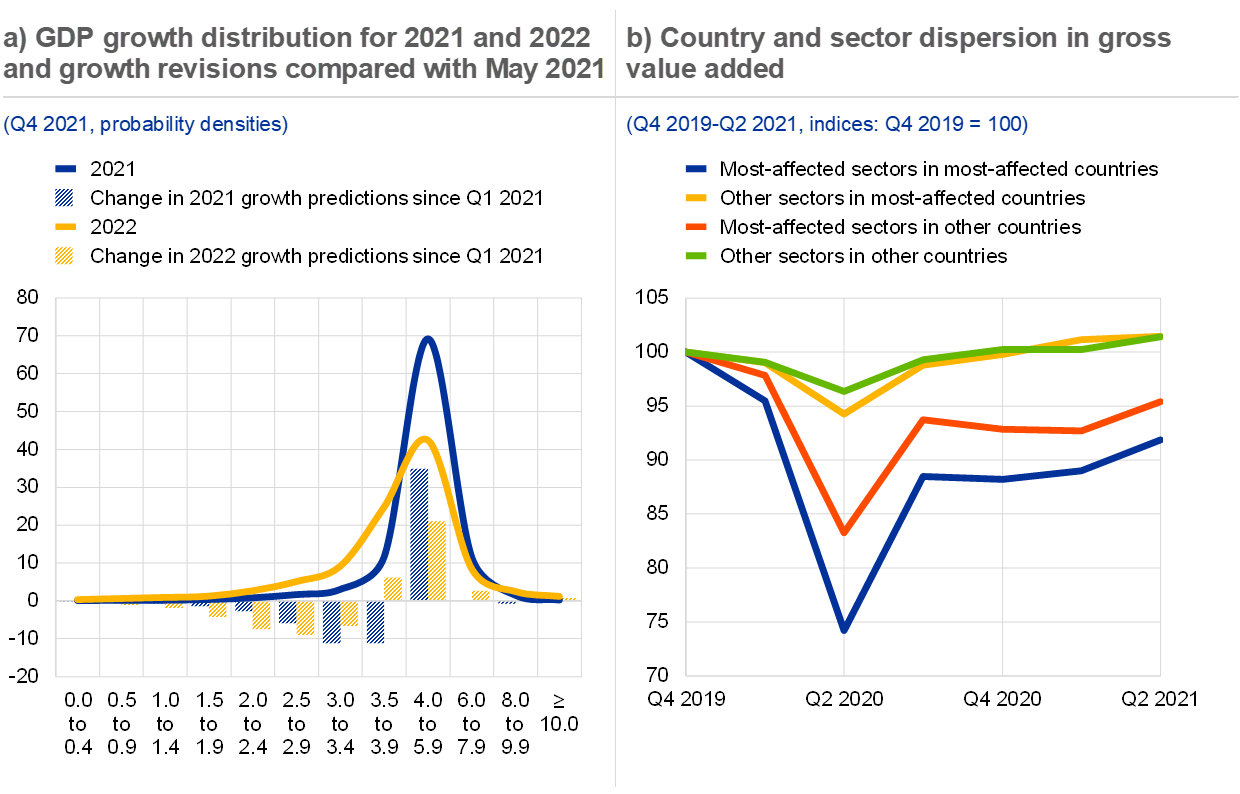
Sources: ECB, ECB Survey of Professional Forecasters and Eurostat.
Notes: Panel a: x-axis labels reflect the year-on-year GDP growth for the euro area economy. Panel b: most-affected sectors include mining, construction, retail and wholesale trade, transport, accommodation and food services, professional and administrative services, arts and entertainment, and other services. Sensitivity to the pandemic is determined by the relative loss in gross value added in the second quarter of 2020. Most-affected countries include Greece, Spain, France, Italy and Portugal, while other countries include the remaining euro area countries.
Supply chain disruptions and surging oil, gas and electricity prices have resulted in rising global inflationary pressures, which could be amplified by unequal vaccination levels. In many advanced economies, inflation reported in 2021 so far has been higher than was projected last year. Although this widespread spike in headline inflation rates around the world largely reflects a sharp increase in energy prices, increases in input costs related to supply disruptions have also contributed to upward pressure on inflation. Moreover, enterprises in both the manufacturing and the services sectors report that production is being hampered by a shortage of material (manufacturing) and labour (services, see Chart 1.3, panel a). Going forward, supply chain disruptions could intensify if further virus outbreaks warrant new lockdowns, notably in emerging markets, where vaccination campaigns are less advanced than they are in developed markets. At the same time, if persistent bottlenecks feed through into higher than anticipated wage rises or the economy returns more quickly to full capacity, price pressures could become stronger. A more persistent high inflation scenario could translate into an untimely tightening of financial conditions, weighing on the economic recovery.
Chart 1.3
Supply chain bottlenecks are increasingly constraining output, while China uncertainty represents a downside risk for the global economic outlook
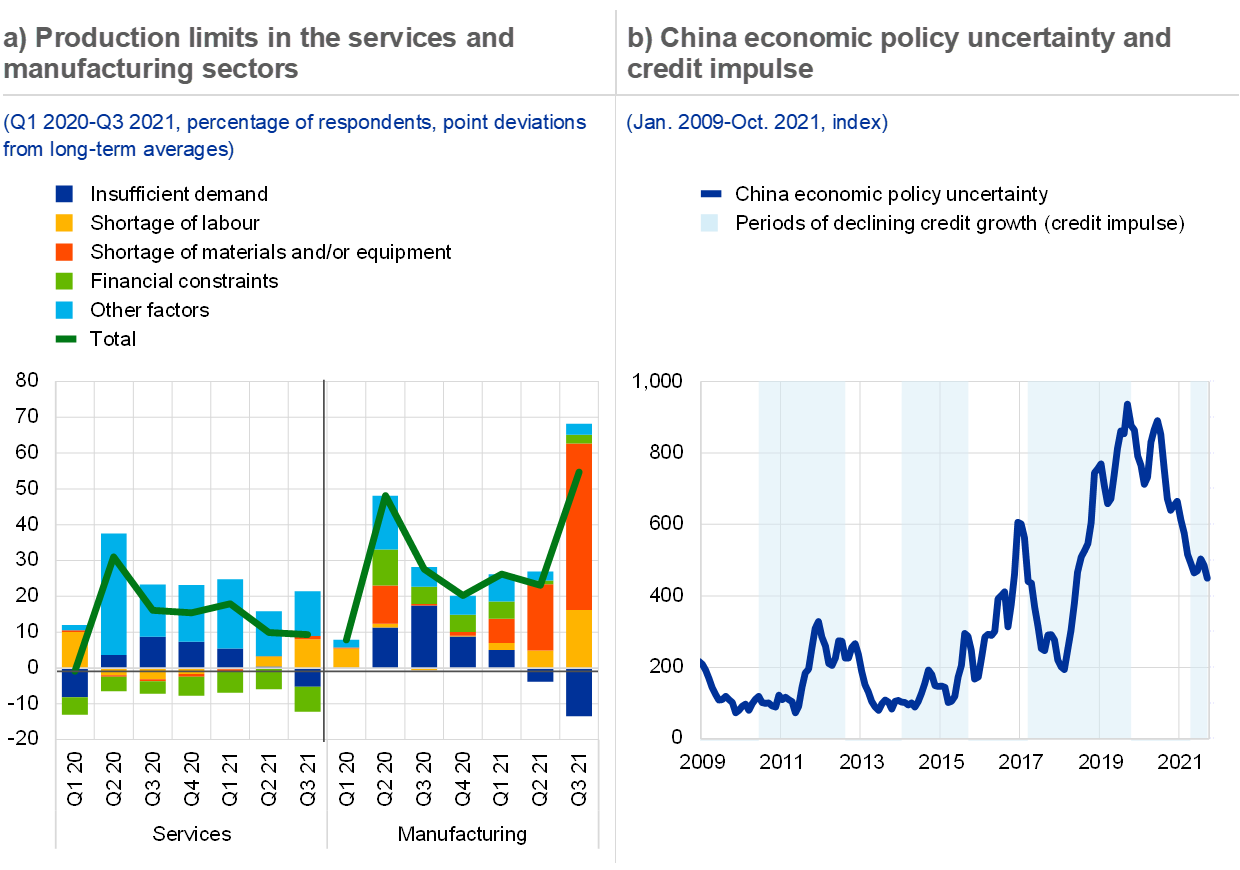
Sources: European Commission, policyuncertainty.com, Bloomberg Finance L.P. and ECB calculations.
Notes: Panel a: reflects the answer to the European Commission’s business and consumer survey question “What main factors are currently limiting your production?”; the category “total” excludes the answer “none”. The long-term average covers 2003-19. Panel b: shaded area reflects a month-on-month decline in Bloomberg’s China credit impulse index. The China economic policy uncertainty index is displayed as the three-month moving average.
High uncertainty in relation to China, combined with evidence of weakening economic activity, has added to downside global economic risks. While China recovered swiftly from the contraction induced by the pandemic in the first quarter of 2020, private sector forecasters have revised down their 2021 economic projections for the Chinese economy as credit impulse has declined and economic policy uncertainty remains elevated (see Chart 1.3, panel b). The deceleration in economic activity has been compounded by the authorities’ efforts to limit leverage among Chinese property developers. Tighter regulations are also aimed at reducing reliance on residential real estate sector growth, which is a key growth driver in China’s economy. Following these developments, Evergrande – one of China’s largest and most indebted property developers – prompted wider market concern in the autumn over the health of the Chinese property sector. So far, the impact on global growth projections and financial markets has been limited, as foreign exposure seems relatively small. However, these developments add to the downside risks for global economic growth prospects[3], given China’s increasing role in global economic and trade developments.
1.2 Sovereign risks are contained in the near term, but elevated debt poses a medium-term vulnerability
Although the pandemic continues to weigh on public finances, the need for further stimulus is gradually declining as the recovery solidifies. With the euro area economy recovering faster than anticipated, governments are expected to run smaller deficits in 2021 and 2022 than projected at the beginning of 2021 (see Chart 1.4, panel a). Moreover, support measures have become more targeted on those sectors of the economy that are still affected by restrictions, thereby reducing their fiscal impact compared with the early days of the pandemic. According to the September 2021 ECB staff macroeconomic projections, the contribution of discretionary stimulus related to the pandemic is expected to decline from 4.6% of GDP in 2021 to 1.5% and 1.2% in 2022 and 2023 respectively. Meanwhile, additional fiscal stimulus measures for 2022 have been adopted by most governments in the context of their draft budgetary plans. These include an expansion of some pandemic-related spending, additional measures to alleviate the adverse impact of the increase in energy prices and other fiscal loosening measures in several countries.
Scaling back pandemic-related stimulus implies a tightening of the fiscal stance in 2022. Current projections for the euro area indicate that, as the economy recovers and government support measures unwind, the fiscal stance will tighten in 2022 (see Chart 1.4, panel a). Although the projected economic outlook allows for such tightening, pandemic-related downside risks surrounding economic projections could make it necessary to introduce new stimulus measures (see Section 1.1).
Despite governments running sizeable budget deficits, the increase in debt-to-GDP levels this year is projected to remain limited. While deficits will be at similar levels to 2020, the increase in debt ratios is expected to be far less pronounced this year, mainly reflecting robust economic growth (see Chart 1.4, panel b). Moreover, the gradual scaling back of fiscal support measures will serve to improve public finances and will contribute to a further decline in debt levels going forward. In 2020, approximately 35% of the increase in the euro area debt-to-GDP ratio was driven by the fall in GDP, but as the economy recovers this denominator effect will subside. Despite these favourable developments, however, government debt is expected to remain significantly above pre-pandemic levels, increasing the vulnerability of the economy to a deterioration in financial conditions and negatively affecting its resilience to future economic shocks (see Box 1).
Chart 1.4
Pandemic-related expenses have caused budget deficits to remain large in 2021, but general government indebtedness has stabilised this year

Sources: ECB, September 2021 ECB staff macroeconomic projections and ECB staff calculations.
Notes: Panel a: the dotted line depicts the 3% of GDP budget deficit threshold set in the Maastricht Treaty to delineate excessive government deficits. The data refer to the aggregate general government sector of euro area countries, adjusted for the impact of NGEU grants on the revenue side. The cyclical component refers to the impact of the economic cycle as well as temporary measures taken by governments, such as one-off revenues or one-off capital transfers. NGEU: Next Generation EU.
Governments have continued to benefit from low debt servicing costs and reduced rollover risk by increasingly issuing long maturity debt. Moreover, sovereign stress has fallen to its lowest level since 2001, as monetary support measures have continued to support financing costs (see Chart 1.5, panel a, and Chapter 2). As a result, governments have increasingly made use of easy financial conditions to issue longer-term debt (see Chart 1.5, panel b). The issuance of such debt fits with the ongoing trend of lengthening the maturity of the government debt portfolio, as the average maturity increased from 6.7 years in December 2010 to 7.9 years in September 2021 for the euro area on aggregate. In terms of debt servicing needs over a period of two years, this increased residual maturity translates into a 15% reduction in principal repayments compared with running the same amount of debt against the maturity profile in 2010.[4] However, debt servicing needs remain elevated, with some euro area countries facing refinancing and interest expenditure in excess of 40% of GDP over the next two years.[5] As such, a future deterioration in financial conditions could weigh on public finances in higher indebted euro area countries, hampering the recovery.
Chart 1.5
Euro area sovereign risk dispersion declined to near all-time lows, while governments made use of easy financial conditions to issue long-term debt
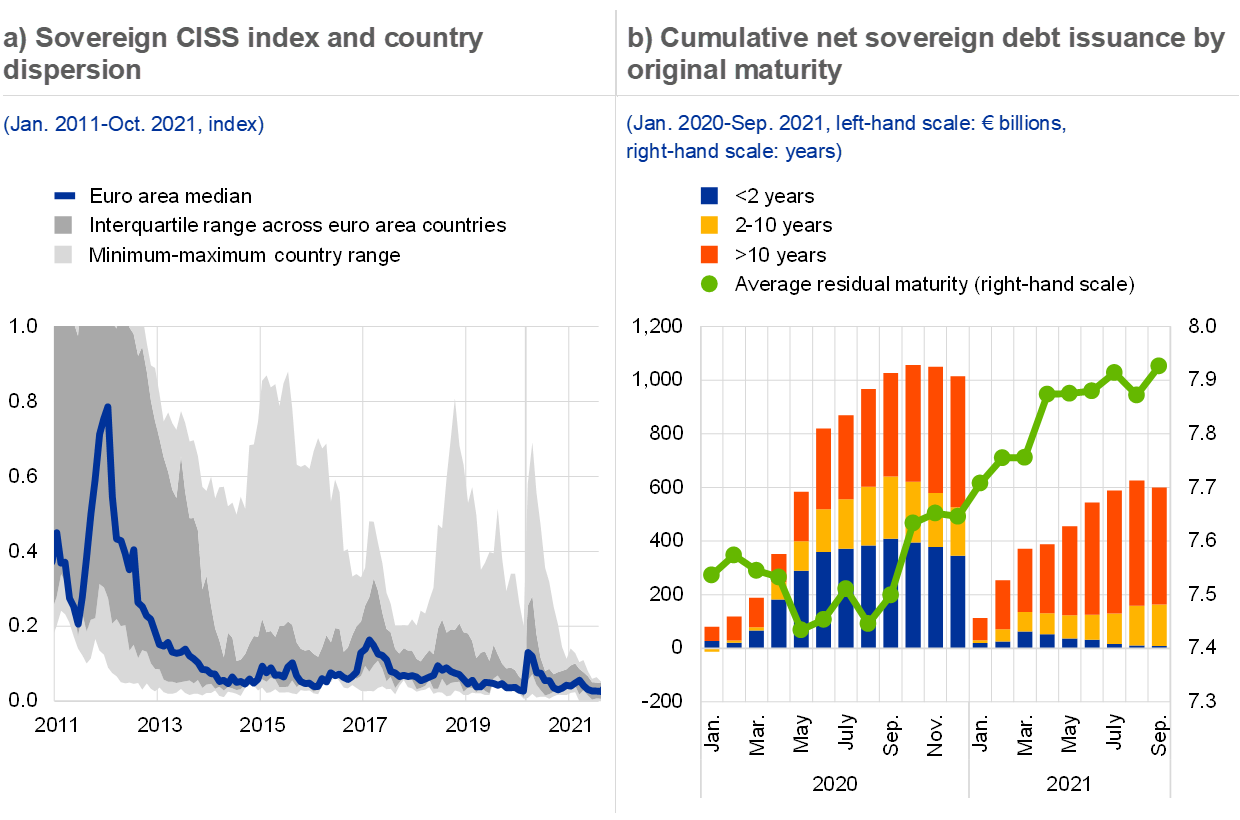
Sources: ECB and ECB government finance statistics.
Notes: Panel a: the sovereign CISS is computed for the euro area as a whole. It includes 15 raw, mainly market-based, financial stress measures that are split equally into five categories, namely the financial intermediaries sector, money markets, equity markets, bond markets and foreign exchange markets. For further details, see Holló, D., Kremer, M. and Lo Duca, M., “CISS - A composite indicator of systemic stress in the financial system”, Working Paper Series, No 1426, ECB, March 2012. Panel b: cumulative net issuance refers to the cumulative issuance of government debt securities between January 2020 and January 2021, net of redemptions.
Projected negative interest rate-growth differentials should facilitate a decline in debt levels over time, though their trajectory is surrounded by uncertainty. The economic recovery and the low interest rate environment will result in a negative interest rate-growth differential in the coming years (see Chart 1.6, panel a). As a result, debt levels are expected to decline gradually from their present level.[6] Moreover, current expectations only show marginally higher interest rate-growth differentials for higher debt countries than for lower debt countries. Historically, the relationship between a country’s debt level and its interest rate-growth differential grows stronger in times of elevated stress levels. This illustrates how the higher debt levels resulting from the pandemic could be more detrimental for government finances going forward if left unchecked (see Box 1).
The EU recovery package could improve long-term economic prospects and, therefore, sovereign debt sustainability. Moreover, positive spillovers of investments under the NGEU between euro area countries could further boost economic growth[7] and could help to sustain the recovery without national budgets being directly negatively affected[8]. Currently, most euro area governments have submitted their recovery and resilience plans for the €750 billion NGEU funding envelope: the plans are composed of grants and loans (see Chart 1.6, panel b). Countries have until August 2023 to apply for loans: not all euro area countries have requested a full allocation so far, possibly reflecting the fact that most countries currently enjoy very favourable financing conditions. In the plans submitted to date, the largest share of the funds is allocated to public administration, construction, transport and energy. This may be because governments are looking to finance projects that will promote growth, in line with the digitalisation, green transition and social objectives of the NGEU package, rather than just focusing on the sectors hardest hit by the pandemic. But as only a few countries have set out a timeline for planned spending, uncertainty surrounding actual absorption rates, and hence the effectiveness of the NGEU package, remains high.
Chart 1.6
Favourable financing conditions and the economic recovery are expected to contribute to sovereign debt sustainability
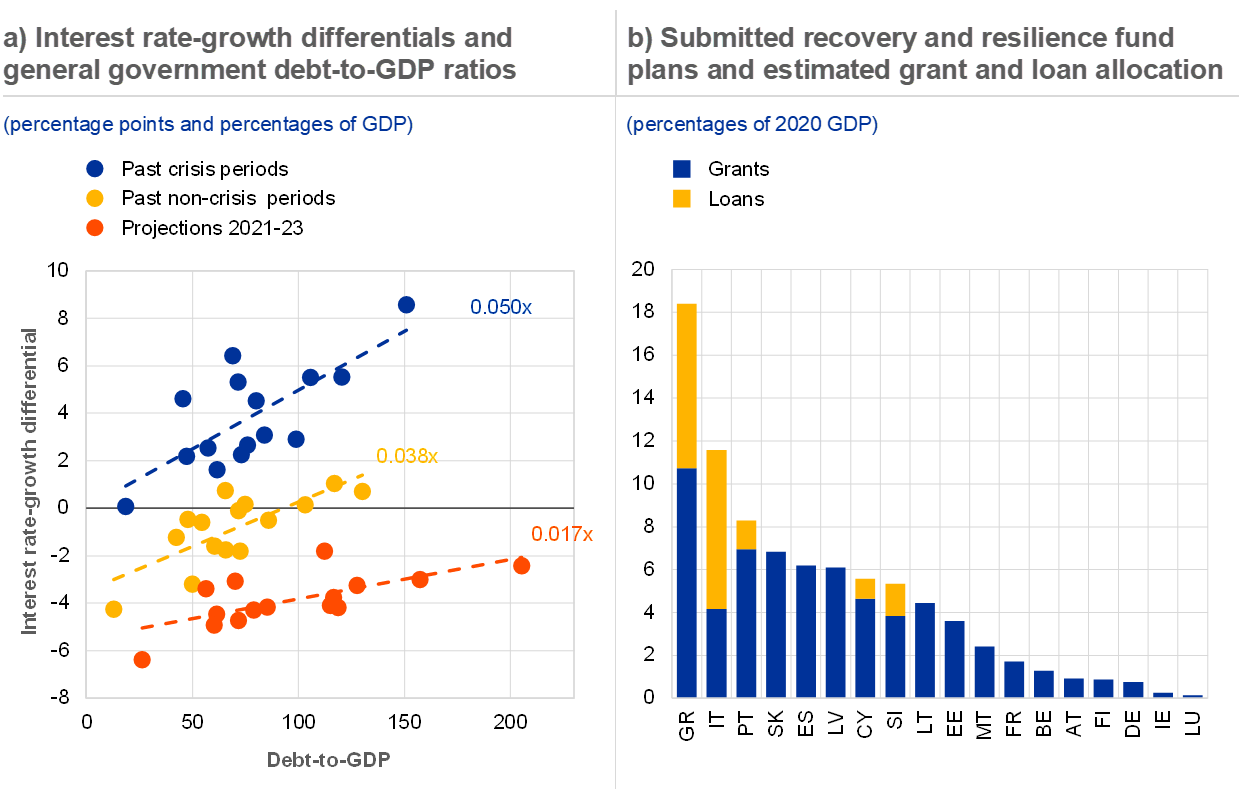
Sources: European Commission, Eurostat and ECB staff calculations.
Notes: Panel a: the interest rate-growth differential (i-g) is computed as the difference between the average nominal interest rate that governments pay on their debt (ratio of government interest payments in year t to the debt stock in t-1) and the nominal GDP growth rate. “Crisis periods” reflects the (i-g) and the debt-to-GDP ratio in 2008-09, 2011-14 and 2020; non-crisis periods are the remaining years between 2002 and 2021. Projections over the period 2021-23 are based on the September 2021 ECB macroeconomic projections. Outliers LT, LV and EE are excluded.
While favourable financing conditions mitigate short-term risks, higher debt leaves euro area sovereigns more vulnerable in the medium term. Although financing conditions have limited the impact of increased sovereign debt levels on budgets and debt servicing costs, the increased debt burden resulting from the pandemic could potentially represent a longer-lasting drag on the economy. Moreover, the sizeable increase in contingent liabilities since the start of the pandemic might weigh on government debt levels should economic growth slow. At the current juncture, the increase in sovereign indebtedness is not expected to reverse for at least another decade, and a return to less favourable financial conditions could imply less benign debt dynamics (see Box 1).
Box 1
Sensitivity of sovereign debt in the euro area to an interest rate-growth differential shock
Euro area sovereigns have issued significant amounts of new debt in response to the pandemic. As a result of this and the sizeable GDP drop, the euro area debt-to-GDP ratio increased to about 100% of GDP in 2020, above the peak of 95% reached in the aftermath of the euro area sovereign debt crisis. While the related fiscal support was crucial to limit economic scarring and aid the recovery, it has also triggered concerns about medium to longer-term debt sustainability. Sustainability risks hinge on a multitude of factors, including fiscal and economic prospects, financial market conditions, the structure of debt and institutional features.[9] A key factor among these is the interest rate-growth differential (𝑖−𝑔), also known as the “snowball effect”. If 𝑖>𝑔 a primary surplus is needed to stop the debt ratio from rising and an ever-larger surplus being needed to reduce it. Conversely, a persistently negative differential (𝑖<𝑔) would imply that debt ratios could be reduced even in the presence of primary budget deficits, as long as such deficits have a lower impact on the debt ratio than (𝑖−𝑔). This implies that projected budget balances play a key role as well: large and persistent primary deficits could prevent debt ratios from stabilising. The differential is surrounded by uncertainty related to the medium-term growth outlook and the long-term path of sovereign interest rates. Against this backdrop, this box assesses the impact of a rising (𝑖−𝑔) differential on sovereign debt ratios in the euro area.
More1.3 Households remain resilient, but pockets of vulnerabilities may emerge
Euro area households’ aggregate balance sheets have remained robust, although some uncertainty persists. The financial situation of euro area households has improved further on aggregate, with indicators of financial health signalling vulnerabilities below long-term averages (see Chart 1.7, panel a). The largest uplift comes from households’ debt servicing capacity being bolstered by lower interest payments and a high savings rate as household income was shielded by government support throughout the pandemic and containment measures limited spending opportunities. In addition, financing conditions and credit provision have remained favourable. Consumers gained confidence as vaccination campaigns accelerated and economies reopened over the summer, which has supported GDP growth (see Chart 1.7, panel b). Households further benefited from a decline in unemployment throughout the second and third quarters of 2021, with the unemployment rate of 7.4% in September back to pre-pandemic levels. With several sectors reporting labour shortages, the general outlook for employment remains positive. That said, global supply chain bottlenecks could weigh on the economic recovery, and jobs created in the hospitality and leisure sectors could be vulnerable to a renewed deterioration in the pandemic situation.
Chart 1.7
Households are benefiting from easy financial conditions, while sentiment is robust and unemployment has fallen
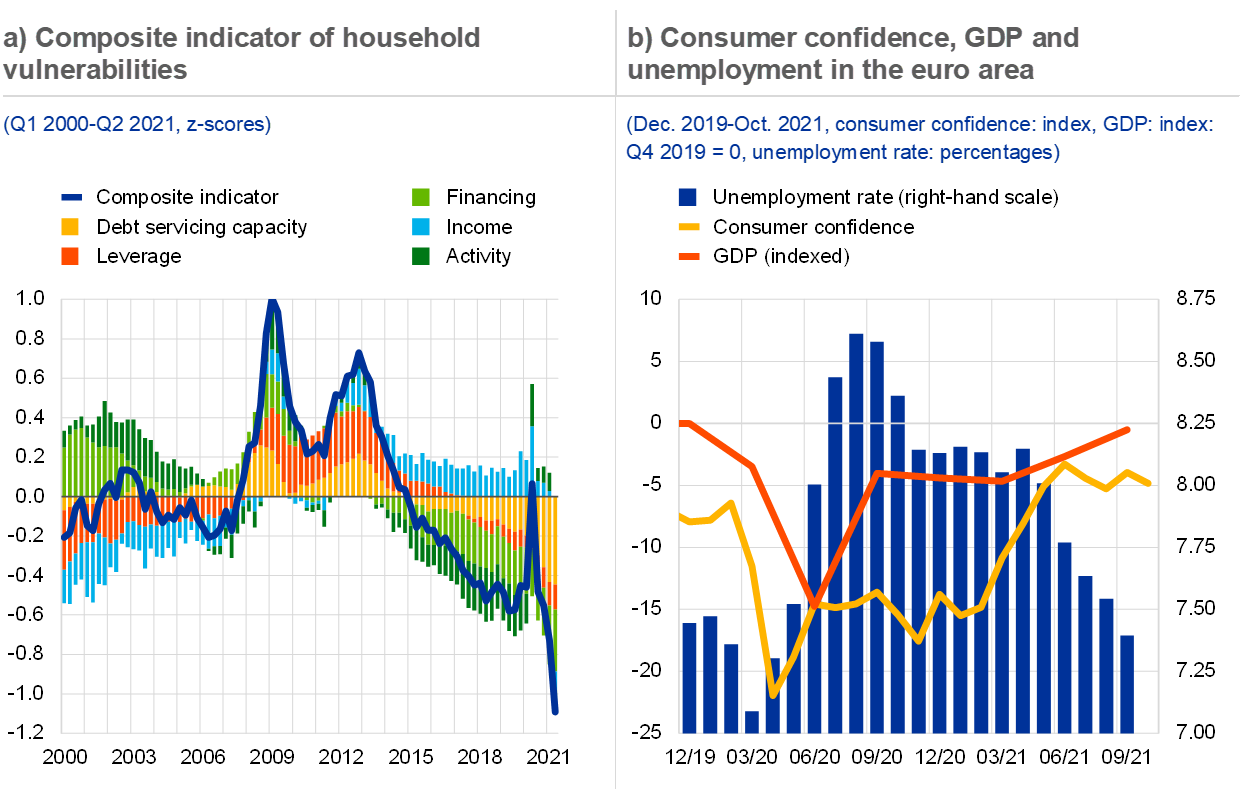
Sources: Eurostat, ECB and ECB calculations.
Notes: Panel a: the composite measure is based on a broad set of indicators along five dimensions: debt servicing capacity (measured by gross interest payments-to-income ratio, savings ratio and expectation of the financial situation); leverage (gross debt to income and gross debt-to-total assets ratios); financing (bank lending rate, short-term debt-to-long-term debt ratio, quick ratio (defined as current financial assets/current liabilities) and credit impulse (defined as the change in new credit issued as a percentage of GDP)); income (income growth and income-to-GDP ratio); and activity (labour participation rate and unemployment expectations). The indicators are standardised by transforming them into z-scores, i.e. they are converted into a common scale with a mean of zero and a standard deviation of one. Composite sub-indicators are computed for each of the five dimensions by taking the simple arithmetic average of the respective underlying z-scores of the individual indicators. Finally, the overall composite indicator is obtained by equally weighting the composite z-scores of the five sub-categories. Positive values indicate higher vulnerability, negative values lower vulnerability. Panel b: the latest observation is the third quarter 2021 for GDP growth and September 2021 for the unemployment rate.
Record savings have enhanced households’ resilience but are unevenly distributed, which may limit any additional boost to consumption. Households continued to accumulate excess savings as containment measures limited spending. Substantial parts of these are held in deposits and cash, but an increasing share is invested in less liquid financial assets like equity and investment fund shares (see Chart 1.8, panel a). Households may hold these savings for precautionary reasons, to pay down debt or in anticipation of possible price or tax rises as survey data suggest that they do not intend to increase their spending on durables beyond pre-pandemic levels, thus limiting hopes that pent-up demand would translate into higher consumption.[10] In addition, higher-income households, which tend to have a lower marginal propensity to consume, account for the highest savings. While the importance of government support schemes is receding overall, they still play a significant role in stabilising income, consumption and debt servicing capacity, especially for lower-income households that will be left vulnerable to cliff effects if support schemes are withdrawn prematurely (see Chart 1.8, panel b). Together with robust house price and stock market valuation gains, households’ net worth surged to 772% of disposable income in the second quarter of 2021 (see Section 1.5).
Chart 1.8
Excess savings are increasingly invested in illiquid assets, while lower-income households still depend on government support

Sources: Eurostat, ECB Consumer Expectations Survey (CES) and ECB calculations.
Notes: Panel a: figures shown are four-quarter trailing sums of transactions expressed as percentages of income. Panel b: expectations of government support are taken from the August 2021 CES wave, the savings rate is inferred from the July 2021 CES wave. Data cover surveys from Belgium, Germany, Spain, France, Italy and the Netherlands. The savings rate is calculated as the difference between monthly income and reported expenses on consumption divided by the monthly income, where income is inferred from income buckets. Accordingly, the data should be interpreted with caution, and mainly as an illustration of differences across different income classes.
Household debt continues to grow amid record low debt servicing costs. While the situation differs across countries, aggregate household debt grew at the highest rate in a decade – almost 4% in annual terms in the second quarter of 2021 (see Chart 1.9, panel a), mainly on the back of robust mortgage lending (see Section 1.5). Household income, on the other hand, has grown at a slower rate, increasing the debt-to-disposable income ratio to 97.9%. Record low interest rates support households’ debt servicing capacity as only around 2.2% of disposable income needs to be spent on interest payments (see Chart 1.9, panel b). In addition, the increasing share of fixed-rate loans in new credit flows makes the household sector less vulnerable to interest rate shocks going forward (see Chart 1.9, panel c). Nevertheless, should debt continue to grow faster than income, vulnerabilities could build up in the household sector.
Chart 1.9
While household indebtedness is rising, low interest rates and longer periods of interest fixation support households’ debt servicing capacity
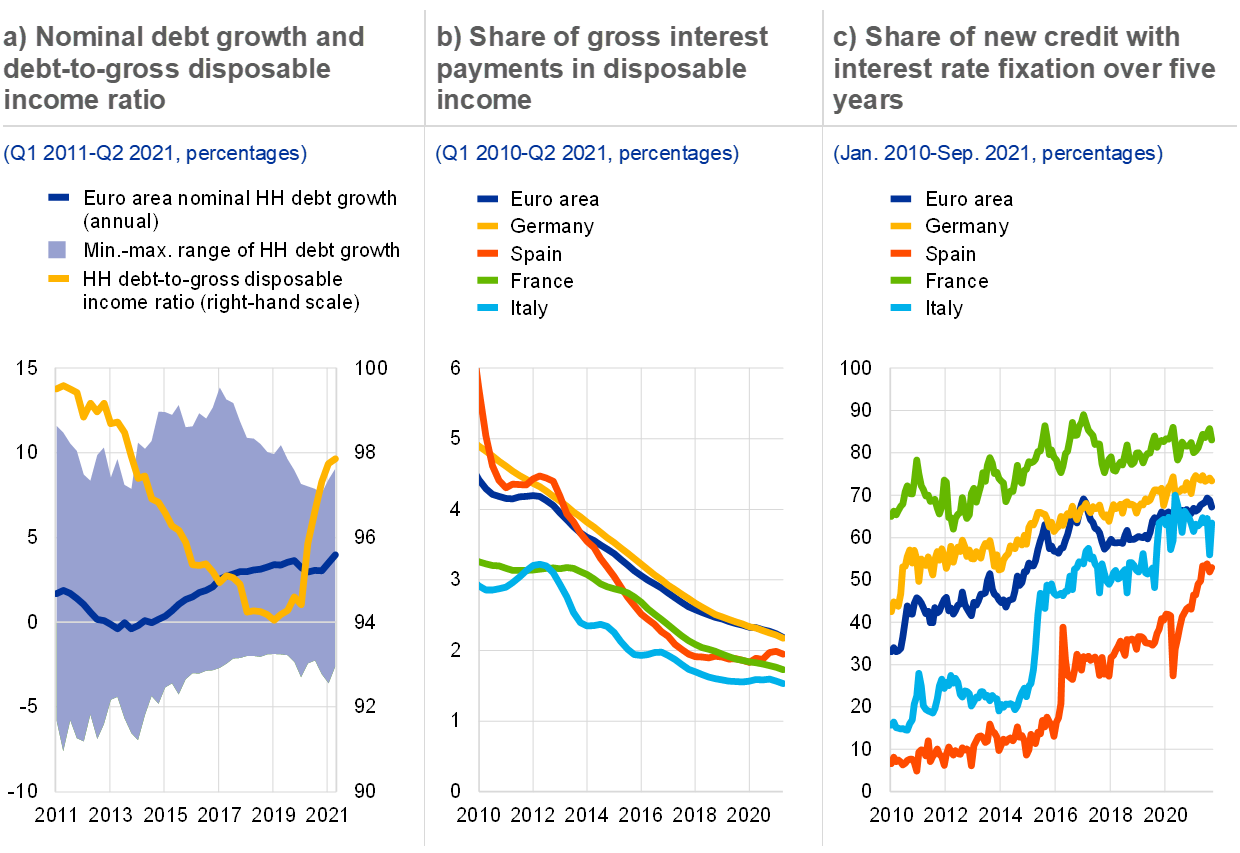
Sources: Eurostat, ECB and ECB calculations.
Notes: Panel a: annual euro area nominal HH debt growth is calculated as the four-quarter moving sum of household loan flows divided by the previous quarter’s loan stock. Panel b: interest payments are measured before allocation of financial intermediation services indirectly measured (FISIM). Panel c: share of new credit flows with initial interest rate fixation over five years of new lending to households for house purchase, consumption and other purposes, including renegotiations. HH: household.
Overall, financial stability risks stemming from the household sector remain contained, but some medium-term vulnerabilities are rising. With excess savings, robust net wealth and record low debt servicing costs, households retain their capacity to weather economic headwinds. However, lower-income households are disproportionally reliant on government support and have likely benefited less from higher financial wealth, leaving them in a potentially vulnerable position when policy support is scaled back. In addition, should higher inflation persist and households’ spending on essential goods increase, both their ability to support the broader economic recovery and their debt servicing capacity could be hurt. Concerns over household debt sustainability could rise, especially in those countries where the take-up of policy support is substantial, residential properties are overvalued and debt levels are elevated.
1.4 Corporate outlook improves, reducing near-term risks
Near-term corporate sector vulnerabilities declined as economic activity picked up. Corporate earnings showed a large, broad-based improvement in the second quarter of 2021, returning to pre-pandemic levels for listed firms, thereby alleviating solvency concerns (see Chart 1.10, panel a). Despite this marked improvement, corporates face challenges stemming from the swift pick-up in economic activity as energy prices soar, supply chain bottlenecks limit production among manufacturers and labour shortages start to weigh on the services sector, potentially slowing its recovery going forward (see Section 1.1). Moreover, profitability has lagged behind in those sectors where activity continues to be supressed by pandemic restrictions and which have experienced only a marginal improvement on their pandemic lows, such as the travel industry (see Chart 1.10, panel b). In addition, corporates will probably need a prolonged period of growth to make up for lost earnings, as backward-looking cumulative earnings are still 6.5% below pre-pandemic levels.
Chart 1.10
Earnings rebounded from pandemic lows for most sectors, but not all
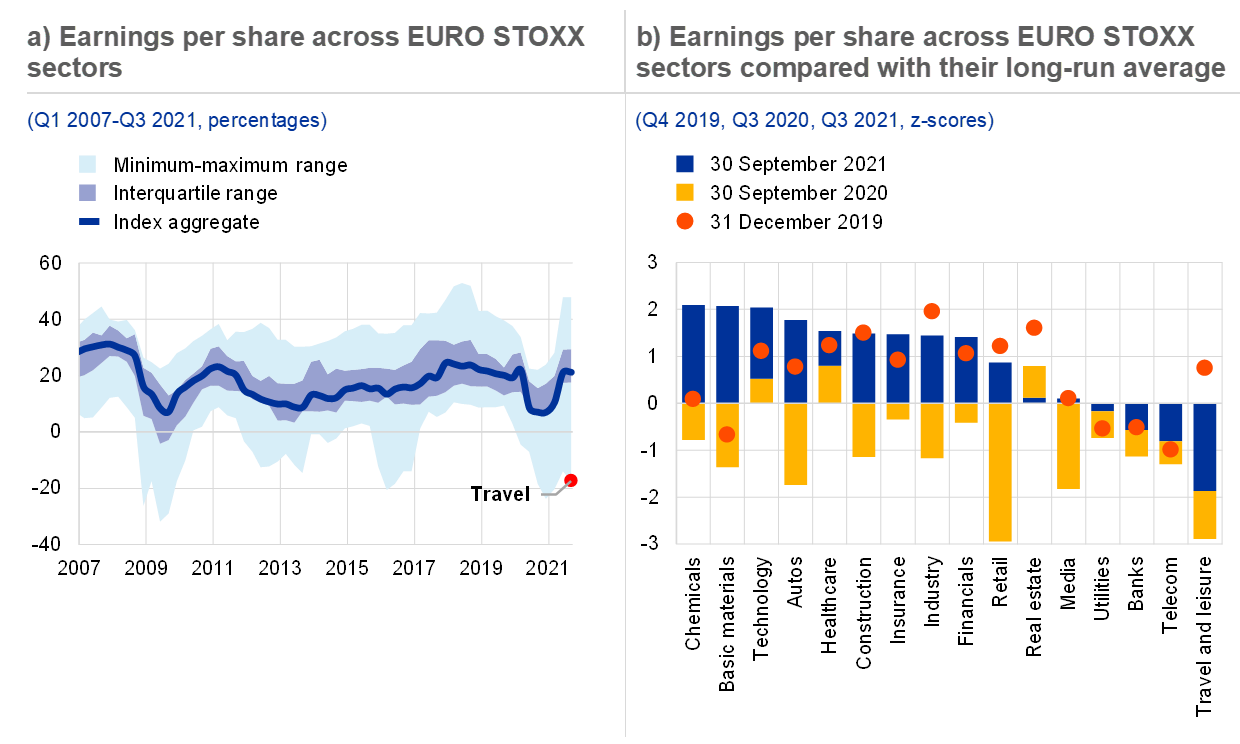
Sources: Bloomberg Finance L.P., ECB and ECB calculations.
Notes: Panel a: sample consists of the EURO STOXX sectors chemicals, basic materials, technology, autos, healthcare, construction, insurance, industry, financials, retail, real estate, media, utilities, banks, telecom, and travel and leisure. Panel b: Bloomberg best earnings estimates. z-score calculated over the reference period Q1 2007-Q3 2021.
Insolvencies remain strikingly subdued, although they have materialised in some of the sectors most affected by the pandemic. On aggregate, the level of insolvencies in the euro area remained 15% below pre-pandemic levels in the second quarter of 2021. However, more granular data show that insolvencies have risen in those sectors hardest hit by the pandemic (e.g. in the accommodation and education sectors). At the same time, the swift economic recovery makes it unlikely that insolvency numbers will rise to match earlier private sector projections (see Chart 1.11, panel a). Policy support measures as well as the suspension of the obligation to file for insolvency have likely prevented the large-scale materialisation of additional bankruptcies. However, assessing corporate viability remains challenging in the light of the post-pandemic prospects for different business models. This is also signalled by the balance of positive and negative rating outlooks for companies with a credit rating, as many firms are still at risk of a credit rating downgrade (see Chart 1.11, panel b). As such, insolvencies and bond defaults could still pick up if less favourable economic outturns were to materialise.
Chart 1.11
Insolvencies remain subdued in most countries, although the outlook remains challenging for many corporations
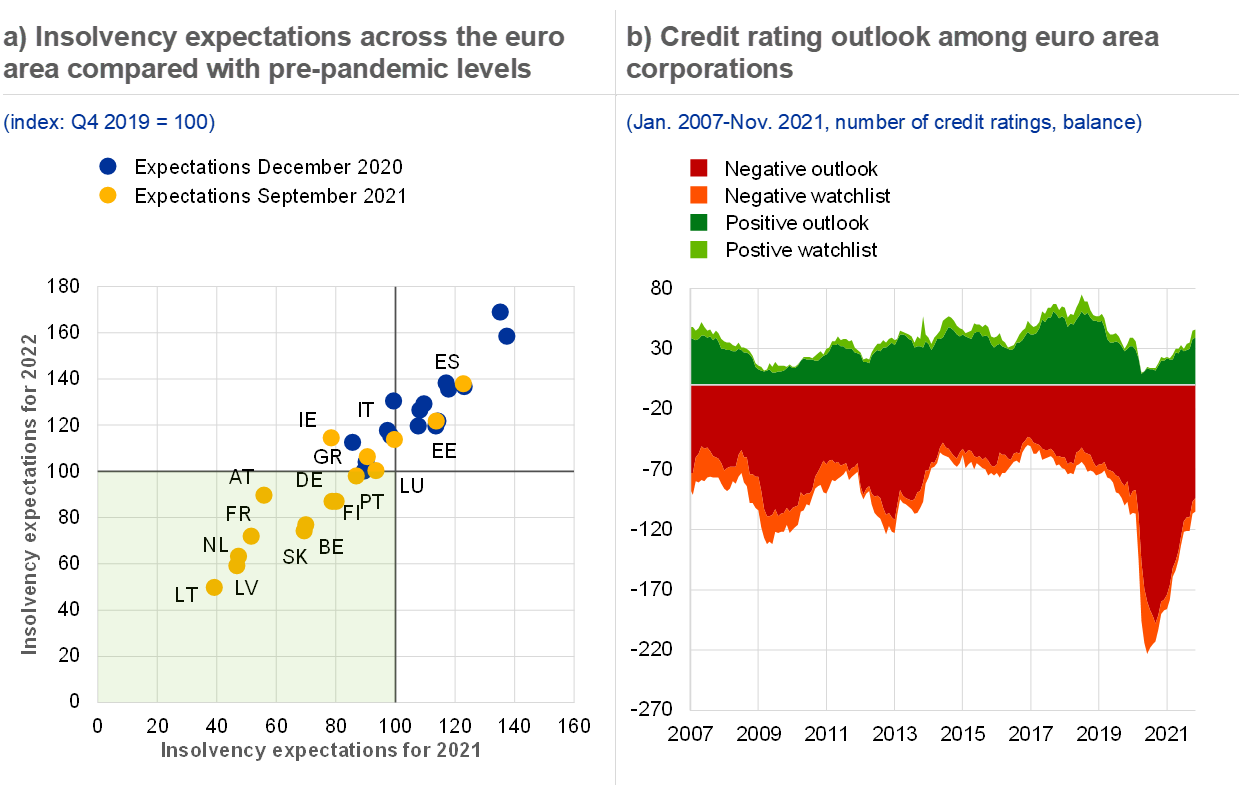
Sources: Euler Hermes (Allianz Research), ECB calculations and Moody’s Analytics.
Notes: Panel a: insolvency statistics and projections are taken from “Insolvencies: we’ll be back”, Euler Hermes (Allianz Research), 6 October 2021 for September 2021 expectations and “Vaccine Economics”, Euler Hermes (Allianz Research), 18 December 2020 for December 2020 expectations. Panel b: the number of negative outlook and negative watchlist ratings is inverted.
Corporate credit growth increased moderately, reflecting large liquidity buffers and improving economic activity. Demand for bank loans increased in the third quarter of 2021 on account of slightly higher fixed investment, debt refinancing needs and financing needs for inventories and working capital (see Chart 1.12, panel a). However, non-financial firms built up significant liquidity buffers, with gross debt remaining elevated, while net debt declined to below pre-pandemic levels, contributing negatively to the demand for new loans. This largely reflects the position of large listed corporates, whereas SMEs were more heavily affected by the pandemic and are less likely to have access to market-based funding, resulting in lower cash buffers. Finally, large firms also partially replaced borrowing from banks with market-based debt to benefit from favourable market conditions. Going forward, banks expect a small net increase in demand for loans to firms (see Chart 1.12, panel a).
Although demand for liquidity declined, guaranteed loans still account for a non-negligible share of new loan origination in some countries. Guaranteed loans still make up between 5% and 10% of new loan origination in Italy and Spain. Public guarantee schemes play a less material role in other euro area countries. Moreover, the results of the ECB’s bank lending survey indicate that demand for guaranteed lending has started to decline among large and small and medium sized enterprises, reflecting lower demand amid broadly unchanged lending standards (see Chart 1.12, panel b). Unless it is decided to prolong them further, national guarantee programmes are generally expected to wind down at the end of 2021. As they still attract sizeable demand in some countries, there is a risk that their termination could lead to an unwarranted tightening of lending conditions and lower credit volumes, which could weigh on the economic recovery in those countries where the share of guaranteed lending remains significant.
Chart 1.12
Corporate loan demand increased moderately as debt accumulated in some sectors
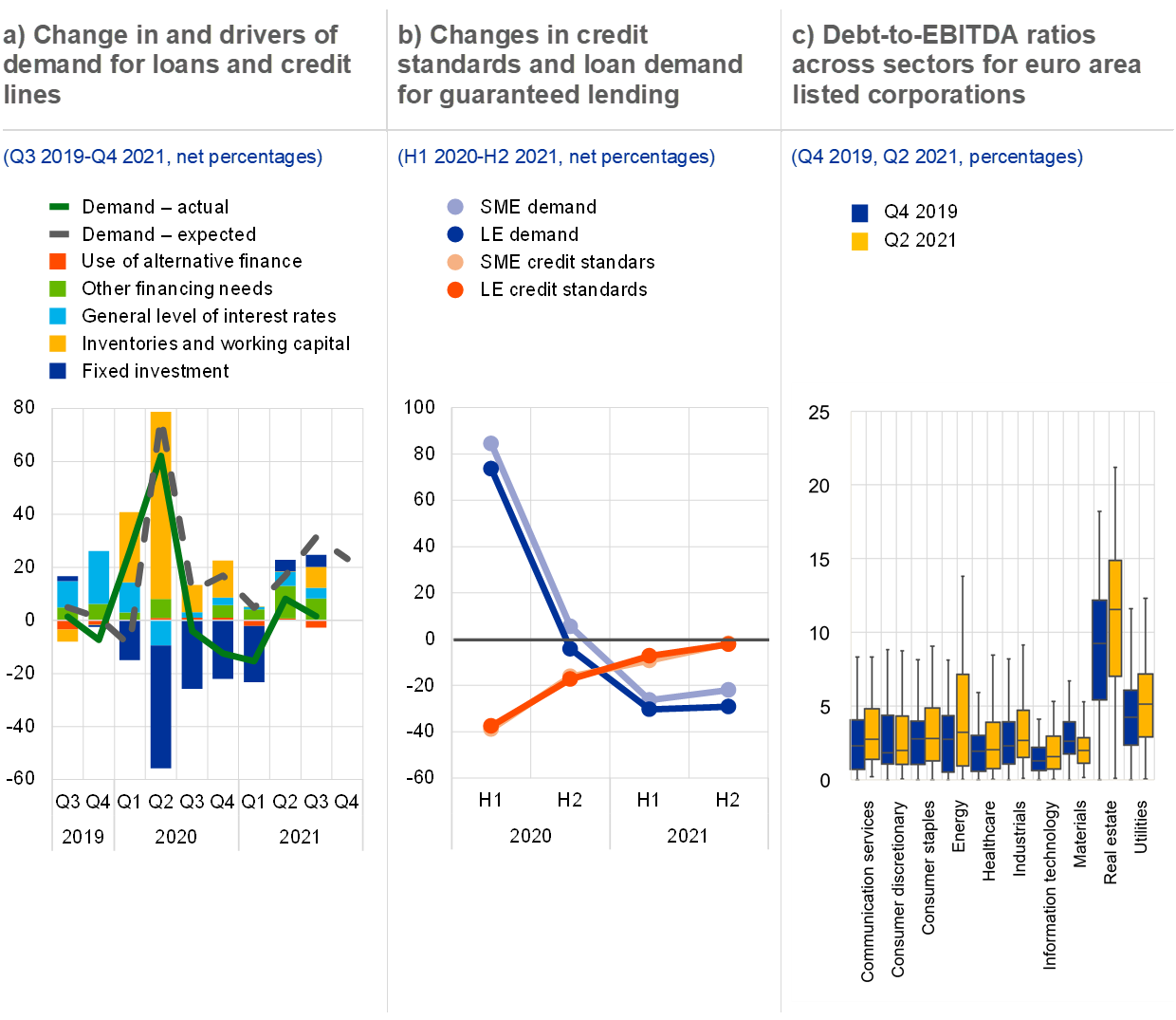
Sources: Eurostat, ECB, ECB bank lending survey and S&P Capital IQ.
Notes: Panel a: “actual” values are changes that have occurred, while “expected” values are changes anticipated by banks. Net percentages for the questions on demand for loans are defined as the difference between the sum of the percentages of banks that responded “increased considerably” and “increased somewhat” and the sum of the percentages of banks that responded “decreased somewhat” and “decreased considerably”. Panel b: the net percentage refers to the difference between the sum of the percentages for “tightened considerably” and “tightened somewhat” and the sum of the percentages for “eased somewhat” and “eased considerably”. Data for H2 2021 reflect six-month forward expectations as indicated by banks in the Q2 2021 round of the bank lending survey. SME: small and medium sized enterprises, LE: large enterprises. Panel c: a fixed sample of 1,057 euro area non-financial corporations with total assets larger than €50 million as at Q3 2019; data available for Q2 2021 are used. Whiskers reflect the 10th and 90th percentile of the distribution across corporations.
Longer-term corporate sector vulnerabilities remain elevated, despite the improvement in economic prospects compared with the spring. On aggregate, corporate debt levels declined to 115% of GDP in the second quarter of 2021 from 119% of GDP in the first quarter of 2021 as the economy recovered.[11] However, pockets of highly indebted companies have so far not succeeded in bringing their debt levels down (see Chart 1.12, panel c). These firms are more likely to encounter permanent scarring and remain vulnerable to a further scaling back of support measures. Moreover, highly indebted firms are also likely to run at lower levels of investment and employment,[12] which could represent a longer-term drag on the euro area economy. Adding further to these vulnerabilities, highly-indebted firms applied for guaranteed loans and moratoria in greater numbers than did companies with a lower level of indebtedness (see Chapter 3). While this mitigated the short-term impact of the pandemic, the sizeable uptake in guaranteed lending in some countries could weigh on sovereign debt sustainability if the economic recovery is weaker than anticipated or if financial conditions deteriorate.
1.5 Vulnerabilities are growing in euro area property markets
Euro area residential real estate (RRE) prices showed robust growth throughout the first half of 2021. Nominal house prices grew at 7.3% at the euro area aggregate level in the second quarter of 2021 – the fastest rate observed since 2005 (see Chart 1.13, panel a). Policy measures have helped to maintain household incomes during the pandemic, while favourable financing conditions have allowed households to obtain financing for house purchase at record low interest rates (see Chart 1.13, panel a). Together with a possible preference for more living space as people worked from home, this fuelled demand for housing during the pandemic. Despite the recovery in residential construction, labour shortages, global supply chain bottlenecks and input price increases are weighing on the construction sector’s ability to expand housing supply, which is putting upward pressure on house prices.[13] Rents have not followed the strong increases in house prices in most countries, which may partly reflect regulations in many rental markets.
Medium-term vulnerabilities in euro area residential property markets have continued to build up. While short-term risks have declined markedly since the height of the pandemic as financial conditions have eased, risks of price corrections over the medium term have increased substantially (see Chart 1.13, panel b) amid rising estimates of house price overvaluations. As price and lending dynamics are outpacing household income growth, household indebtedness and RRE overvaluation are increasing (see Chart 1.14, panel a), adding to the build-up of medium-term vulnerabilities and concerns over a debt-fuelled housing bubble. In particular, households with variable rate mortgages or shorter fixed-rate periods on their mortgages are exposed to an unexpected rise in interest rates, which could adversely affect their ability to service their debt (see Section 1.3).
Chart 1.13
Euro area residential property prices continue rising, increasing medium-term risks

Sources: ECB and ECB calculations.
Notes: Panel a: the latest observation for RRE price growth is for the second quarter of 2021. The y-axis is truncated to make the main series more readable. Panel b: results from a house price-at-risk model based on a panel quantile regression on a sample of 19 euro area countries over the period from the first quarter of 1999 to the first quarter of 2021. Explanatory variables: lag of real house price growth, overvaluation (average of deviation of house price-to-income ratio from long-term average and econometric model), systemic risk indicator, consumer confidence indicator, financial market conditions indicator capturing stock price growth and volatility, government bond spread, slope of yield curve, euro area non-financial corporate bond spread, and an interaction of overvaluation and a financial conditions index.
House price and lending dynamics have been much stronger in many of the countries with pre-existing vulnerabilities. House prices have generally risen more in countries which had stretched valuations prior to the pandemic (see Chart 1.14, panel b), resulting in further increases in estimated overvaluation. Coupled with higher mortgage lending growth in some countries where households face higher debt levels (see Chart 5, panel b, in the Overview), the risks of a price correction and the build-up of vulnerabilities appear unevenly spread across euro area countries. Particularly notable are developments in countries that had already received a warning or recommendation from the European Systemic Risk Board (ESRB). This has strengthened the case for considering activating further macroprudential policy measures (see Chapter 5). Lending standards like loan-to-income and loan-to-value ratios had eased prior to the pandemic and there is some indication that they have eased further, adding to concerns about household and bank resilience going forward (see Chart 5.1 in Chapter 5).[14]
Chart 1.14
Estimates of house price overvaluation have been rising alongside prices, particularly for some countries

Sources: ECB and ECB calculations.
Notes: Both panels: the average valuation estimate is the simple average of the price-to-income ratio and an estimated Bayesian vector autoregression (BVAR) model. For details of the methodology, see Box 3 in Financial Stability Review, ECB, June 2011, and Box 3 in Financial Stability Review, ECB, November 2015. Overall, estimates from the valuation models are subject to considerable uncertainty and should be interpreted with caution. Alternative valuation measures can point to lower/higher estimates of overvaluation. Panel a: the range of valuation estimates is based on four different valuation methods: the price-to-rent ratio, the price-to-income ratio, an asset pricing approach and an estimated BVAR model. Panel b: red and yellow dots indicate countries that received an ESRB warning or recommendation respectively in September 2019. The red horizontal and vertical lines indicate the euro area aggregate. Given that Q2 2021 RRE price growth is not yet available, Q1 2021 data are shown for Ireland and Finland and Q4 2020 data for Cyprus.
Commercial real estate (CRE) markets started to recover following marked declines during the pandemic, but the outlook for the non-prime segment remains poor. While overall market sentiment has improved in tandem with the wider economy, an elevated share of investors still sees the market in a downturn (see Chart 1.15, panel a). Recent market intelligence suggests that this downturn is particularly pronounced for the lower-quality end of CRE markets. Pandemic-related experience with remote working, health concerns and stronger demand for more environmentally friendly buildings may move demand towards modern, high-quality office spaces over the medium term. The shift towards e-commerce may also have an outsized impact on lower-quality retail space. This division is clearly visible in survey data which show that investors expect rents for non-prime office and retail properties to decrease strongly over the next 12 months (see Chart 1.15, panel b). Should these trends prove to be lasting structural changes, non-prime segments could face risks of pronounced market corrections.
A sustained decline in CRE markets could feed through the wider financial system and negatively affect the real economy. The financial system is exposed to a deterioration in CRE prices via increased credit risk, decreased collateral values and losses on direct holdings. Transaction data show that over the five year period preceding the pandemic, euro area insurance corporations and pension funds, investment funds and non-financial corporations (NFCs) predominantly purchased non-prime retail and office properties (see Chart 1.15, panel c), suggesting that exposures to the most vulnerable CRE asset types could be substantial. In addition, banks in some countries have high exposures to CRE via loan purposes and collateral. A significant drop in CRE prices and the associated reduction of collateral values could hamper NFCs’ access to finance and thus result in lower scope for investment and economic activity. Other market participants, such as investment funds faced with redemption pressure, could behave procyclically and amplify the price decline, thereby exacerbating negative feedback loops.
Chart 1.15
Conditions in CRE markets have improved somewhat, in tandem with the wider real economy, but the outlook for lower-quality buildings remains poor
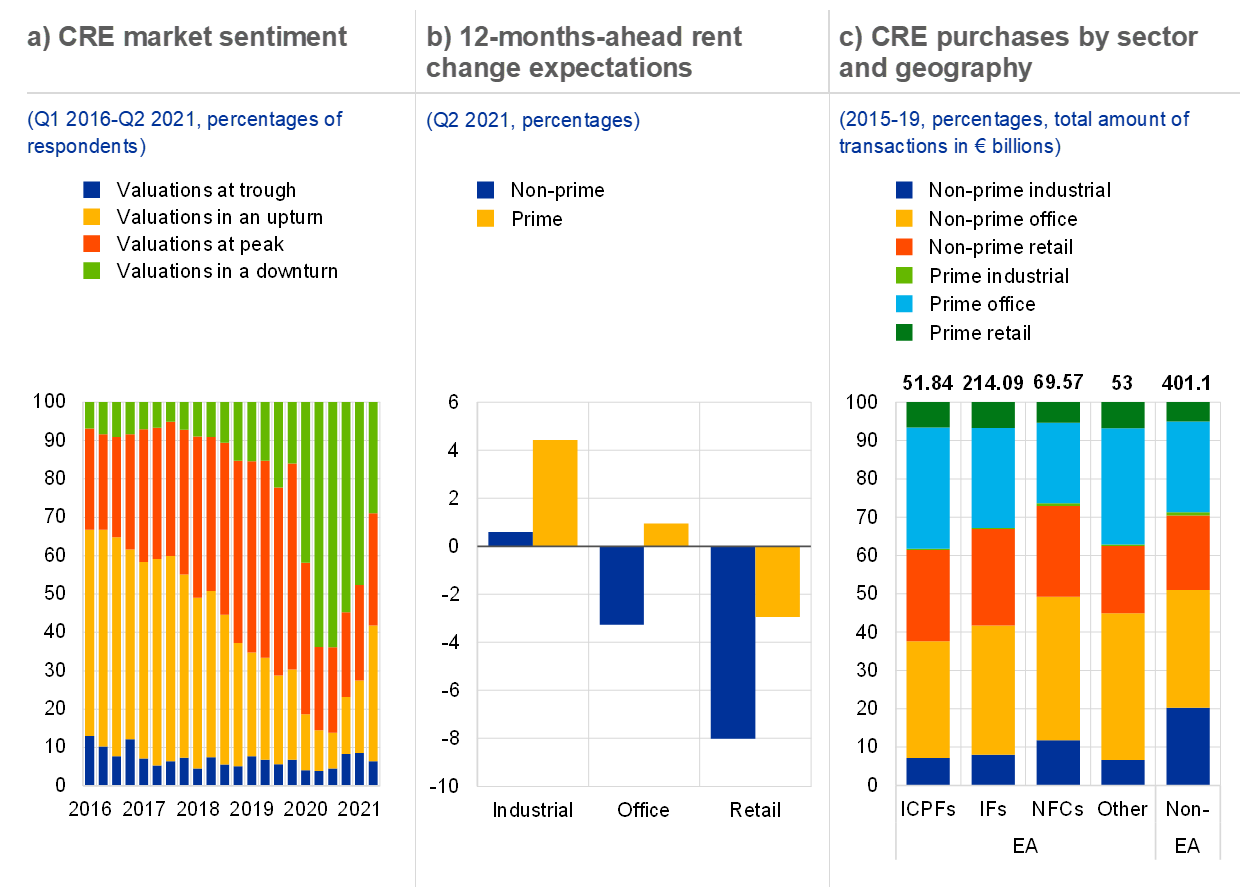
Sources: RICS, Real Capital Analysis and ECB calculations.
Notes: Panel a: chart shows percentage shares of survey respondents perceiving the current phase of the property cycle to be at a trough, in an upturn, at a peak or in a downturn respectively. Panel c: numbers reported at the top of the chart are aggregated transaction values in billions of euro. ICPFs: insurance corporations and pension funds, IFs: investment funds, NFCs: non-financial corporations, EA: euro area.
Risks to financial stability stemming from real estate markets remain elevated and have increased for the medium-term horizon. A sharper than expected decline, particularly in lower-quality CRE valuations, might set off negative economic feedback loops. In residential property markets, while credit dynamics and household balance sheet vulnerabilities look less concerning than in the run up to the global financial crisis, buoyant expansion of RRE prices and a sense of deteriorating lending standards may warrant monitoring going forward (see Box 2). Against this background, the financial sector may be exposed to the risk of real estate market corrections, especially in those countries where debt levels are elevated, exposures are high and properties are overvalued.
Box 2
Assessing the strength of the recent residential real estate expansion
Credit-fuelled residential real estate booms can pose major risks to financial stability. Residential real estate (RRE) booms and busts have frequently been associated with deep recessions and financial crises, especially when the RRE boom is fuelled by debt.[15] The real estate bubble in the United States ahead of the global financial crisis (GFC) is possibly the most prominent recent example. In a boom, a feedback loop of rising prices and rising credit growth can result in a later correction of overvalued RRE prices affecting the economy and financial system through several channels. A collapse in RRE prices can weigh on household expenditure via wealth effects and/or confidence. High household indebtedness can further contribute to a reduction in consumption and can lead to defaults on loans if debts prove unsustainable. Investment and corporate loans can be impaired if the RRE price boom has been accompanied by a twin construction boom. Finally, the bursting of a real estate bubble can severely affect the credit supply and amplify the downturn as the value of available collateral shrinks and losses impair banks’ intermediation capacity.[16]
More2 Financial markets

2.1 Real yields fall due to risks of higher inflation and slower global recovery
Financial market pricing has adjusted in recent months for a continued but slower global recovery amid increasing supply-side constraints and surging energy prices. During the first half of 2021, markets were dominated by positive risk sentiment following the November 2020 news on the development of COVID-19 vaccines. As the recovery unfolded and economic data surprised on the upside (see Chart 2.1, panel a), markets started to focus on emerging global inflationary pressures and the implications of increasing yields. Over the course of the summer, however, disappointing economic data and concerns about the Delta variant of the coronavirus started to adversely affect market sentiment. The global economic recovery has continued, but momentum has slowed and risks are skewed to the downside.[17] Despite the slowdown in global growth dynamics, inflationary pressures have persisted, driven in part by supply-side constraints and surging energy prices (see Chart 2.3, panel a). Although inflationary pressures in the euro area are expected to decline in the course of next year, recent inflation surprises, notably in the US, have led a growing number of market participants to see risks that higher inflation rates last for a more extended period. The market-implied probability for “high inflation scenarios” remains relatively subdued for the euro area, but has risen sharply for the United States (see Chart 2.1, panel b). At the same time, market prices now imply a very low probability for scenarios of very low inflation (below 1%) or deflation.
Chart 2.1
Economic data start to disappoint as we enter a new phase of the recovery

Sources: Citigroup, ECB Statistical Data Warehouse and Bloomberg Finance L.P. and ECB calculations.
Notes: Panel a: negative values of the Citigroup Economic Surprise Index point to disappointing economic data as performance was lower than expected. Panel b: probabilities implied by five-year zero-coupon inflation options, averaged over five business days. Risk-neutral probabilities may differ significantly from true probabilities. “Headline” refers to headline inflation.
Inflationary pressures and risks to the strength of the economic recovery drove real yields to all-time lows, incentivising risk-taking. Between the publication of the May 2021 FSR and August of this year, nominal yields declined and global yield curves flattened, reflecting the perception that growth momentum had reached its peak (see Chart 2.2, panel a). Real yields fell to all-time lows (see Chart 2.2, panel b) and remained low even after nominal yields rebounded in August. Lower real yields have incentivised risk-taking in financial markets, despite growing risks. In September, equity indices reached record highs in the United States and various euro area countries. Increased risk-taking does not necessarily imply that growing risks do not lead to any downward adjustment of market pricing; equity markets declined over the course of September in response to concerns about rising inflationary pressures, supply bottlenecks and problems at the large Chinese property developer Evergrande. Markets rebounded relatively quickly; this reflects the continued strong risk appetite. In an inflationary environment, equities may also be more attractive than fixed income products, as the coupon payments on nominal bonds do not offer protection against inflation.
Nominal yields rebounded in August, driven by the inflation component, and may be sensitive to market participants’ expectations around policy normalisation going forward. Potential drivers of bond yield dynamics include the evolution of inflation dynamics, the strength of the recovery and market participants’ anticipation of policy normalisation.[18] Recent nominal yield increases happened in the context of a perceived slowdown in the global recovery and were driven by the inflation component as supply-side constraints intensified and energy prices surged. Market participants also focus on central banks’ reaction functions to these inflationary pressures. Adjustments of market participants’ expectations can lead to volatility in bond markets, whereby cross border spillovers can also affect euro area bond markets.
Chart 2.2
Real yields fell to all-time lows as inflation premia continued to rise
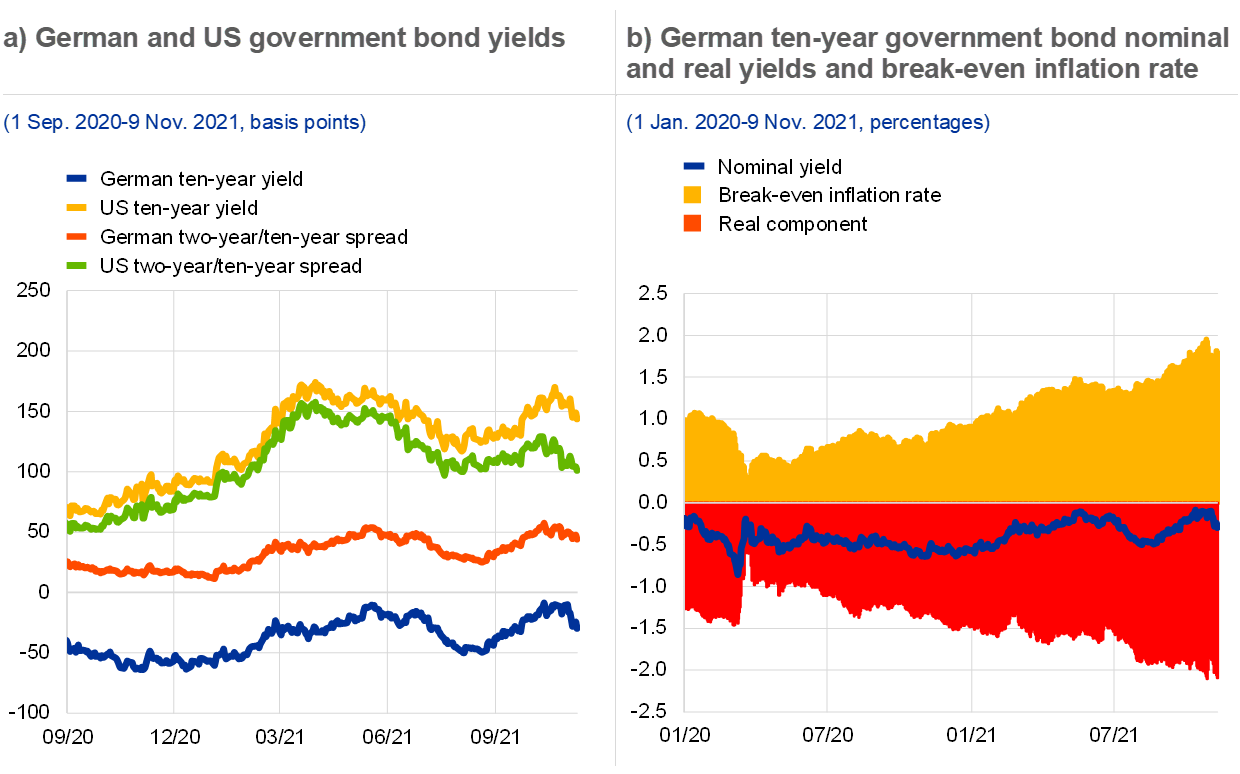
Sources: Bloomberg Finance L.P. and ECB calculations.
The sharp increase in energy commodity prices contributes to inflationary pressures and poses wider risks to the recovery and to markets. The second half of 2021 has seen sharp increases in energy commodity prices due to insufficient supply in combination with low reserves, especially in Europe (see Chart 2.3, panel a). Surging prices affect industries that rely heavily on these commodities, can have a negative impact on growth and can weigh on market confidence. Corporate defaults may be triggered in the event of unhedged exposures. Carbon prices have increased in tandem with the demand for energy commodities.
Financial markets also reflect a growing divergence between emerging and developed economies. Emerging market equities started to underperform global equities over the course of 2021 (see Chart 2.3, panel b). To some extent, this may be attributed to relatively low vaccination rates in some emerging markets.[19] The impact of the emerging market slowdown on developed economies is twofold: first, adverse developments in emerging markets can lead to spillovers through a decline in global demand; and second, emerging markets play a key role in global supply chains, and disruptions may further fuel inflationary pressures in developed economies.
Chart 2.3
Energy commodity prices surge, while emerging and developed markets diverge

Sources: Bloomberg Finance L.P. and ECB calculations.
Notes: Panel a: percentage price change of first futures contract since January 2020. “Europe coal” refers to Rotterdam Coal Futures. “Europe natural gas” refers to UK Natural Gas Futures. “United States natural gas” refers to futures with delivery at the Henry Hub in Louisiana.
Emerging market underperformance has, in part, been driven by developments in China. The relative underperformance of emerging markets cannot entirely be attributed to the impact of the vaccine roll-out and the Delta variant. Actions by Chinese authorities are having a profound impact on China’s technology, education and real estate sectors (see Chart 2.3, panel b, and Section 1.1). To date, bouts of volatility in Chinese high-yield credit markets following problems with the property developer Evergrande have not led to significant spillovers to global markets, as direct exposures are limited. An economic downturn in China may, however, adversely affect developed markets via global demand. So far, tensions were largely contained to the (“off-shore”) market for Chinese dollar-denominated high-yield bonds. Some Chinese firms with a speculative grade rating may struggle to refinance their dollar-denominated debt, while a number of investment grade firms might be vulnerable to rating downgrades to high yield.
2.2 The pandemic scars of debt and duration form long-lasting vulnerabilities in markets
Increased debt leaves the financial system more vulnerable to credit risk. Government, corporate and household debt have increased over the course of the pandemic (see Chart 2.4, panel a, and Section 1.4). Borrowers’ ability to service this debt is contingent on low financing costs and also depends on the strength of the economy (see Chapter 1). These dependencies not only increase the economy’s vulnerability to a deterioration in financial conditions, but can in turn also cause financial market conditions to respond more strongly to unforeseen adverse shocks.
Increased duration leaves markets and financial intermediaries more exposed to upward shocks to interest rates.[20] Over the past decade, the duration of euro area fixed income securities has increased, most notably for bonds issued by sovereigns and sub-sovereigns (see Chart 2.4, panel b). The duration of a bond increases mechanically when yields decline,[21] but issuers have also increased the maturity of newly issued securities in the context of lower rates and flatter curves.[22] As a consequence of the increase in duration and overall debt, losses associated with a given increase in underlying yields have now reached historically high levels (see Chart 2.4, panel c). Increased sensitivity to rates could be destabilising in the event of a material interest rate shock.[23] Open-ended bond funds may also exacerbate such a shock, as redemptions could trigger forced sales (see Chapter 4).
Equity markets also appear to have become more sensitive to interest rates. Price-to-dividend ratios for the EURO STOXX index have increased by almost 60% between 2017 and 2021 (see Chart 2.4, panel b). Shares with a higher price-to-dividend ratio are generally more sensitive to interest rate changes.[24] Corporate leverage provides a second channel through which equities have become more sensitive to interest rates, as higher debt levels per unit of earnings leave the latter more sensitive to the cost of debt. Corporate leverage measured as debt/EBITDA[25] has risen during the pandemic (see Chart 2.6, panel a), and the firms in the upper tail still show elevated leverage above pre-pandemic levels. Leverage also increased during the global financial crisis and remained elevated even after earnings recovered. The long-term impact of the pandemic on corporate balance sheets remains to be seen (see Chapter 1). The sensitivity of equity valuations to interest rates through the inflation component is somewhat ambiguous, as some firms may be able to increase earnings by raising the prices of their products.
Chart 2.4
The pandemic has inflicted lasting scars on debt and duration
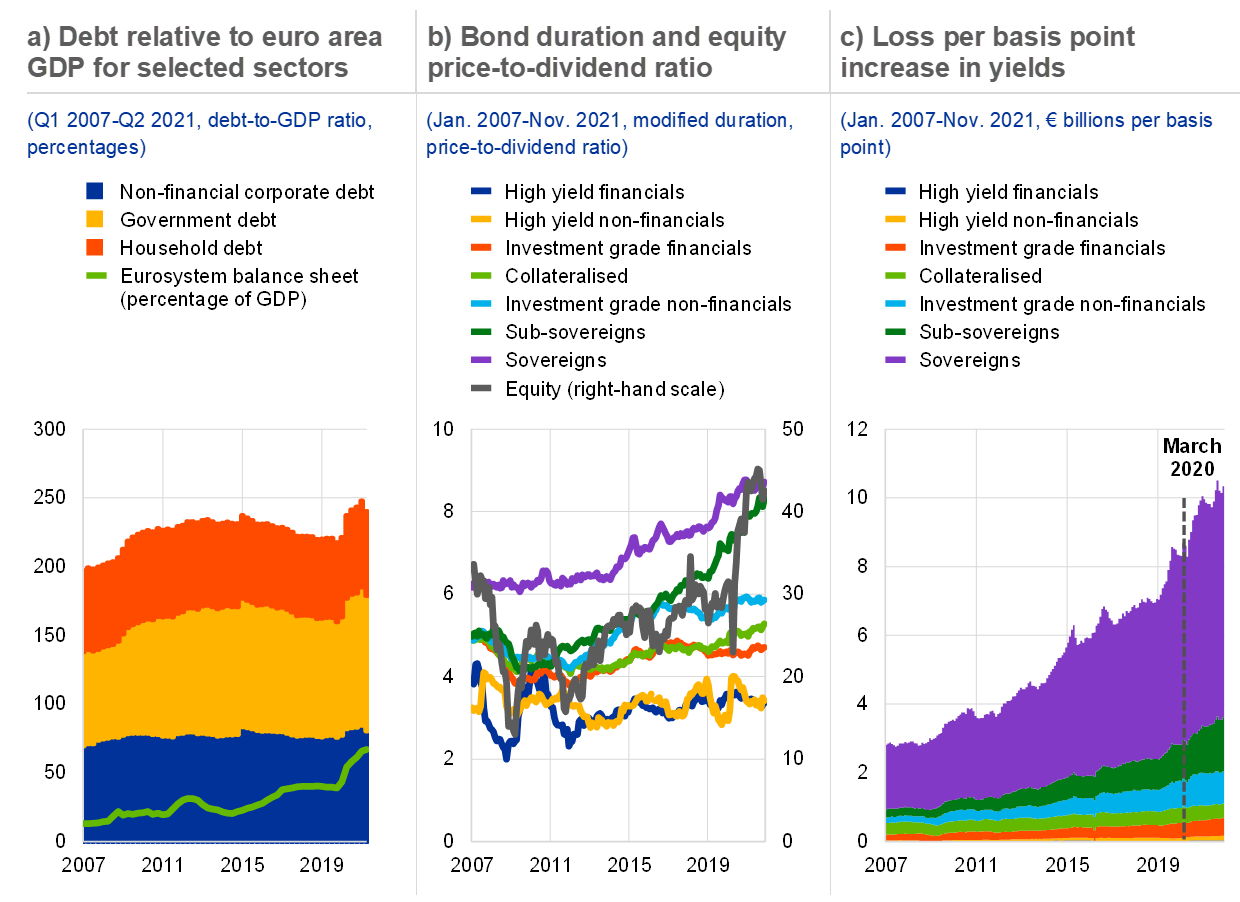
Sources: ECB Statistical Data Warehouse, IHS Markit, Refinitiv and ECB calculations.
Notes: Panel a: non-financial corporate and government debt are on a consolidated basis. Household debt is unconsolidated. The increase in the debt-to-GDP ratio is partially – but not completely – driven by the fall in GDP. Panel b: equity duration is proxied by the price-to-dividend ratio. In a single-stage Gordon Growth Model, the duration of equities would be identical to the price-to-dividend ratio.
Financing costs have remained low despite large debt issuance, but may come under pressure. The Eurosystem has expanded its balance sheet by around €3.7 trillion since the start of the pandemic (see Chart 2.4, panel a), helping to safeguard favourable financing conditions despite newly issued “pandemic debt”. Between March 2020 and September 2021, net purchases of public sector securities under the asset purchase programme (APP) and the pandemic emergency purchase programme (PEPP) surpassed the net issuance by euro area governments and European institutions (see Chart 2.5, panel b). Together with fiscal support, this has helped economies to overcome the pandemic-related crisis, but also poses challenges as the recovery takes hold and policy support is scaled back.
Successful issuances of Next Generation EU (NGEU) bonds and bills have contributed to governments’ ability to support the recovery. Investor demand for newly issued NGEU and SURE (Support to mitigate Unemployment Risks in an Emergency) bonds has been strong, and spreads relative to German government bonds have narrowed since the first SURE issuance in October 2020 (see Chart 2.5, panel c). EU spreads stand well below those of the bonds issued by some of the Member States with a considerable take-up of NGEU funds (see Chapter 1).
Chart 2.5
Government debt has grown, but SURE issuance has been a success
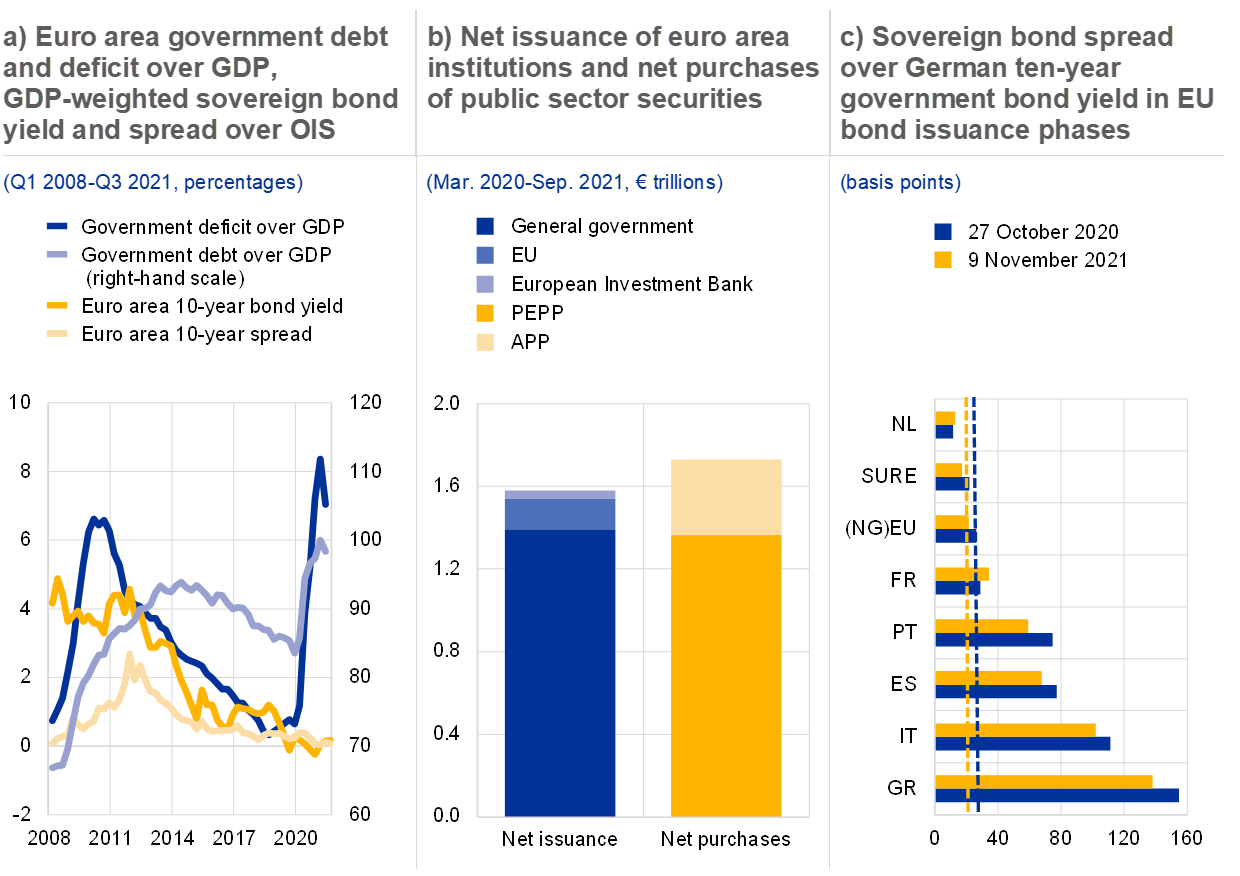
Sources: ECB Statistical Data Warehouse, Bloomberg Finance L.P. and ECB calculations.
Notes: Panel a: spreads are with respect to the ten-year overnight index swap (OIS) rate. Panel b: the general government category is as defined in the European System of Accounts 2010. Certain agencies eligible for Eurosystem purchases do not fall under this category.
Corporate vulnerabilities may resurface as policy support is reduced and could be a source of instability in financial markets. Default rates for speculative-grade firms have remained well below even the most optimistic forecasts made in March 2020 (see Chart 3, panel a, in the Overview), likely in part owing to the strong fiscal and monetary policy responses to the pandemic. While the median firm may look healthy, some evidence points to the existence of a tail of vulnerable corporates, which could lead to “catch-up defaults”.[26] A market correction might also be more severe in the presence of corporate vulnerabilities (see Box 3).
The increased reliance on market-based debt has enabled firms to benefit from a more diverse array of funding sources, but has rendered the financial system and the real economy more vulnerable to market corrections. A market correction does not automatically give rise to financial stability concerns. However, such concerns may arise when a sell-off turns disorderly, when it spills over to the wider market, or when it starts to affect the availability and cost of corporate financing. The increased importance of corporate bond markets (see Chart 2.6, panel b) leaves firms more exposed to such risks. It also increases the amount of risky, tradable debt in the system. High-yield debt is, to a large extent, being absorbed by investment funds (see Chapter 4). Open-ended investment funds are subject to redemption risk, and a liquidation of assets may amplify a sell-off.
Chart 2.6
The increased importance of market-based debt leaves both financial markets and the real economy more vulnerable to market corrections

Sources: ECB Statistical Data Warehouse, Bloomberg Finance L.P., S&P Global Market Intelligence and ECB calculations.
Notes: Panel a: EURO STOXX firms. Panel b: “Market-based credit share of total external credit” shows market-based credit as a share of total external credit. Specifically, the numerator includes debt securities and non-retained securitised loans, while the denominator is composed of debt securities and all loans except for intra-group loans.
Box 3
The sensitivity of asset prices to risk shocks when corporate vulnerabilities are high
Fragilities created by the interaction of stretched valuations and corporate balance sheet vulnerabilities may represent a risk to financial stability. Corporate asset prices have soared at the same time as the pandemic shock has prompted an increase in the vulnerability and indebtedness of many corporates. Corporate asset valuations look high relative to the fundamentals and rest to some degree on strong risk appetite, which could make them vulnerable to shifts in global risk sentiment.[27] In the current environment, where balance sheet fragilities depend on policy support and uncertainty about the recovery is still elevated, corporate vulnerabilities could re-emerge and stock and bond market prices may be more sensitive to reversals in global risk appetite. An interaction of such vulnerabilities may have an impact on financial conditions and pose risks to financial stability. This box examines the increased sensitivity of US corporate markets to risk-off shocks when corporate vulnerabilities are high, and considers the implications from a euro area perspective.
More2.3 Optimistic earnings expectations and low real yields further stretch some valuations despite growing risks
Valuations of certain asset classes are vulnerable if high earnings expectations fail to materialise. During the third quarter of 2021, equity markets reached record highs in both the euro area and the United States, as earnings expectations were increasingly revised upwards. Forward and trailing earnings recovered to just above pre-pandemic levels (see Chart 2.7, panel a), while equity prices advanced considerably more over the same period of time (see Chart 2.3, panel b). Despite the positive outlook for corporate earnings in the euro area, the uncertainty surrounding the outlook remains elevated, and the gap between trailing (realised) and forward earnings indicates risks to the realisation of the optimistic expectations (see Chart 2.7, panel b).
Chart 2.7
Strong earnings have boosted equity markets, but uncertainty remains high

Sources: Refinitiv and ECB calculations.
Note: Panel b: standard deviation is expressed as a percentage of forward earnings; surplus of forward over trailing earnings is expressed as a percentage of trailing earnings.
Some markets are showing signs of stretched valuations, especially given current uncertainties. The cyclically adjusted earnings yield in excess of the risk-free rate (excess CAPE yield) is hovering around post-global financial crisis lows, suggesting that equity valuations are stretched, particularly in the United States (see Chart 2.8, panel a). The post-vaccine rally in equity markets may also partly have been driven by the use of leverage, which could precipitate large concentrated losses if volatility increases. For example, in the United States debit balances in customers’ securities margin accounts, a measure of investor leverage, stand close to all-time highs.[28]
Structural developments in markets also point to a degree of complacency. Since the global financial crisis, markets have tended to move more homogeneously. In equity markets, this is reflected by the increasingly narrow distribution of individual stock returns, as well as by the increasing extent to which equity returns can be explained by common factors (see Chart 2.8, panel b). The increased importance of common factors mechanically implies a diminished role for the non-common components of typically more fundamental, firm-specific factors. This may hamper the price discovery mechanism and could mean that risks are no longer priced in a way that appropriately differentiates between assets with different characteristics.[29] These developments may be linked to the growing importance of passive investment strategies. Some market participants also point to the impact of central bank liquidity injections, which may affect asset prices in a relatively uniform manner.
Chart 2.8
Some valuations appear stretched and markets show some signs of complacency
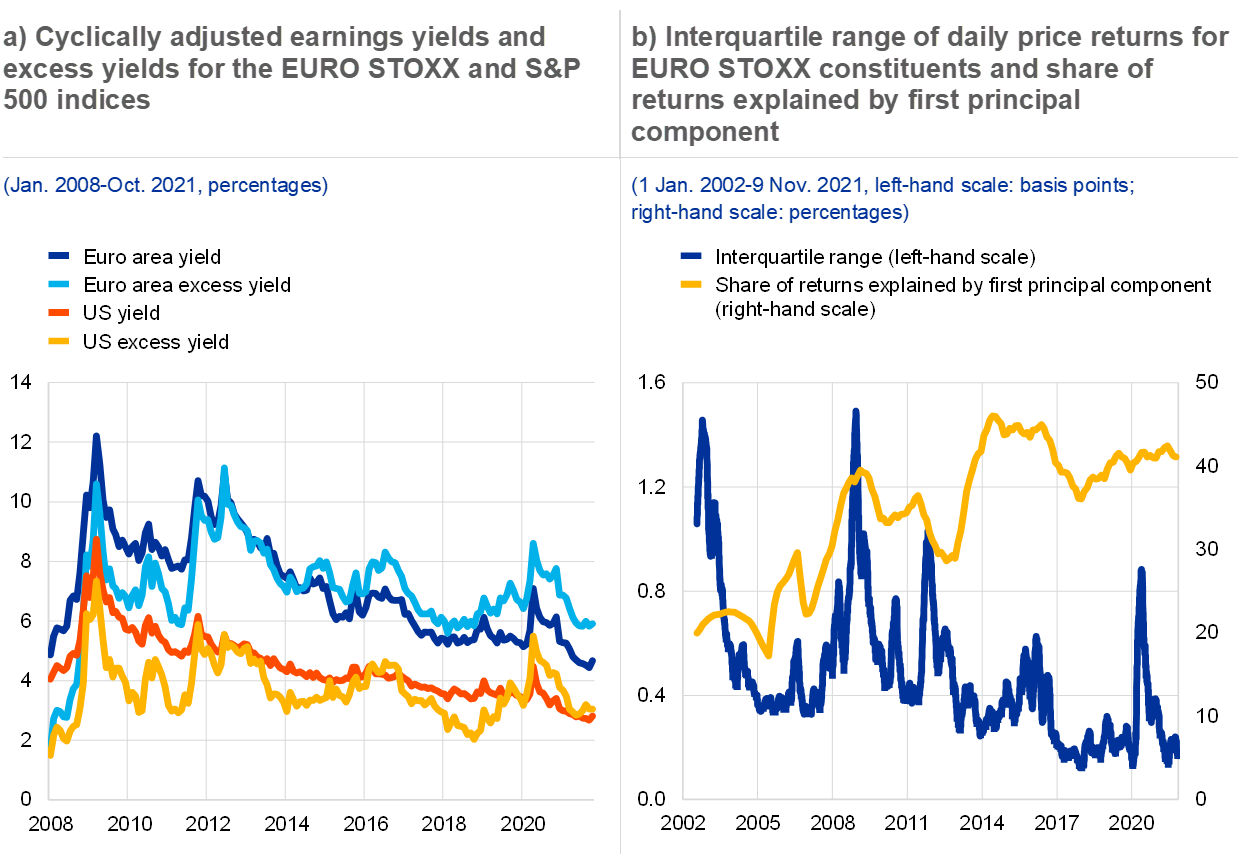
Sources: Refinitiv and ECB calculations.
Notes: Panel a: cyclically adjusted earnings are defined as the average of ten years of earnings, adjusted for inflation. The earnings yield is computed as the ratio of (cyclically adjusted) earnings per share divided by the share price. Excess yield refers to the difference between the earnings yield and the real yield on the relevant ten-year government bond yield. Panel b: share of variance of daily EURO STOXX equity returns explained by the first principal component. Principal components are determined over a two-year moving window. Results have been averaged over a moving 12-month window.
Changing cross-asset correlations are limiting market participants’ ability to diversify risks. The vaccine-driven “everything rally” seen in the first half of 2021 led to changes in a number of cross-asset relationships. Notably, in the United States the correlation between bond and stock returns turned positive. Together with the growing importance of common factors, as described above, such increased cross-asset correlations hamper market participants’ ability to diversify risks.
Speculative-grade debt and equity issuance have reached record highs in 2021, with investors exhibiting a continued strong appetite for risky assets. Immediately after the March 2020 market turmoil, investment-grade corporate bond issuance surged as firms hoarded cash. Speculative-grade issuance initially stalled in 2020, but restarted during the second half of the year and has reached record highs in 2021 (see Chart 2.9). Equity and leveraged loan issuance have also surged. Markets have soaked up the newly issued debt without signs of credit spread widening. High-yield bonds have been absorbed largely by investment funds (see Chapter 4). In the United States, the start of 2021 also saw sizeable issuance volumes from special-purpose acquisition companies (SPACs), but activity has been subdued since then. SPAC issuance in the euro area also rose, but remains insignificant from a financial stability perspective. Investors also made increasing use of the right to redeem their shares, instead of participating in the acquisition of a target company. This suggests that the appetite to obtain equity exposures through SPACs has moderated.
Chart 2.9
Issuance of risky assets surged in 2021

Sources: Dealogic, ECB Statistical Data Warehouse and S&P Global Market Intelligence and ECB calculations.
Note: Panel a: gross issuance of euro-denominated high-yield bonds by non-financial corporations located in the euro area. Panel b: gross issuance of euro-denominated listed shares. Panel c: European leveraged loan issuance also covers non-euro area issuers in Europe.
Crypto-asset markets have grown in importance and complexity, and their market capitalisation is subject to bouts of speculation. The growing popularity of stablecoins has strengthened links between crypto-asset and conventional financial markets (see Box 4). In addition, the development of a crypto-based market infrastructure under the name of “decentralised finance” (DeFi) has increased the complexity of crypto-asset markets. DeFi typically involves the use of smart contracts covering financial services such as lending, insurance, exchanging crypto-assets, derivatives platforms and staking.[30] Finally, some crypto-asset investors use leverage, which increases the potential relevance of the segment for financial stability as such practices can lead to large, concentrated losses.[31]
Box 4
The expanding functions and uses of stablecoins
The market capitalisation of stablecoins has risen from USD 5 billion to USD 120 billion since 2020 and they are serving increasingly different functions in the crypto-asset ecosystem (see Chart A, panel a). Stablecoins are digital units of value that use blockchain cryptography. They rely on tools to maintain a stable value relative to one or several currencies or other assets (including crypto-assets), or make use of algorithms to maintain a stable value.[32] For those stablecoins referring to currencies or assets, these tools include holding reserve assets against which stablecoin holdings can be redeemed. Despite their recent growth, stablecoins still only account for around 6% of the estimated USD 2 trillion total market capitalisation of crypto-assets, though interlinkages between stablecoins and crypto-assets imply a correlation of risks between these market segments. At the same time, the functions served by stablecoins within the ecosystem have multiplied. In addition to acting as a relatively safe “parking space” for crypto volatility, stablecoins serve as a bridge between fiat currencies and crypto-assets. They are used for trading: in September 2021 around 75% of all trading on crypto trading platforms involved a stablecoin.[33] Due to their relatively low price volatility, they are also used as collateral in crypto-asset derivative transactions or in decentralised finance (“DeFi”). In the light of stablecoins’ direct links to the traditional financial system and their interlinkages with the wider crypto-asset market, this box analyses the risks associated with the evolving functions of stablecoins and the financial stability implications of such risks.
More3 Euro area banking sector

3.1 Asset quality performing better than anticipated so far
The aggregate non-performing loan (NPL) ratio of euro area banks declined further during the first half of 2021, mainly due to the disposal of legacy NPLs. The aggregate NPL ratio stood at 2.4% at the end of the second quarter of 2021, down 31 basis points compared with the end of the previous year, confirming the downward trend observed since 2014. When excluding central bank reserves from the denominator,[34] the aggregate NPL ratio came out at 3.0%, falling at a slower pace than during the pre-pandemic period. The second quarter of 2021 still registered the highest decrease in the NPL ratio since the outbreak of the pandemic, mainly on the back of decreasing NPL stocks (see Chart 3.1, panel a). Banks in Greece and Cyprus reduced their NPL ratios by more than 8 percentage points after the outbreak of the pandemic, while in all other euro area countries changes in NPL ratios were still far from pre-pandemic levels (see Special Feature C and Chart 3.1, panel b). At the sector level, NPL ratios remain highest in the corporate portfolio, at 4.6% in the second quarter of 2021, mainly driven by loans to small and medium-sized enterprises.
Chart 3.1
Euro area aggregate NPL ratio declined during the first half of 2021, mainly reflecting the disposal of legacy NPLs concentrated in a few countries
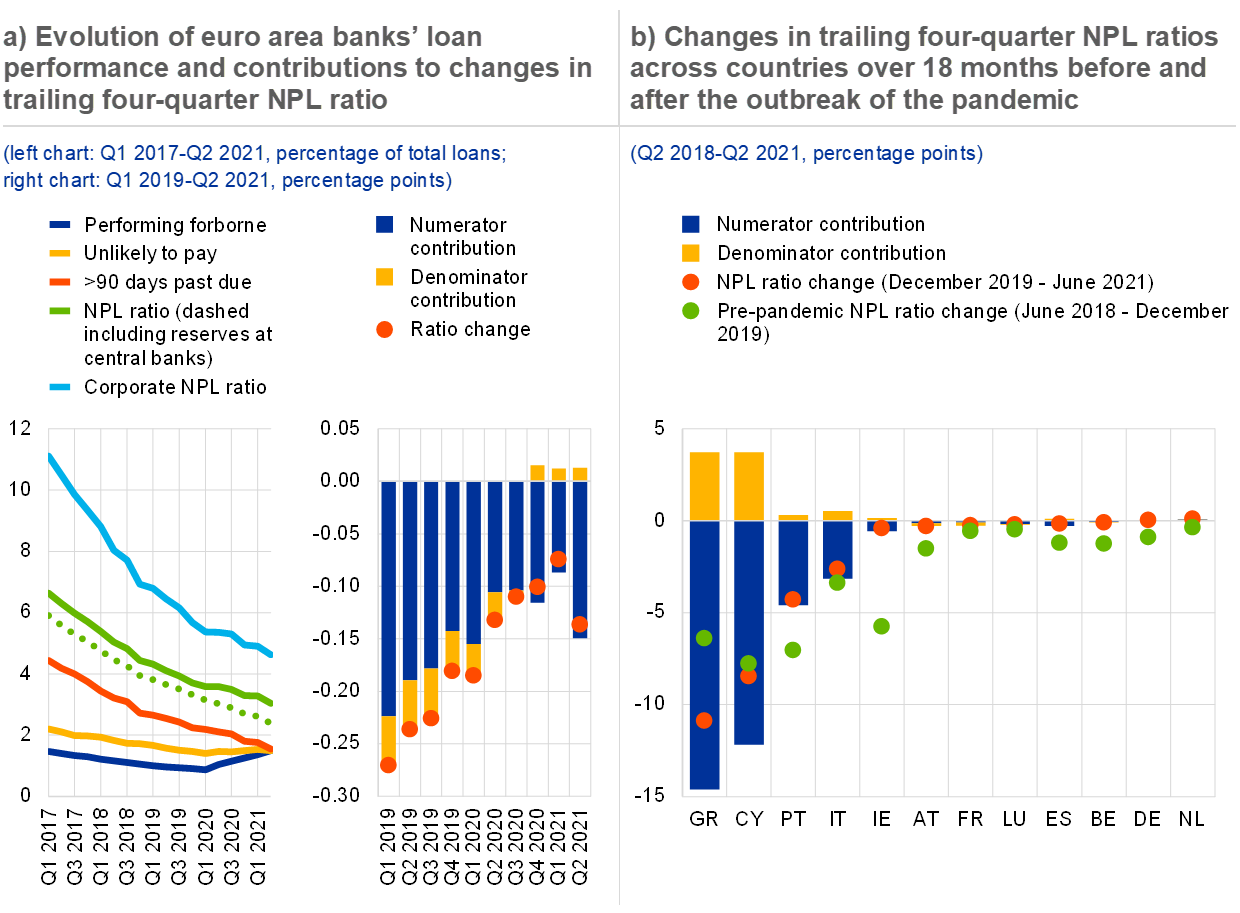
Sources: ECB supervisory data and ECB calculations.
Notes: Based on a balanced sample of 92 significant institutions. NPL ratios are computed in terms of gross carrying amount. Cash balances at central banks and other demand deposits are excluded from the denominator of the NPL ratio unless explicitly mentioned (i.e. the dashed line). Panel b: where the number of significant institutions in a country is less than three, the country is not shown for confidentiality reasons. NPL: non-performing loan.
Forward-looking credit risk metrics indicate a slowdown in asset quality deterioration during the first half of 2021, although heterogeneous across sectors. Following the surge registered at the outbreak of the pandemic, the increase in latent credit risk, as measured by net loan inflows to the “underperforming” Stage 2 asset class, was more contained in the second quarter of 2021 (see Chart 3.2, panel a).[35] The increase was driven both by reduced inflows (almost halved compared with the same quarter of 2020) and by record-high outflows, mostly back to Stage 1. That said, inflows are still more than double pre-pandemic levels; and in the first half of 2021 the share of loans migrating from “performing” Stage 1 to Stage 2 over a period of six months decreased by only 0.5 percentage points in pandemic-sensitive sectors versus 1.1 percentage points in other sectors relative to the second half of 2020 (see Chart 3.2, panel b). Within pandemic-sensitive sectors, declines in Stage 2 inflows were only seen in some (e.g. F – construction, H – transport, M – professional and N – administrative services), while inflows continued to increase in others (e.g. I – accommodation and R – arts and entertainment).
Chart 3.2
Measures of latent credit risk increased at their slowest pace since the outbreak of the pandemic and point to more limited asset quality deterioration for less affected sectors
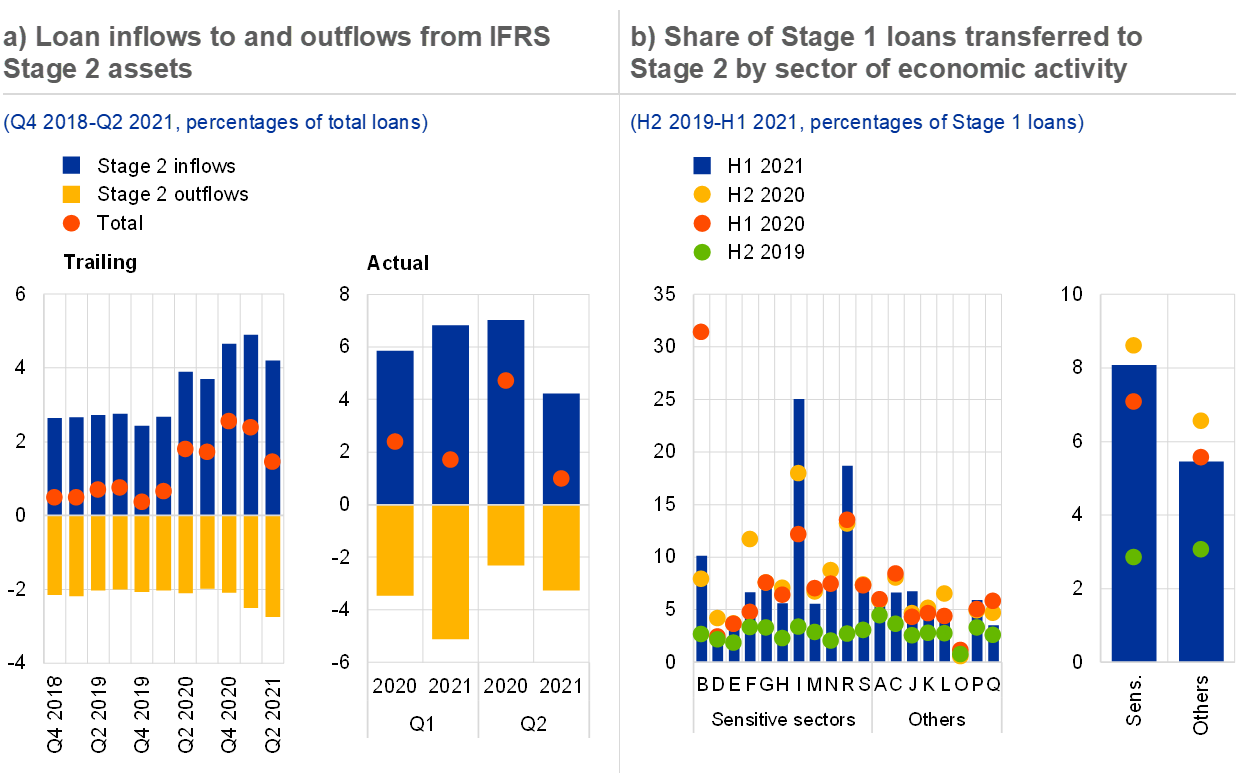
Sources: ECB supervisory data, ECB AnaCredit, ECB Register of Institutions and Affiliates Data (RIAD) and ECB calculations.
Notes: Based on a balanced sample of 92 significant institutions. Panel a, left chart: the total refers to the difference between actual inflows and outflows as observed in the trailing four quarters and is expressed as a share of total loans. Panel a, right chart: inflows and outflows as observed in the respective quarter and expressed as a share of total loans. Panel b: the loans transferred from Stage 1 to Stage 2 are scaled by all loans classified as Stage 1 at the beginning of the period and still on the balance sheet at the end of the period. This implies that the denominator includes only IFRS exposures. Capital letters refer to NACE codes as follows: A – Agriculture; B – Mining; C – Manufacturing; D – Electricity; E – Water supply; F – Construction; G – Trade; H – Transport; I – Accommodation; J – Communication; K – Financials; L – Real estate; M – Professional services; N – Administrative services; O – Public sector; P – Education; Q – Health services; R – Arts and entertainment; and S – Other services. Pandemic-sensitive sectors include mining, electricity, water supply, construction, retail and wholesale trade, transport, accommodation and food, professional, administrative, arts and entertainment, and other services. IFRS: International Financial Reporting Standards; NACE: Nomenclature statistique des activités économiques dans la Communauté Européenne (Statistical classification of economic activities in the European Community).
Loans reclassified to the “underperforming” Stage 2 category tended to have pre-existing vulnerabilities or be in banks closer to key capital thresholds. Firms whose loans were reclassified to Stages 2 and 3 during 2020 entered the crisis with higher debt-to-assets ratios, a lower return on assets and lower liquidity ratios, compared with firms whose loans remained in Stage 1 (see Chart 3.3, panel a). Loans to firms in sectors most affected by the lockdowns, notably services, were more likely to be reclassified to higher stages, although the noisiness of the relationship between turnover shocks and loan migrations suggests that other factors were significant too. Indeed, regression analysis suggests that banks with low capital buffers reclassified a larger share of loans to Stage 2 and Stage 3, holding borrower characteristics constant. However, reclassification of loans by banks with low capital buffers appeared less sensitive to corporate borrowers’ pre-pandemic vulnerabilities, especially their liquidity ratio, than reclassification by better capitalised banks (see Chart 3.3, panel b, dark blue and yellow lines). In line with the literature on zombie banks and zombie firms, this may hint at forbearance being granted to weaker borrowers.[36]
Chart 3.3
Loans to more leveraged and less profitable firms were more likely to be reclassified to IFRS Stages 2 and 3 in 2020 and banks’ distance to MDA influenced the classification

Sources: ECB supervisory data, ECB AnaCredit, Bureau van Dijk’s Orbis database and ECB calculations.
Notes: Sample of 850,000 firms with an active lending relationship classified as Stage 1 at end-2019 that remained active at end-2020. Panel b: a multinomial logit model is used to assess the role of firm-level, bank-level and macro factors in driving the deterioration of corporate credit quality. The dependent variable is defined as the stage in which the firm was classified at end-2020. Three groups of explanatory variables are considered: firm-level financial variables, representing the pre-pandemic fundamentals of the borrower, macro variables representing the country and sector-specific impact of the pandemic, and bank-specific factors. The results presented here are obtained from a specification including country fixed effects and interactions between bank distance to MDA and firm variables. Variables other than distance to MDA and borrower characteristic under assessment are set to the sample medians. A flat line in the chart indicates that the respective borrower characteristic was not correlated with the probability of loan migration to Stage 2. IFRS: International Financial Reporting Standards; MDA: maximum distributable amount; p.p.: percentage point; ROA: return on assets.
Nearly all euro area loan moratorium schemes have now expired with a limited immediate impact on banks’ asset quality, but risks of losses from loans still under moratoria have increased. Around 88% of moratoria granted to loans had expired as at June 2021 (see Chart 3.4, panel a) and the active moratoria still represent a material share (i.e. at least 5%) of total corporate loans only for banks in two euro area countries. While the expiry of moratoria has not immediately translated into a deterioration of banks’ asset quality, the coverage ratio of NPLs under moratoria increased from 24% in June 2020 to 36% in June 2021, signalling a higher concentration of risks in this portfolio. This development is observed in most euro area countries and suggests that, while stronger borrowers have gradually resumed payments, weaker borrowers – which usually require higher provisioning – are still taking advantage of this measure. At the same time, the share of loans taken up under government guarantee schemes reached its steady state at the beginning of 2021 and represents 3.4% of total loans to the non-financial private sector.
Chart 3.4
While moratoria on loans have almost completely expired, developments in corporate fundamentals do not predict an increase in NPL ratios until 2023
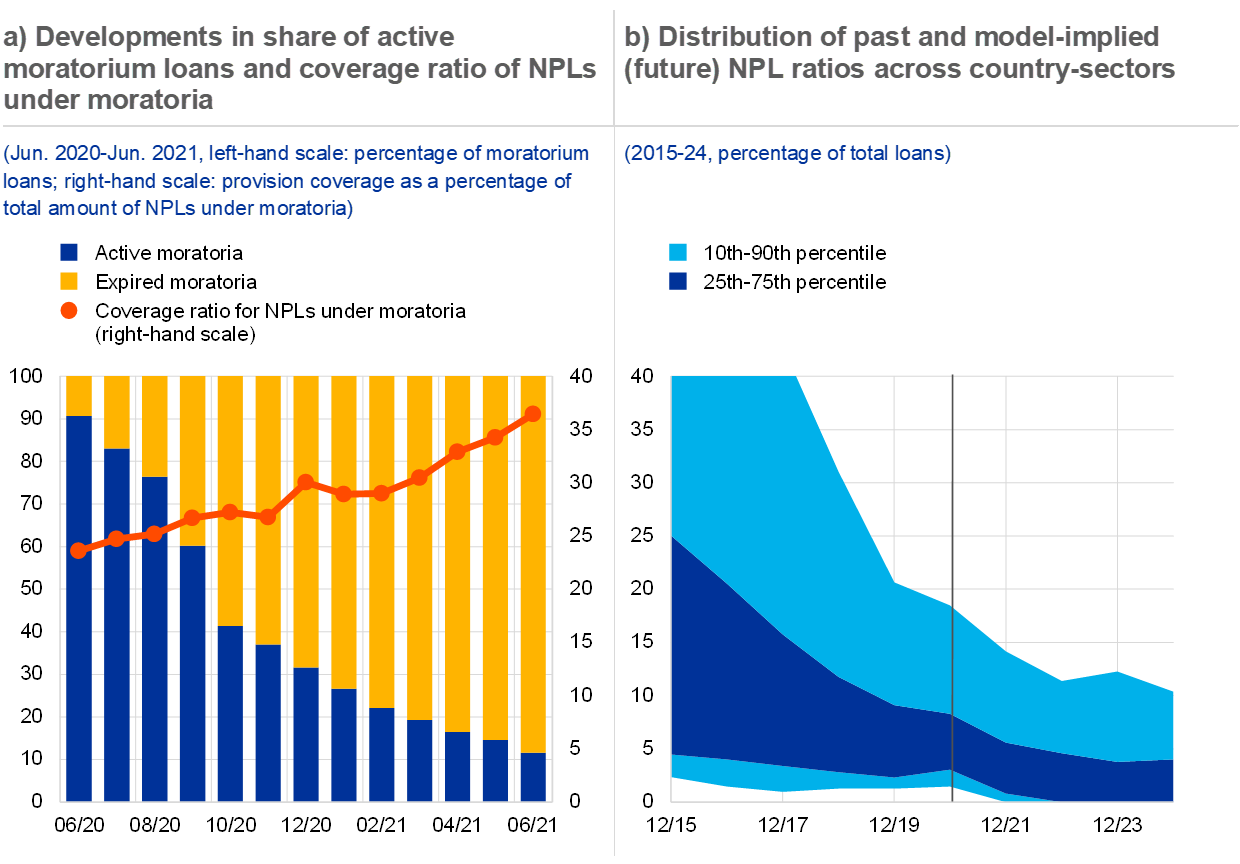
Sources: ECB supervisory data, Bureau van Dijk’s Orbis database, Capital IQ, Eurostat and ECB calculations.
Note: Panel a: Based on a balanced sample of 92 significant institutions. Panel b: distribution of median NPL ratios across country-sector groups of firms, considering nine economic sectors. For each country-sector group, the model-implied NPLs for 2020 to 2024 are based on past corporate fundamentals (median ROA, liquidity ratio and debt-to-asset ratio registered by firms inside each group) and forecast turnover mapped with relationships from a panel model consistent with that in Box 3 entitled “Do corporate fundamentals explain differences in sectoral NPLs?”, Financial Stability Review, ECB, May 2019. The results hold after controlling for country and sector fixed effects, and considering interactions between corporate financial variables and economic sectors. The nine economic sectors considered in this analysis account for around 60% of total loan exposures.
Despite the positive signs, the full impact of the pandemic on bank asset quality could take another two years to become visible. The future level of NPLs depends on the strength and continuation of the economic recovery, as well as the effectiveness of policy measures in preventing corporate defaults. An analysis of loan performance in all euro area countries for nine economic sectors from 2014 to 2020 finds that NPL ratios rise around four years after aggregate corporate profitability and liquidity ratios worsen, and two years after an increase in the debt-to-assets ratio.[37] Combining these historical relationships with the observed country-sector-level data and turnover paths consistent with the September 2021 ECB macroeconomic projections[38] suggests that the corporate NPL ratio could continue its gentle downward trend in most country-sector groups over the next few years (see Chart 3.4, panel b). At the same time, this approach implies that NPL ratios for the weakest country-sectors (i.e. the 90th percentile of the distribution of NPL ratios) will rise in 2023 and decrease again in 2024.
Overall, the outlook for euro area banks’ asset quality has gradually improved over the last year, in line with the economic recovery. Standard indicators of asset quality do not yet signal a material deterioration in credit quality, most likely influenced by two factors. First, policy measures seem to have provided adequate support to euro area firms; and second, the latest ECB macroeconomic projections expect real GDP to grow by 5.0% in 2021 and 4.6% in 2022 (compared with 3.9% and 4.2% respectively, predicted in December 2020) despite continued uncertainty related to the future development of the COVID-19 pandemic. In this context of uncertainty, supervisors have also identified several deficiencies in banks' credit risk management frameworks, which will have to be addressed and may have potentially negative impacts on asset quality indicators.[39]
3.2 Profitability recovering towards pre-pandemic levels
Euro area banks’ profitability improved in the first half of 2021 on the back of lower loan loss provisions and higher revenues. After a substantial decline in 2020 due to pandemic-induced impairments, especially during the second and fourth quarters, the aggregate return on equity (ROE) of euro area significant institutions rose from 1.3% at the end of 2020 to 5.2% in the second quarter of 2021.[40] For euro area banks on aggregate, the largest part of the profitability improvement can be attributed to lower impairment costs reflecting reduced downside risks to growth after the vaccine approval and the gradual reduction in containment measures. However, differences across banks remain pronounced. For better performing banks, the profitability improvement was mainly driven by higher operating profit, while worse performing banks saw a decline in their operating profit which was compensated for by lower impairments and positive contributions from one-off other profit and loss items (see Chart 3.5, panel a). The third quarter earnings releases of listed banks reveal that the profitability of euro area banks improved slightly compared with the previous quarter on the back of higher operating profits. This was mainly driven by improved NII and NFCI.
Trading as well as fee and commission income supported profitability, while interest income declined. Significant institutions’ aggregate operating profit rose in the first six months of 2021 amid higher net trading income (NTI) as well as net fee and commission income (NFCI), which compensated for the decline in net interest income (NII). As this outcome for the euro area aggregate was mainly driven by the strong contribution of trading income, it benefited institutions with a larger role of investment banking (see Box 5). The heterogeneity across banks is also visible in the changes in operating profit. More profitable banks exhibited higher operating profit on the back of rising NII in particular but also due to higher NFCI and NTI. For less profitable banks, operating profit fell as cost-cutting could not compensate for the decline in NFCI and, especially, in NII (see Chart 3.5, panel b).
Chart 3.5
Bank profitability remained heterogeneous across individual institutions, as core revenues improved for more profitable banks and declined for less profitable banks
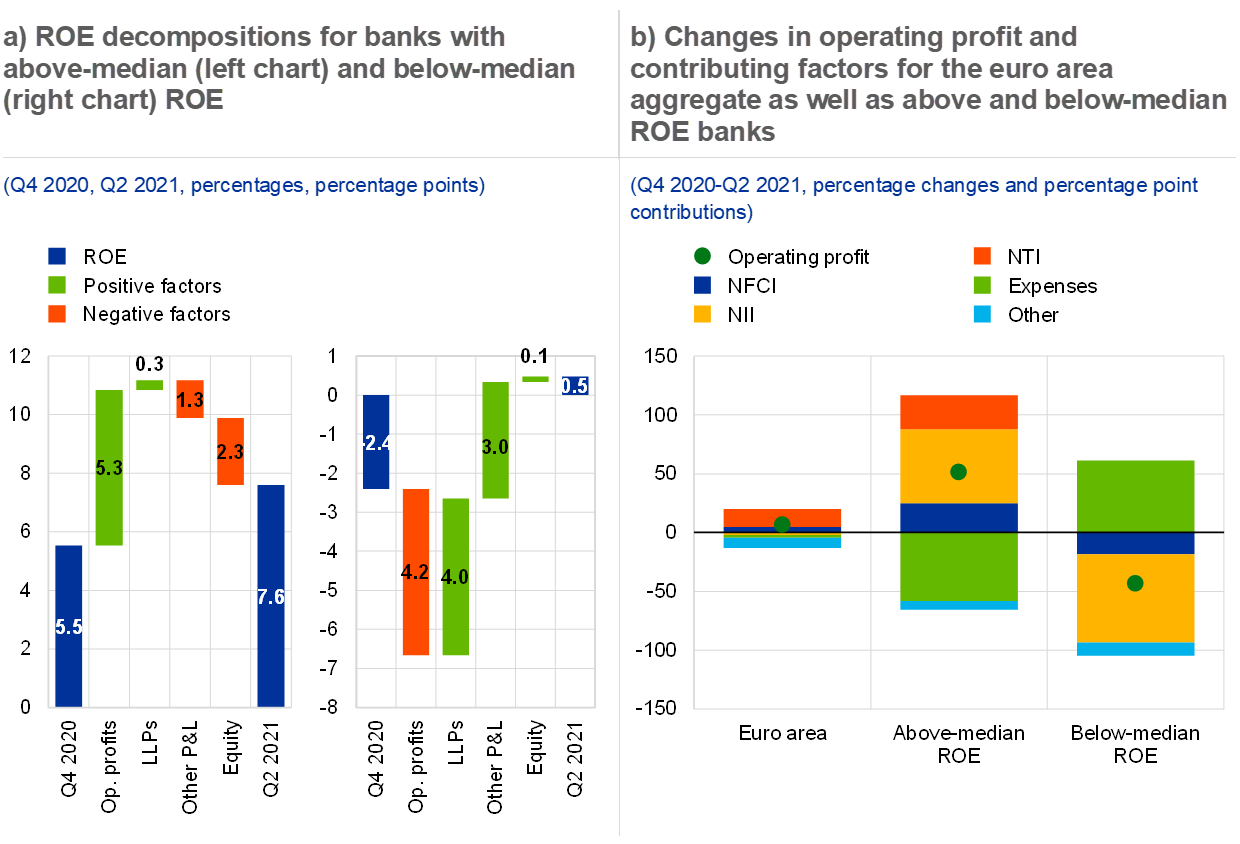
Sources: ECB supervisory data and ECB calculations.
Notes: Based on a balanced sample of 92 significant institutions. The split of the sample into two groups is based on trailing four-quarter ROE levels in the second quarter of 2021. LLPs: loan loss provisions; NFCI: net fee and commission income; NII: net interest income; NTI: net trading income; P&L: profit and loss; ROE: return on equity.
Net interest income remains subdued, but its decline has slowed recently. While net interest income accounts for almost 60% of the aggregate net income of euro area significant institutions, it has declined by 6% since the fourth quarter of 2015 owing to margin compression in a low interest rate environment. An open question in the light of declining margins is whether the interest earned on new lending is commensurate with the credit risk (see Chart 3.6, panel a). Starting from around 2018, banks tried to counter the margin decline by increasing loan volumes. When the pandemic hit, state guarantees helped banks to limit their credit risk while supporting the lending flow to the real economy, but the resulting decline in risk premia also intensified margin compression. With the gradual reopening of economies and the expiry of state support measures, the decline in net interest income has slowed recently (see Chart 3.6, panel b).
Chart 3.6
The decline in net interest income slowed, but it remains uncertain whether the interest earned compensates sufficiently for the credit risk to which banks are exposed
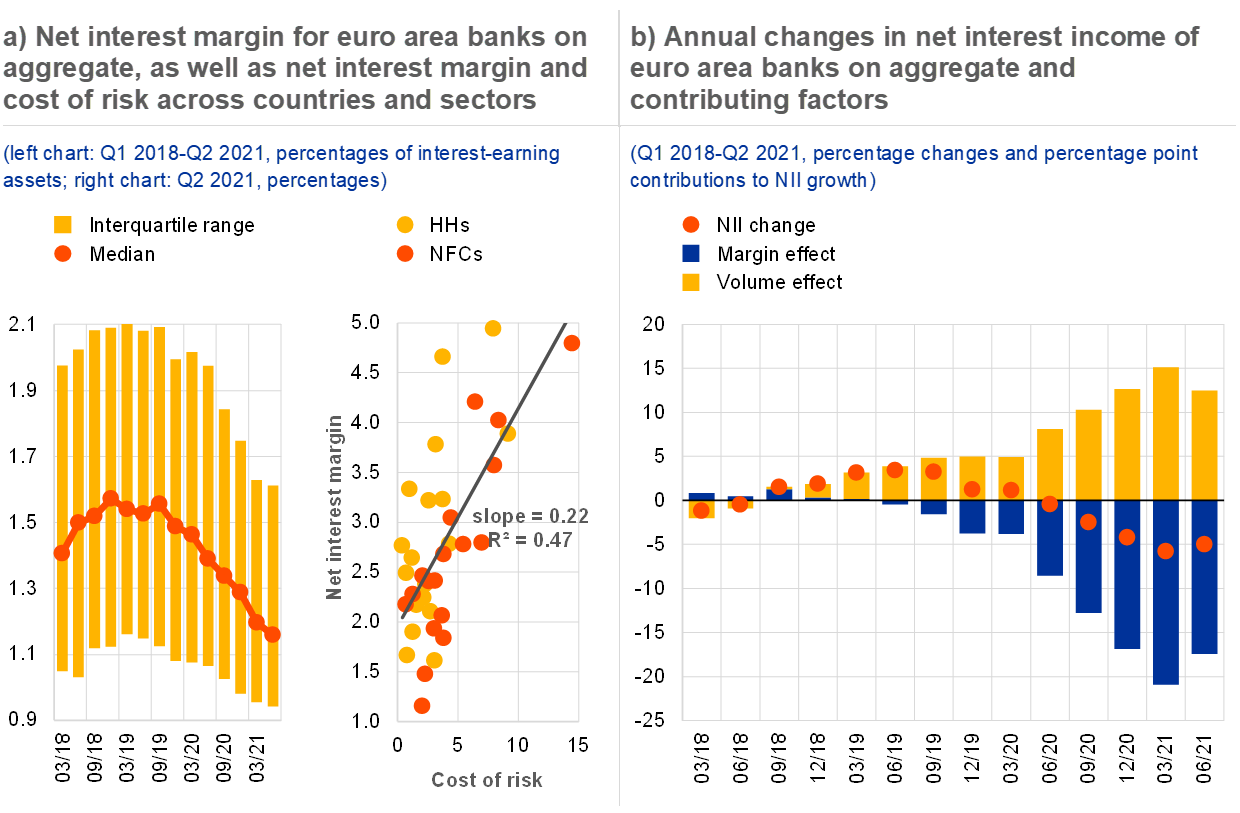
Sources: ECB supervisory data and ECB calculations.
Notes: Based on a balanced sample of 92 significant institutions. Figures are on a trailing four-quarter basis. Panel a: cost of risk is defined as impairments on loans divided by loans. The net interest margin at the country-sector level is computed as net interest income on loans as a share of performing loans. HHs: households; NFCs: non-financial corporations; NII: net interest income.
The profitability of euro area banks is expected to normalise further in 2022, but at a slower pace than this year. Due to the reopening of economies, the euro area macro outlook for 2021 and 2022 has improved since June (see Chapter 1). In tandem, market analysts have revised upwards their estimates of banks’ return on equity in 2021 to 7.2%, from 4.2% at the end of May (see Chart 3.7, panel a). As the GDP projection for 2022 has only improved slightly over the same period, the expected rise in bank profitability for 2022 is also more modest. The bulk of the increase in future bank profitability is due to lower loan loss provisions. With regard to the expected improvements in operating profit and net interest income, model estimates suggest that they are mainly driven by higher fee income and lending volumes respectively (see Chart 3.7, panel b). Even if downside risks from a potential resurgence of the coronavirus do not materialise, bank profitability is set to remain under pressure from the low interest rate environment. According to forward rates, the yield curve slope – an indicator of the potential for maturity transformation – is expected to increase in the coming years, but less than it was a few months ago. Bank consolidation through mergers and acquisitions can also help to address these structural challenges and act as a catalyst for improving efficiency and ultimately profitability (see Special Feature B).
Chart 3.7
Alongside an improving macro outlook, bank profitability is expected to continue recovering due to lower impairments as well as higher fees and lending volumes

Sources: Bloomberg Finance L.P., Consensus Economics, Fitch Ratings, Refinitiv and ECB calculations.
Notes: Panel a: the ROE forecasts are computed as a median based on a sample of 31 listed euro area banks. Panel b: the projections for 2021 and 2022 are ECB staff time-series VAR estimations as at end-September. The sample of banks in the time-series VAR models is 41 banks for which analysts’ expectations are available. E: estimate; NFCI: net fee and commission income; NII: net interest income; ROE: return on equity; VAR: vector autoregression.
Recent lending volumes have exceeded pre-pandemic levels on the back of markedly higher mortgage lending, while corporate loan growth is still expected to pick up. During 2018 and 2019, lending flows of euro area banks were broadly balanced between corporate lending and lending for house purchases. At the onset of the pandemic, corporate lending increased to meet firms’ liquidity needs, but has since become more muted, and banks’ new lending volumes have become dominated by mortgage lending (see Chapter 1 and Box 2). In the second half of 2021[41], average monthly lending to the private non-financial sector exceeded the pre-pandemic levels seen during 2018-19 for the first time. But while lending for house purchases is 68% above the levels observed prior to the pandemic, lending to households for consumption is still 55% lower and lending to non-financial corporations (NFCs) only picked up recently. Between July and September it was, on average, 14% above pre-pandemic levels (see Chart 3.8, panel a). Owing to the reopening of euro area economies, indicators of consumer and industrial confidence have improved substantially and results from the euro area bank lending survey point to rising corporate loan demand. As both confidence indicators and loan demand typically lead lending growth, a pick-up in NFC loan growth can be expected going forward. At 5.5%, mortgage loan growth is at the highest level observed since the global financial crisis and is trending upwards (see Chart 3.8, panel b). To the extent that banks rely on higher loan volumes to compensate for the margin decline, intense competition might lead to a deterioration in underwriting standards, which might affect banks’ credit risk in the future. And as mortgages have been granted increasingly at fixed rates with longer maturities, interest rate risk has shifted from borrowers to banks.
Chart 3.8
Corporate lending was muted but started to improve recently, while mortgage lending growth is at its highest level since the global financial crisis
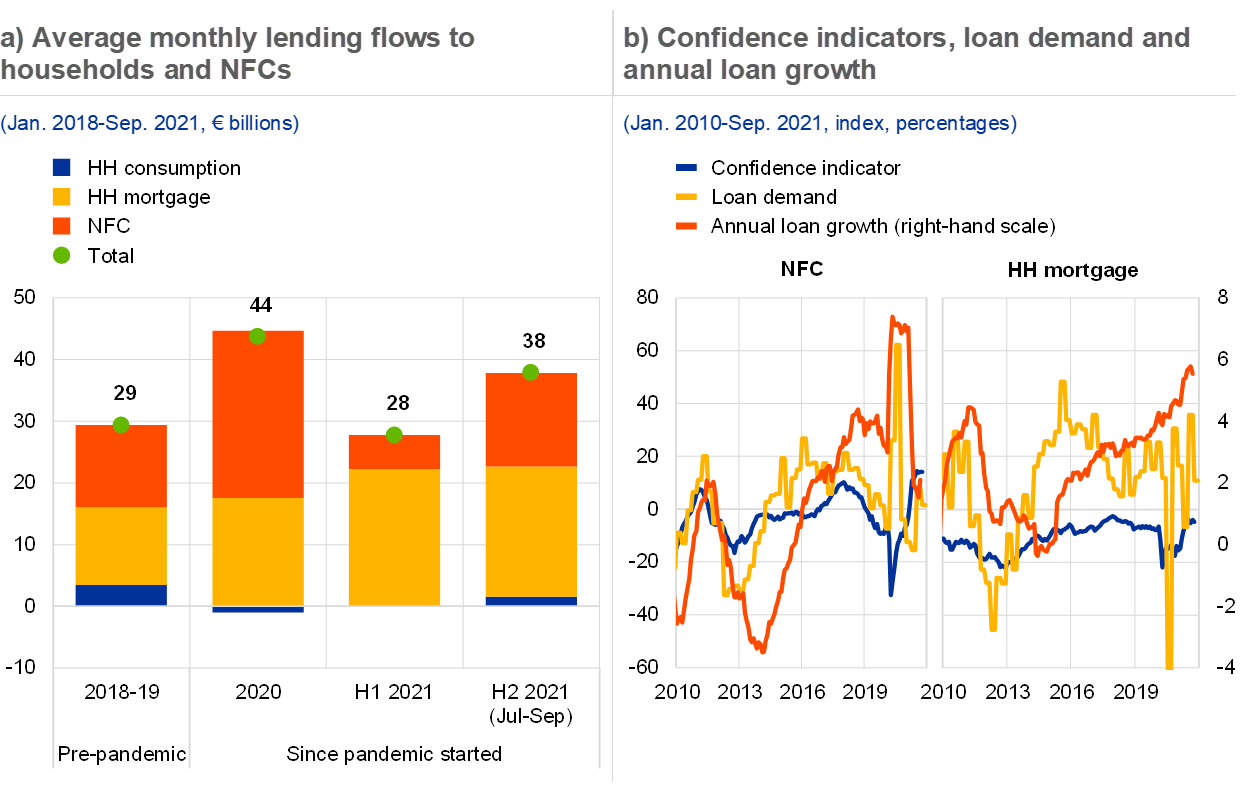
Sources: ECB MFI balance sheet statistics, European Commission, ECB euro area bank lending survey and ECB calculations.
Notes: Panel a:HH consumption: loans to euro area households for consumption; HH mortgage: loans to euro area households for house purchases; NFC: loans to euro area non-financial corporations.
Losses from operational risk events have declined compared with the previous year. The gross losses from operational risk events which occurred during the first six months of 2021 have declined by 7% to €4.2 billion (corresponding to around 0.3% of total equity) compared with the same period last year, but are 2% above the levels seen in 2019. The share of losses related to execution, delivery and process management, which had increased after the start of the pandemic and accounted for almost half of the total losses, decreased and fell below pre-pandemic levels (see Chart 3.9, panel a). In terms of the number of operational risk events in the first half of 2021, external fraud represents, at 68%, the most common event type and its share is trending upwards, but it accounts for only 11% of the total losses (see Chart 3.9, panel b).
Chart 3.9
The number of operational risk events is gradually increasing, but losses have declined compared with last year
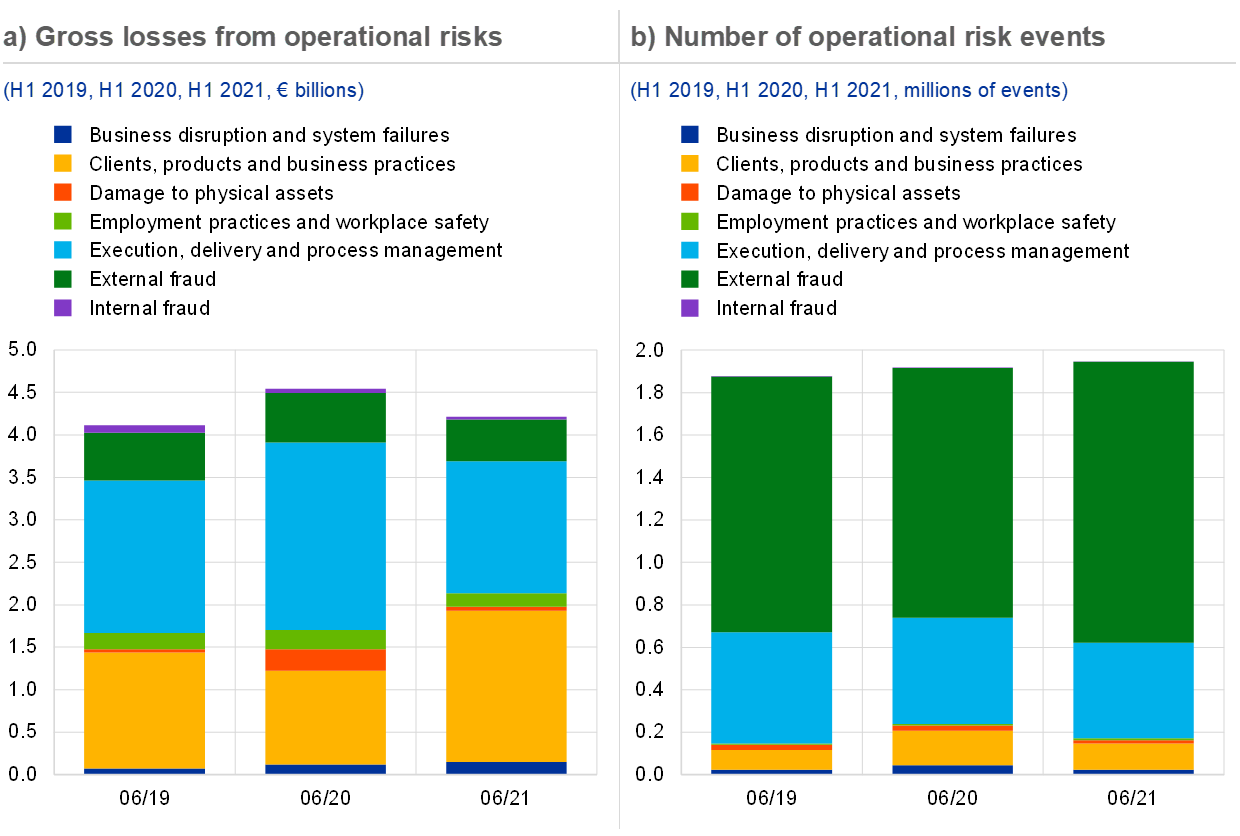
Sources: ECB supervisory data and ECB calculations.
Note: Based on a balanced sample of 92 significant institutions.
Cyber incidents reported by euro area banks have remained broadly unchanged in 2021. While cyber incidents reported by euro area banks have increased during the pandemic, there was no major change in the overall number and structure of reported incidents during the first half of 2021. Distributed denial-of-service attacks represent the most frequent type of incident, but institutions have not been severely impacted so far. In addition, ransomware attacks, which have been increasing in other industries, have also been observed in the financial industry, mostly via banks’ third-party service providers. These attempts did not, however, lead to substantial damage to banks.
Box 5
Sustainability of recent euro area investment banking strength and debt capital market intermediation
Investment banking revenues have contributed markedly to the recent increase in euro area banks’ non-interest income growth and the rebound in bank profitability (see Chart A, panel a, upper chart).[42] Internationally, in the last three years equity capital market (ECM) revenue has doubled, while debt capital market (DCM) and merger and acquisition (M&A) revenues have increased by around 50%, with only syndicated lending remaining more subdued. In the euro area, however, the most significant volume increase has come from debt instruments, which have long been the preferred source of corporate funding in the euro area, dominating over equity (see Chart A, panel a, lower chart). Despite the international growth in capital market volumes, market commentary before the pandemic suggested that investment banking was a weak aspect of European banking,[43],[44] with many large banks retreating from various market segments as they faced the fallout from the global financial crisis. Against this background, this box considers the recent developments in investment banking of euro area banks in relation to some of the prior trends and considers how sustainable the recent strength might be.
More3.3 Favourable funding costs and slightly lower capital ratios
Consistent with euro area banks’ loan and profitability performance, costs of funding remain favourable and are expected to stay low in the period ahead. After a sharp increase during the first half of 2020 amid the uncertainty induced by the coronavirus, bond funding costs gradually returned to pre-pandemic levels. Having marginally increased since August in tandem with inflation expectations, bond funding costs are currently slightly higher than prior to the pandemic, while the costs of deposit funding have declined further (see Chart 3.10, panel a). Even though forward contracts suggest a slight increase in interest rates over the next three years, banks’ average bond funding costs will continue to decline since maturing bonds can be refinanced at rates that are still lower than their previous yields at issuance. The spreads banks are paying above the risk-free rate to compensate their bondholders for their inherent credit risk have also declined since March 2020, consistent with the recent decrease in the share of banks with a negative rating outlook (see Chart 3.10, panel b). But while this suggests that the bulk of the banking sector’s downside risk has receded, the share of institutions with a positive rating outlook has remained unchanged, which indicates that the sector is still considered vulnerable to structural problems, climate-related challenges[45] and profitability pressures from the low-rate environment.
Chart 3.10
Bank funding costs remain low and improved rating outlooks as well as tighter bond spreads indicate a substantial reduction in downside risks since the pandemic hit
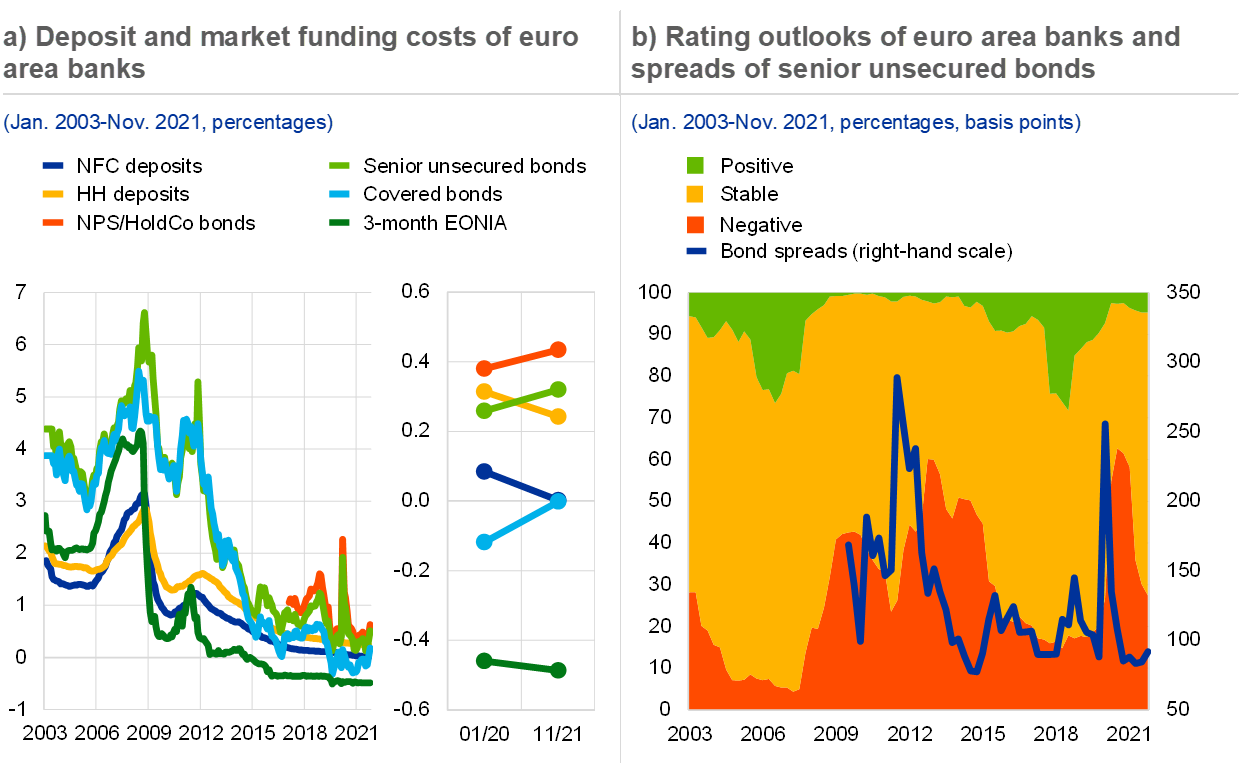
Sources: ECB MFI balance sheet statistics, IHS Markit, Bloomberg Finance L.P., DBRS, Fitch Ratings, Moody’s Analytics, S&P Global Market Intelligence and ECB calculations.
Notes: Panel b: bond spreads are z-spreads of senior unsecured bank bonds. Z-spreads are defined as the difference (in basis points) between the yield to maturity of a bank’s bond and the yield of a maturity-matched euro swap. EONIA: euro overnight index average; HH: household; HoldCo: holding company; NFC: non-financial corporation; NPS: non-preferred senior.
Euro area banks have seen extraordinary deposit inflows since the start of the pandemic, with the pass-through of negative rates to depositors intensifying. Higher household savings, as a consequence of containment measures and corporate borrowing to create liquidity buffers at the start of the pandemic, led to substantial deposit inflows. Between the fourth quarter of 2019 and the second quarter of 2021, the volume of household and corporate deposits at euro area significant institutions increased by €600 billion (+9%) and €500 billion (+18%) respectively, which contributed to a lower need for wholesale funding (see Chart 3.11, panel a). While deposits are typically used for payments, the recent rises seem more likely to reflect precautionary saving motives. In turn, while the pass-through of zero or negative deposit rates has largely been extremely gradual since 2014, the extraordinary deposit inflow resulting from the pandemic eventually prompted banks to lower the rates of more household deposits to zero and into negative territory (see Chart 3.11, panel b). To compensate for the gradual decline in interest income, banks have also increased fees related to current accounts, credit cards and payment transactions, which is reflected in the increasing contribution of fee and commission income.
Chart 3.11
There has been an exceptional increase in deposit funding since the start of the pandemic, prompting banks to lower rates for corporate and household depositors
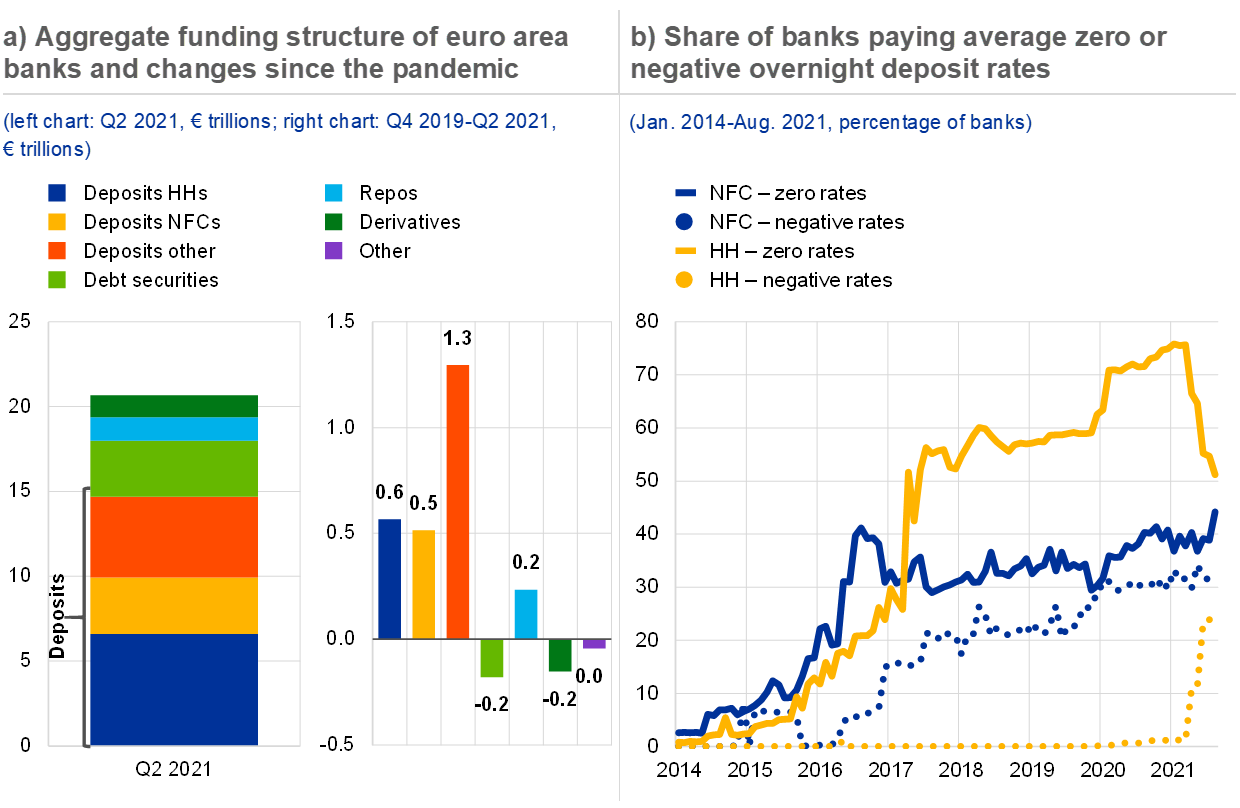
Sources: ECB supervisory data, ECB MFI balance sheet statistics, ECB MFI interest rate statistics and ECB calculations.
Notes: Panel a: based on a balanced sample of 92 significant institutions. Panel b: the computations are based on overnight deposits, using a materiality threshold of ±1 basis point, and banks’ interest rates are weighted by the respective deposit volumes. HHs: households; MFI: monetary financial institution; NFCs: non-financial corporations; Repos: repurchase agreements.
While still at robust levels, regulatory capital ratios of euro area banks declined marginally on aggregate during the first half of 2021. While retained earnings and declining average risk weights contributed to a higher Common Equity Tier 1 (CET1) ratio, this was more than offset by pronounced balance sheet expansion as well as capital erosion (see Chart 3.12, panel a). Noteworthy are the different drivers of the changes in the CET1 ratio across country groups. Balance sheet expansion led to a lower capital ratio in countries less affected by past crises and a mix of balance sheet expansion and capital erosion were the main drivers in more affected countries. Looking at the decomposition of changes in risk-weighted assets reveals that banks in countries less affected by past crises were expanding their risk-weighted assets in the first six months of 2021, whereas banks in more affected countries were still in a risk-off mode (see Chart 3.12, panel b). The increase of risk-weighted assets in the “less affected” country group was mainly driven by higher credit risk associated with an expansion in corporate lending.
Despite signs of a substantial reduction in pandemic-related tail risks and robust capital positions, credit risks are likely to materialise with a lag. While banks are equipped with solid capital buffers above regulatory minimum requirements, they face challenges due to the expiry of public support measures alongside a potential rise in corporate insolvencies. The macroprudential stress test conducted by the ECB, given its dynamic balance sheet perspective, complements the EU-wide stress test run by the European Banking Authority and ECB Banking Supervision (see Box 6).
Chart 3.12
Banks’ regulatory capital ratios declined slightly with different factors driving the changes across country groups
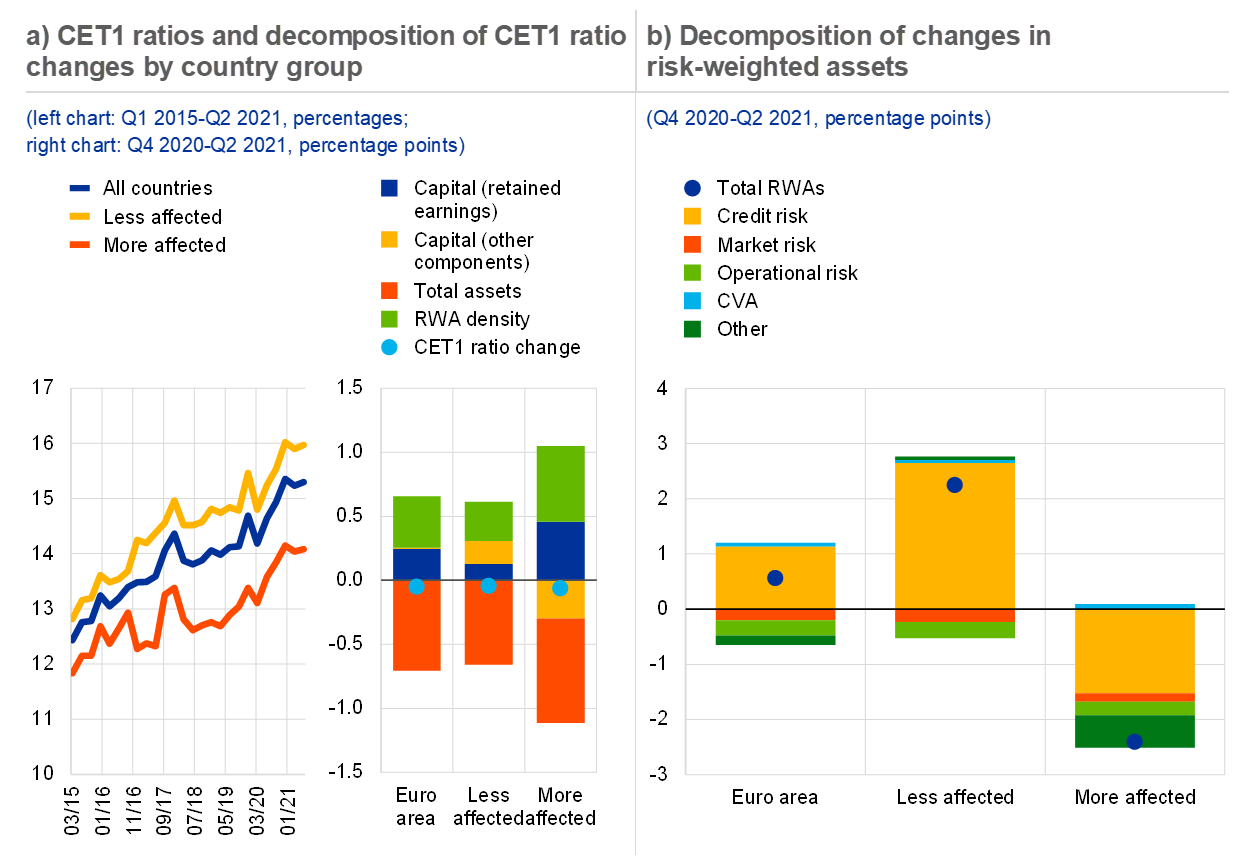
Sources: ECB supervisory data and ECB calculations.
Notes: Based on a balanced sample of 92 significant institutions. “Less affected” refers to countries less affected by past crises (i.e. by the global financial and euro area sovereign debt crises) and “more affected” to countries more affected by past crises. Countries more affected by past crises include Cyprus, Greece, Ireland, Italy, Portugal, Slovenia and Spain. CET1: Common Equity Tier 1; CVA: credit valuation adjustment; RWAs: risk-weighted assets. Panel a: The CET1 ratio refers to the transitional definition.
Equity prices of euro area banks have returned to pre-pandemic levels. The rally in bank stock prices that started in November 2020 with the vaccine approval and was later on driven by higher inflation expectations brought banks’ equity prices back to pre-pandemic levels in June (see Chart 3.13, panel a).[46] Since then the magnitude of the anticipated economic recovery, the related inflationary implications and also bank stock prices were affected by fears of coronavirus mutations, on the one hand, and supply-chain price pressures, on the other. That bank stock prices have reached, but not yet substantially exceeded, pre-pandemic levels suggests that market participants consider the sector to have overcome pandemic-induced challenges, but that structural challenges resulting from cost inefficiencies and low profitability still prevail.
Better capitalised banks tended to outperform other banks on rising prospects of a resumption of dividend payouts and share buybacks. Since June when the lifting of caps on euro area banks’ capital distributions was discussed more actively, stocks of better capitalised banks have tended to outperform the overall sector. Even though only a small number of banks have outlined their payout plans, banks with stronger capital positions seem to have more room for manoeuvre (see Chart 3.13, panel b).
Chart 3.13
Bank stock prices are back at pre-pandemic levels and since June better capitalised banks have tended to outperform the sector amid capital distribution plans
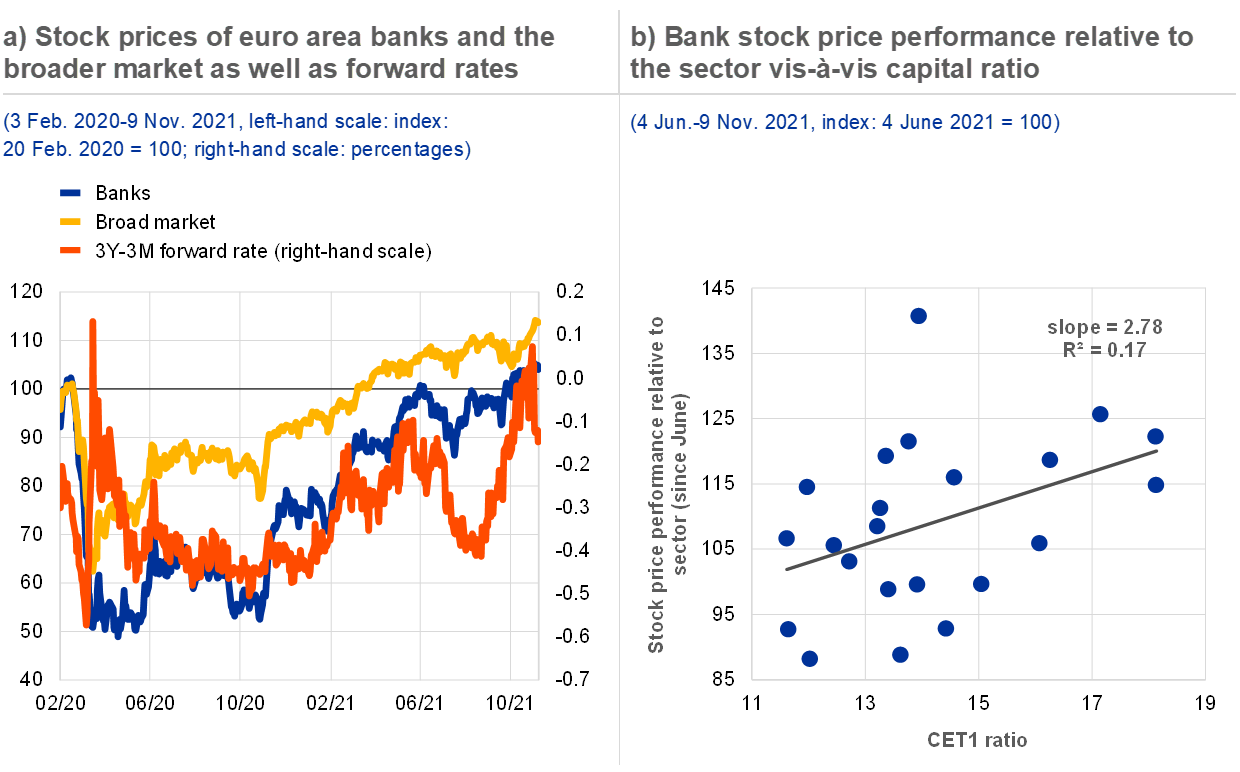
Sources: ECB, Refinitiv, Bloomberg Finance L.P. and ECB calculations.
Notes: Panel a: the “Broad market” index refers to the Euro Stoxx 50 Price Index; the “Banks” index refers to the EURO STOXX Banks Index; the 3Y-3M forward rate refers to the rate of a three-month EONIA three years from now. CET1: Common Equity Tier 1; M: month; Y: year. Panel b: the chart is based on the listed banks included in the EURO STOXX Banks Index.
Box 6
ECB macroprudential stress test complements the EBA/SSM stress tests results in 2021
The ECB’s biennial macroprudential stress test evaluates the resilience of the euro area banking system, this year also assessing the impact of pandemic-related policy measures[47]. The macroprudential stress test exercise complements the supervisory stress test recently published by the European Banking Authority/Single Supervisory Mechanism (EBA/SSM). While relying on the same adverse and baseline scenarios (see Table A),[48] it also employs a dynamic balance sheet perspective and introduces amplification mechanisms.[49],[50] This year it also examined a number of remaining pandemic-related policy measures, including the profit distribution restrictions phased out at the end of September 2021, public guarantee programmes and public moratoria.
More4 Non-bank financial sector

4.1 While credit risks moderate, non-banks’ vulnerability to duration risk builds amid persistently high liquidity risk
Although non-banks increased their risk-taking during the pandemic, the economic recovery has reduced their credit risk vulnerability lately. Credit rating downgrades and the absorption of the relatively high issuance by lower-rated corporates implied that the average credit quality of non-banks’ debt portfolios worsened following the start of the pandemic (see Chart 4.1, panel a). For example, the share of high-yield assets in investment funds’ bond portfolios has increased by 3 percentage points to 22% since the end of 2019. However, near-term vulnerabilities have begun to moderate as macroeconomic conditions have improved amid favourable financing conditions for firms. As a result, the number of downgrades and debt holdings with a negative rating outlook is converging back towards pre-pandemic averages (see Chapter 2), reducing the credit risk vulnerability of non-banks’ portfolios (see Chart 4.1, panel b).
Chart 4.1
Non-banks increased their risk-taking during the pandemic, but the economic recovery has reduced their credit vulnerabilities
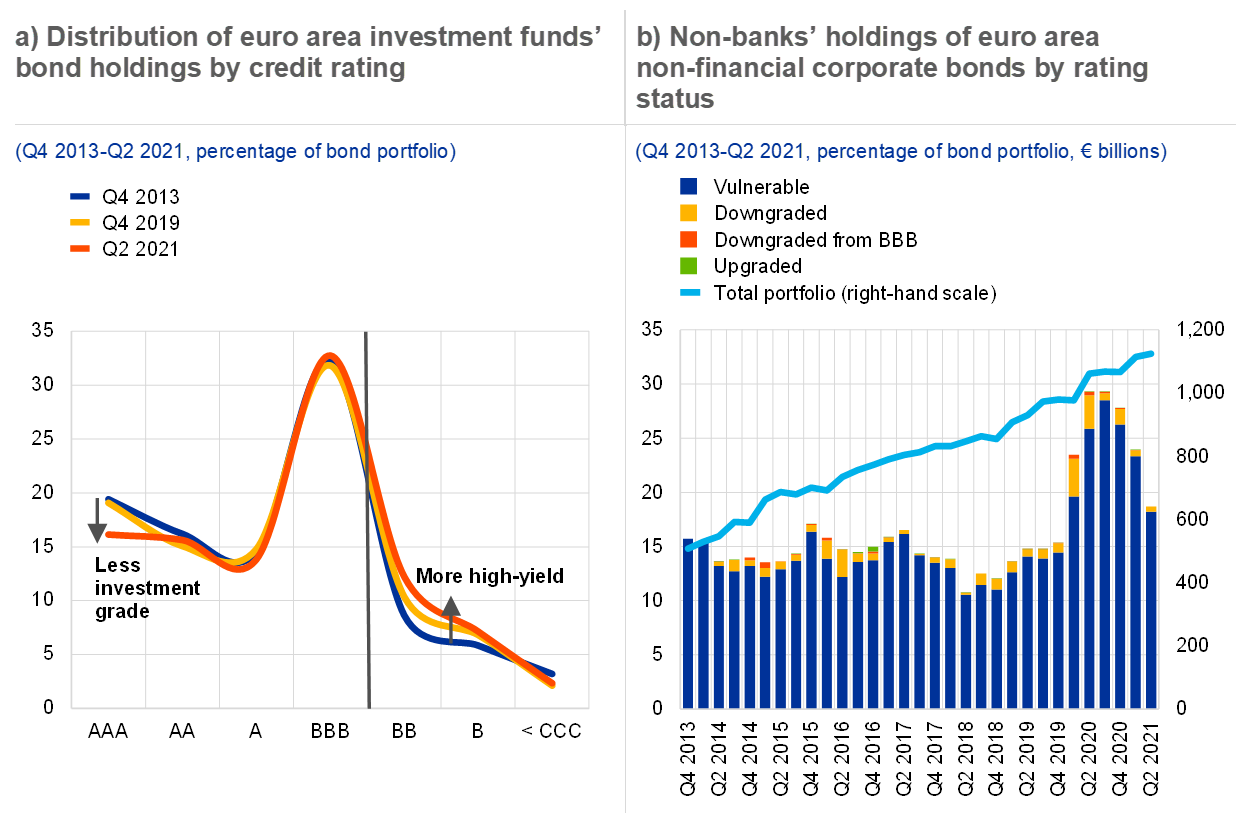
Sources: ECB (securities holdings statistics and Centralised Securities Database) and ECB calculations.
Notes: Panel b: securities are classified as vulnerable when Standard & Poor’s has placed the issuer under negative credit watch or negative credit outlook. Non-banks include investment funds, insurance corporations and pension funds.
Non-banks play an important role in debt securities markets (see Chart 4.2, panel a). For example, euro area investment funds (IFs) and insurance corporations and pension funds (ICPFs) hold some 50% of euro area non-financial corporate bonds. Short-term commercial paper markets are dominated by money market funds (MMFs), which alone hold about 40% and 50% of the financial and non-financial segments respectively. Moreover, non-banks hold around half of the free-floating euro area sovereign bonds not held by domestic and foreign public sectors. A disruption in market-based credit supply, triggered for example by sudden outflows from MMFs and IFs, could significantly affect the financing cost of sovereigns and firms and have sizeable effects on the real economy (see Box 7).
Chart 4.2
Non-banks play an important role in debt security markets and are increasingly vulnerable to interest rate shocks
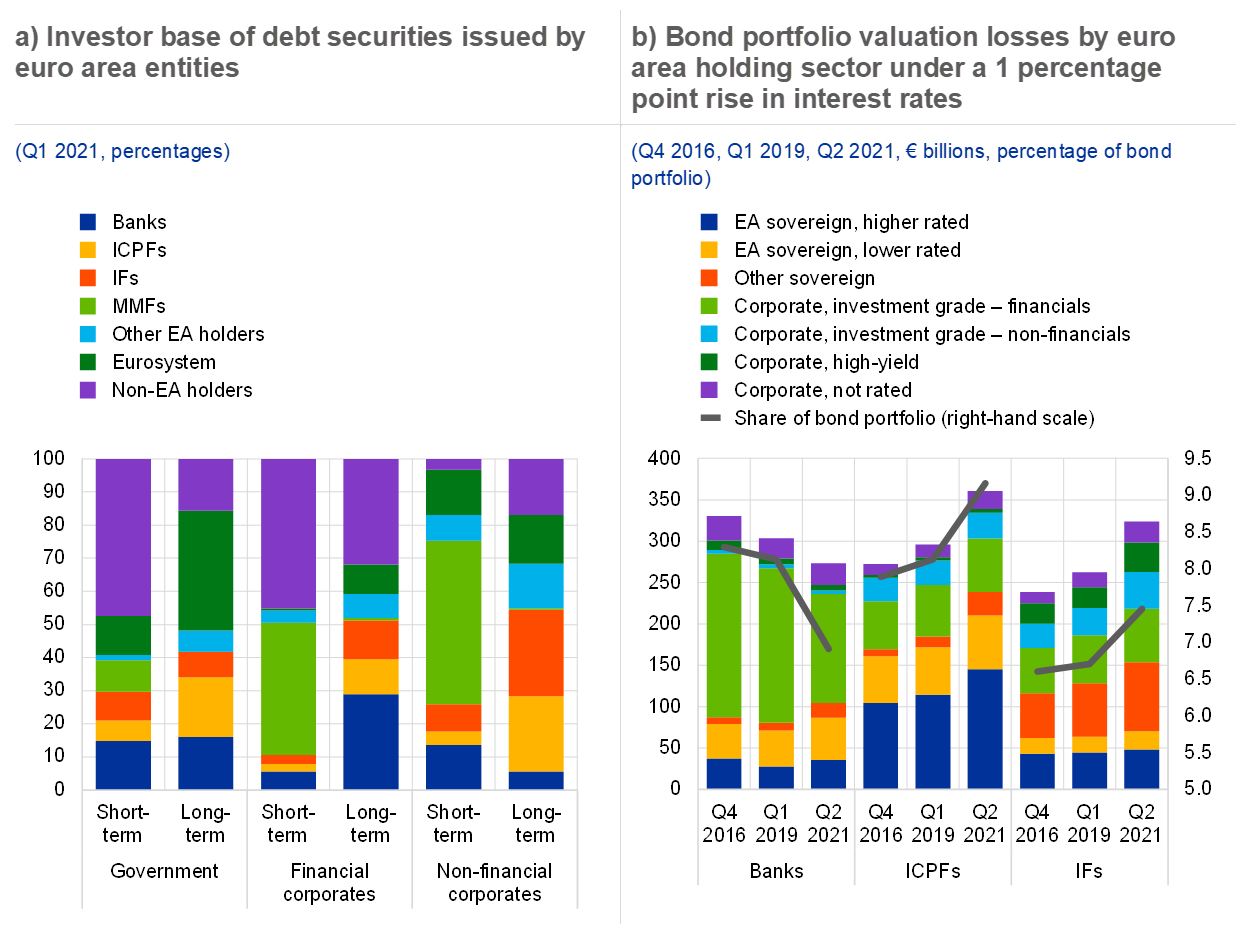
Sources: ECB (quarterly sectoral accounts, securities holdings statistics and Centralised Securities Database) and ECB calculations.
Notes: Panel a: the chart shows the breakdown for euro area holding sectors, while all non-euro area holders are aggregated in the purple category due to missing information. Short-term debt securities are defined as having an original maturity of less than one year. Panel b: lower-rated euro area sovereigns refer to countries with credit ratings below AA-. For the calculation, it is assumed that yields-to-maturity of all securities held increase by 1 percentage point. The changes in valuation due to an interest rate increase of one percentage point are calculated as the sum of modified durations multiplied by the amounts held at the security level multiplied by 0.01.
The duration exposure of non-banks has continued to rise, rendering their portfolios vulnerable to interest rate shocks. In their search for yield, non-banks have increased the duration of their debt securities portfolios over recent years. In the absence of hedging strategies, a 1 percentage point rise in yields would lead to bond valuation losses equivalent to 7.5% and 9% of the total fixed income portfolio of IFs and ICPFs respectively (see Chart 4.2, panel b). The wider implications of such valuation losses would depend on the macroeconomic environment. In an adverse scenario, where economic growth deteriorates and yields rise abruptly, such valuation losses could trigger outflows from IFs. Given the continued high liquidity risk among IFs, this could result in forced asset sales that amplify the shock in a procyclical manner (see Section 4.2). By contrast, an increase in yields could instead lead to net capital gains for ICPFs, as a decline in the value of their liabilities could more than offset their losses on assets due to their negative duration gap (see Section 4.3).
Box 7
The impact of loan and market-based credit supply shocks on euro area GDP growth
The global financial crisis put focus on the impact of loan supply on GDP growth – but since then credit to firms has also been increasingly supplied via debt securities. In the euro area, the credit supplied to non-financial corporations (NFCs) via debt securities, i.e. through market-based debt financing, has doubled from around 10% of total external debt financing to NFCs in 1999 to around 20% in 2020.[51] This structural shift raises the question of the extent to which market-based credit to NFCs, and disruptions in the supply of such credit, play a role in explaining GDP growth – a topic for which there is little empirical evidence so far.
More4.2 Bond funds could amplify market dynamics in a scenario of abruptly increasing global rates
After an extended period of strong inflows into riskier fund types, investors’ risk appetite has softened in recent months. Investor demand for riskier fund types surged at the end of 2020 on the back of rising optimism regarding the vaccination outlook and economic recovery, and this lasted well into 2021.[52] Since mid-2021, however, there have been signs that risk-taking is moderating, with investors rebalancing towards less risky assets. There have been outflows from some riskier fund types such as small cap and emerging market equity funds, while flows into money market funds, sovereign bond funds and high-quality corporate bond funds have increased.[53] Environmental, social and governance (ESG) funds have continued to grow rapidly and still exhibit comparably large inflows, albeit at a slightly slower pace (see Chart 4.3, panel a). Combined with other evidence, this suggests that ESG fund flows may depend less directly on financial performance than on investor sensitivity to environmental and social issues.[54]
Chart 4.3
Investors’ risk appetite moderated while demand for inflation hedges increased
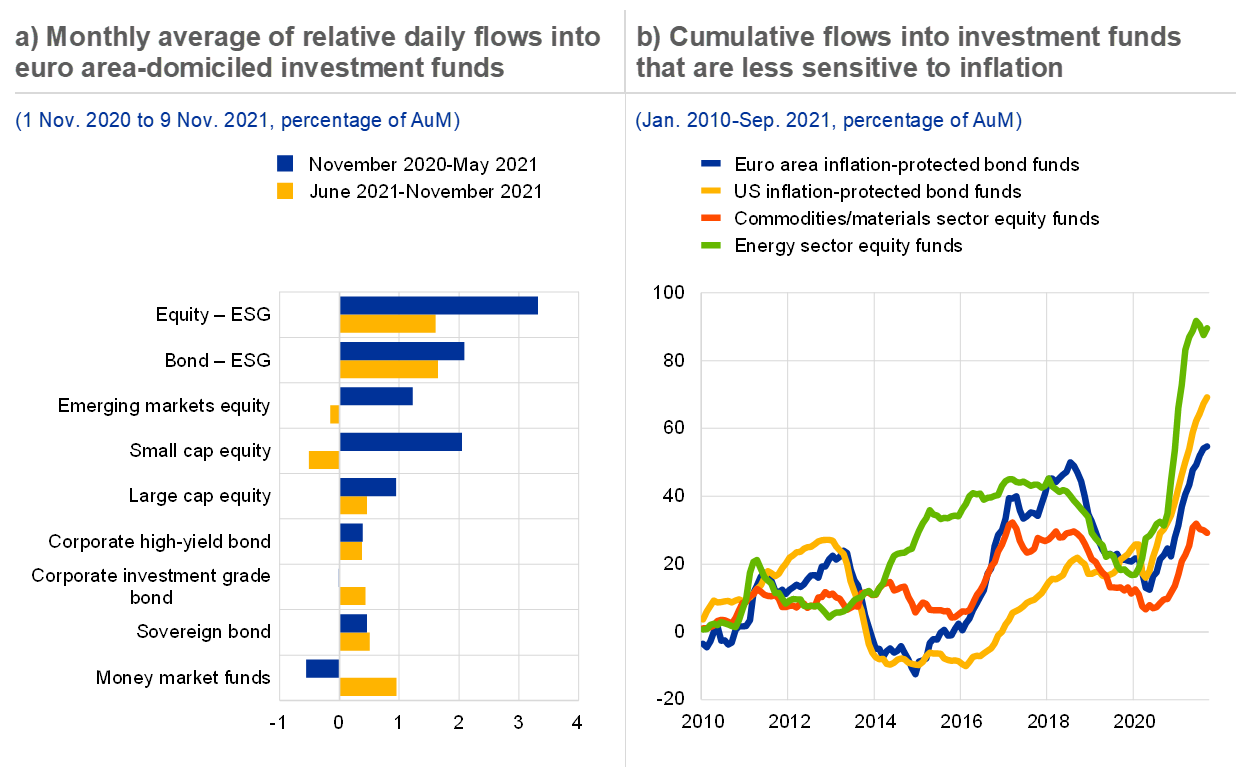
Sources: EPFR Global and ECB calculations.
Notes: AuM: assets under management. Panel a: the geometric monthly averages ensure comparability of the flows over time periods of different length. Panel b: euro area and US-domiciled inflation-protected bond funds are dedicated to investing in inflation-linked securities, which pay a yield that rises and falls with inflation and whose value is therefore immune to inflation changes.
Flows into inflation-protected bond funds and commodity or energy-dominated funds have increased sharply since the end of 2020, on the back of positive economic and inflation outlooks. The value of tangible asset classes such as commodities, materials and energy tends to increase as economic growth and inflation pick up. Funds exposed to these asset classes received strong inflows starting from the end of 2020 as investors sought profit opportunities and looked to hedge against inflation risks (see Chapter 2). Flows into energy and materials/commodities funds have stabilised more recently, while inflows into euro area and US inflation-protected bond funds are still growing strongly (see Chart 4.3, panel b).
Investment funds have taken on lower duration risk in recent transactions, although they have still accumulated an increased duration risk exposure in recent years. Investment funds have slowed their purchases of long-duration bonds and increased their exposures to bonds with relatively short maturities (see Chart 4.4, panel a). However, these recent developments have not reversed the steady increase in duration risk in the sector’s bond portfolio, which has accumulated over several years of search-for-yield behaviour (see Chart 4.2, panel b). This elevated duration exposure will leave the unhedged parts of investment funds’ bond portfolios vulnerable to valuation losses if there is a material increase in global yields (see Chapters 1 and 2). In an adverse economic scenario characterised by deteriorating growth and an abrupt rise in yields, such valuation losses could trigger outflows from bond funds.
Investment funds have further increased their exposure to credit risk, although this risk is unlikely to materialise in the short run. Once again, the sector absorbed a large share of the record high issuance of BBB and high-yield bonds by euro area non-financial corporations in the first two quarters of 2021 (see Chapter 2 and Chart 4.4, panel b), providing financing to these companies and increasing the credit risk on funds’ bond portfolios. However, this risk is unlikely to materialise in the short term as the economy is recovering and financing conditions remain favourable on the back of official sector support (see Section 4.1).
Chart 4.4
Investment funds have taken on duration and credit risk since the crisis, although there are first signs of rebalancing towards lower duration
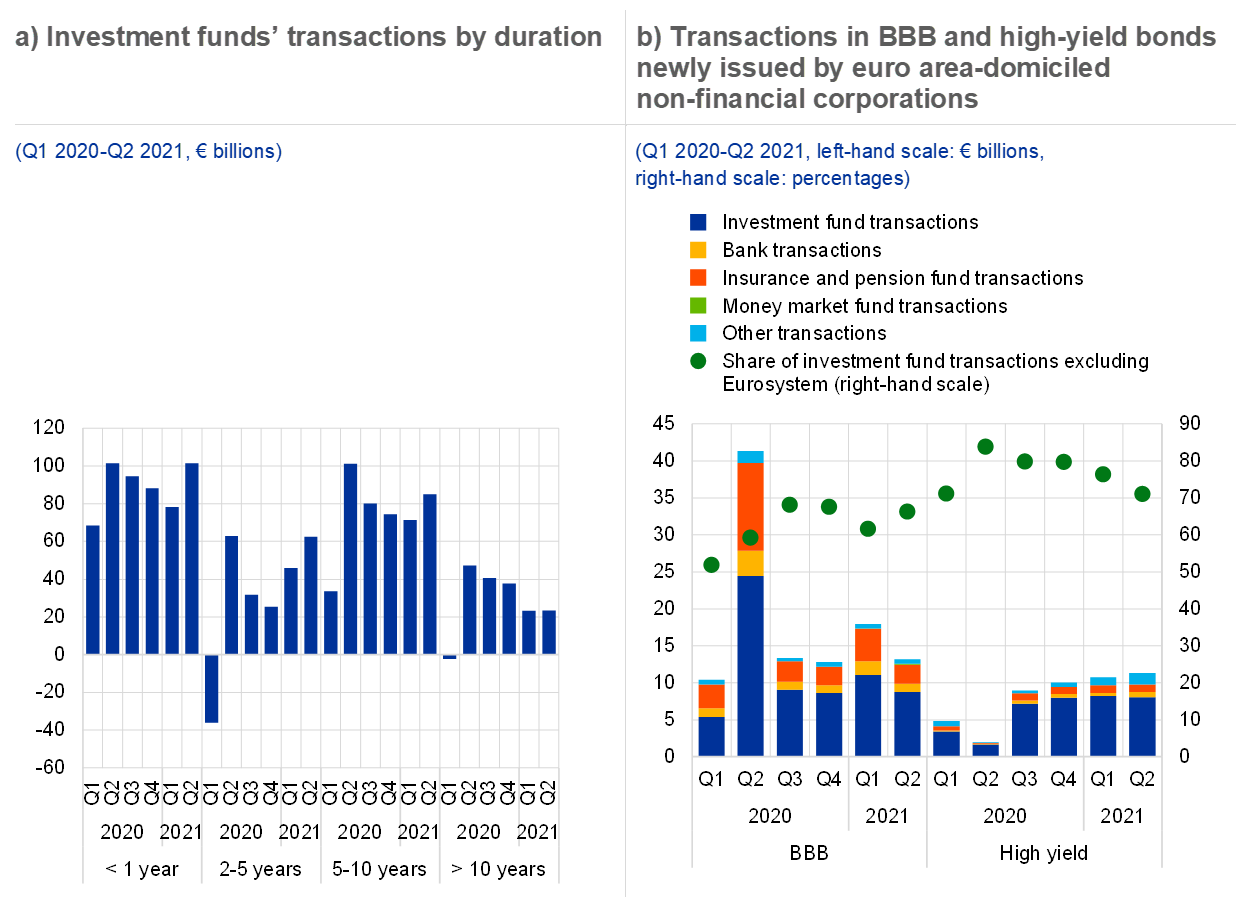
Sources: ECB (securities holdings statistics and Centralised Securities Database) and ECB calculations.
Note: Panel a: overall, investment funds are net buyers of duration as the duration in their bond portfolios shrinks continuously with bond holdings approaching their maturities. The chart illustrates a change in buying pattern for different duration buckets. Panel b: the data displayed only include long-term debt securities.
Real estate markets may give rise to additional risks. The real estate fund segment in the euro area is fairly small, with total assets standing at €1.1 trillion in August 2021 representing 6.5% of the total investment fund sector. This segment might, however, be vulnerable to future price corrections stemming from continued weakness in the commercial real estate market or from medium-term downside risks in the residential real estate market. Funds exposed to non-prime commercial real estate segments might be especially vulnerable in the short term (see Section 1.5). In addition, given the fact that open-ended real estate funds – which account for 80% of the total assets of real estate funds – are invested in highly illiquid assets, material price corrections could trigger procyclical sales and further exacerbate negative market dynamics.[55] This highlights the importance of better aligning the redemption terms of such funds with their asset liquidity (see Chapter 5).
Chart 4.5
Low liquidity in investment funds may contribute to procyclical investor dynamics
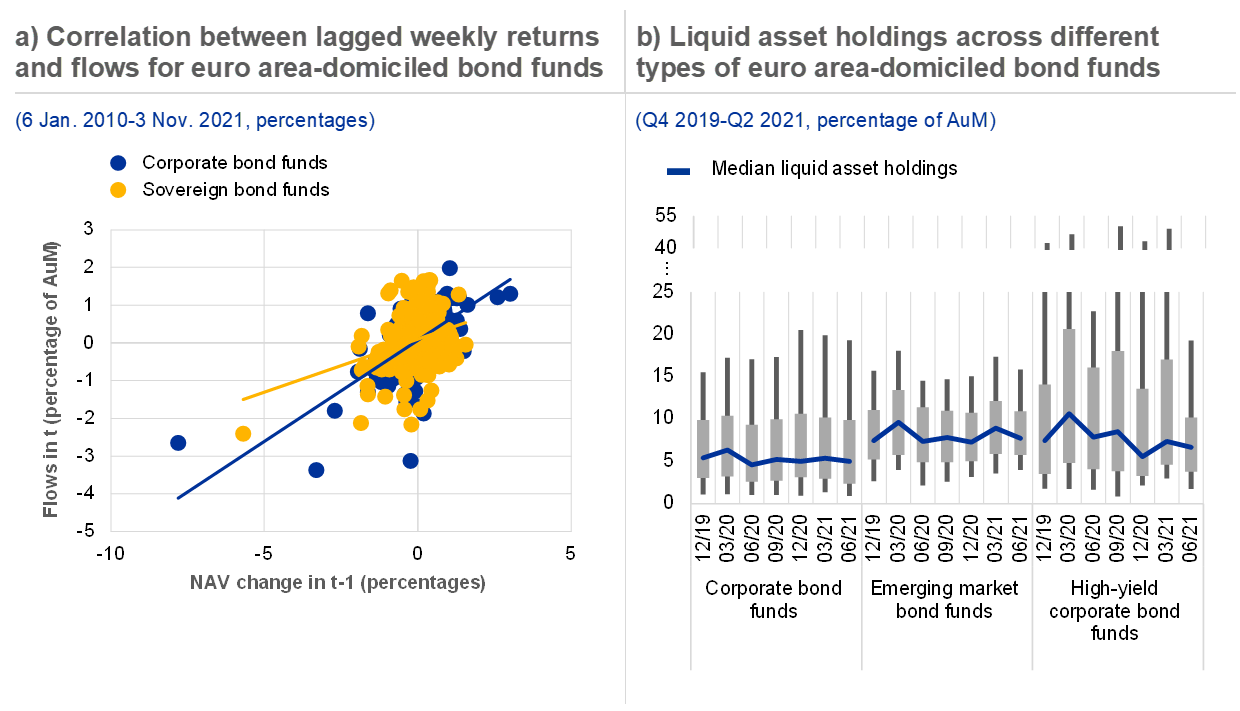
Sources: EPFR Global, Refinitiv, ECB (Centralised Securities Database) and ECB calculations.
Notes: Panel a: the correlation between returns in period t-1 and flows one period ahead (in t) based on weekly data since 2010. The chart shows single observations and regression lines for corporate and sovereign bond funds. NAV: net asset value. Panel b: distribution of liquid assets over total assets across funds by fund type. The boxes correspond to the interquartile range and the whiskers to the 10th-90th percentiles. Liquid assets include cash, cash equivalents and high-quality liquid asset bonds according to Basel liquidity coverage ratio requirements for HQLA (Commission Delegated Regulation (EU) 2015/61). Data refer to euro area-domiciled bond funds only. High-yield corporate bond funds primarily invest in high-yield bonds. This sample is distinct from the corporate bond fund sample, which can have a broader investment focus irrespective of rating quality. AuM: assets under management.
Liquid asset holdings in certain bond fund categories remain low, and there is evidence of pockets of high leverage in bond and hedge funds.[56] Both financial and synthetic leverage amplify returns in good times, but in bad times leverage amplifies losses. In addition, if leverage is built up synthetically by using derivatives for instance, margin calls could add to the liquidity needs of funds during periods of stress. Funds are also exposed more generally to high liquidity risks. Given the low liquid asset holdings in certain fund types (see Chart 4.5, panel b), large redemptions prompted by valuation losses or other shocks might force funds to sell assets that are less liquid. This could lead to a negative feedback loop between asset valuations and redemptions which could amplify adverse market dynamics. In addition, investors tend to behave more procyclically in riskier and less liquid fund segments, such as corporate bond funds (see Chart 4.5, panel a), as well as in more highly leveraged funds.[57] These structural vulnerabilities highlight the need to strengthen the resilience of the investment fund sector from a macroprudential perspective (see Chapter 5).
4.3 Insurers’ financial condition improves, though the sector faces several medium-term headwinds
The euro area insurance sector continued to withstand the impact of the pandemic and other shocks well. Overall insurance sector profitability improved in the first half of 2021 (see Chart 4.6, panel a). Underwriting and investment income went up, in line with the economic recovery and buoyant financial markets (see Chapters 1 and 2). Claim-related losses and expenses as a proportion of earned premiums – known as the combined ratio – decreased further and remained well below 100% for most non-life insurers (see Chart 4.6, panel b). The improved combined ratios resulted from (i) subdued claims volumes in some business lines (e.g. health), and (ii) premium and rate increases at recent renewals (see Chart 4.7). This solid performance, coupled with a slight increase in long-term risk-free interest rates, enabled insurers to continue accumulating capital during the first half of the year, with the median Solvency Capital Requirement (SCR) ratio at over 214%, significantly higher than the 100% regulatory requirement (see Chart 4.6, panel b).
Chart 4.6
Insurers’ profitability and solvency ratios have improved, supported by solid underwriting and investment income
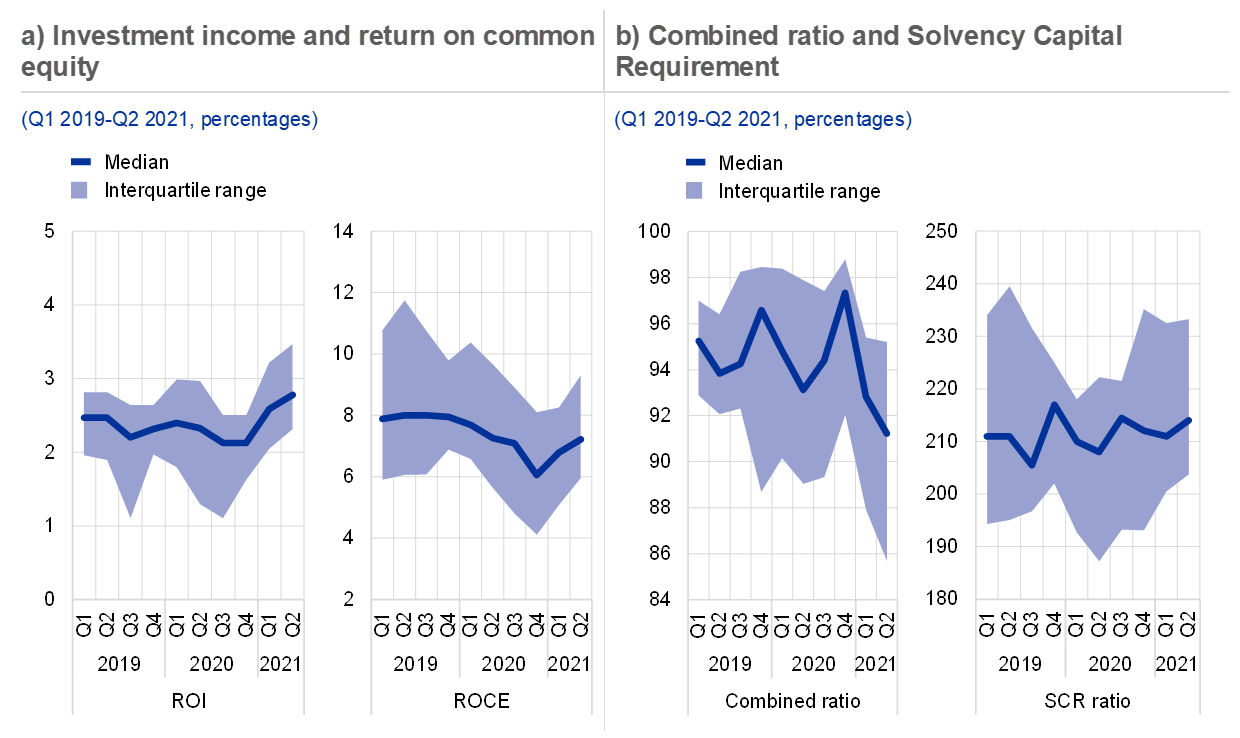
Sources: Bloomberg Finance L.P. and ECB calculations.
Notes: Based on a sample of up to 25 large euro area insurers offering life and non-life products. The full sample is not covered in 2021 due to reporting lags. Panel a: ROI: return on investment; ROCE: return on common equity; SCR: Solvency Capital Requirement.
The outlook for insurers’ profitability and credit ratings has also been improving on the back of supportive trends for demand, pricing and cost-cutting. Demand for insurance products has increased amid growing risk awareness among corporates and households coupled with the strong and swift economic recovery (see Chapter 1). This is reflected in the growth in life (mainly driven by sales of unit-linked products) and non-life gross written premiums (see Chart 4.7, panel a). Non-life insurance lines are still benefiting from a positive pricing environment (see Chart 4.7, panel b), with renewals made at sustained double-digit price increases for the last five quarters in Europe. A second shift relates to consumer demand for digitalisation, which has accelerated insurers’ initiatives to build up new digital capabilities, paving the way for cost reductions and enhanced profitability. These improvements in the operating environment are reflected in the increasing changes from negative to stable rating outlook for some insurers.
Chart 4.7
Rising risk awareness amid the upbeat cyclical economic momentum has supported the increase for insurance demand in a positive pricing environment
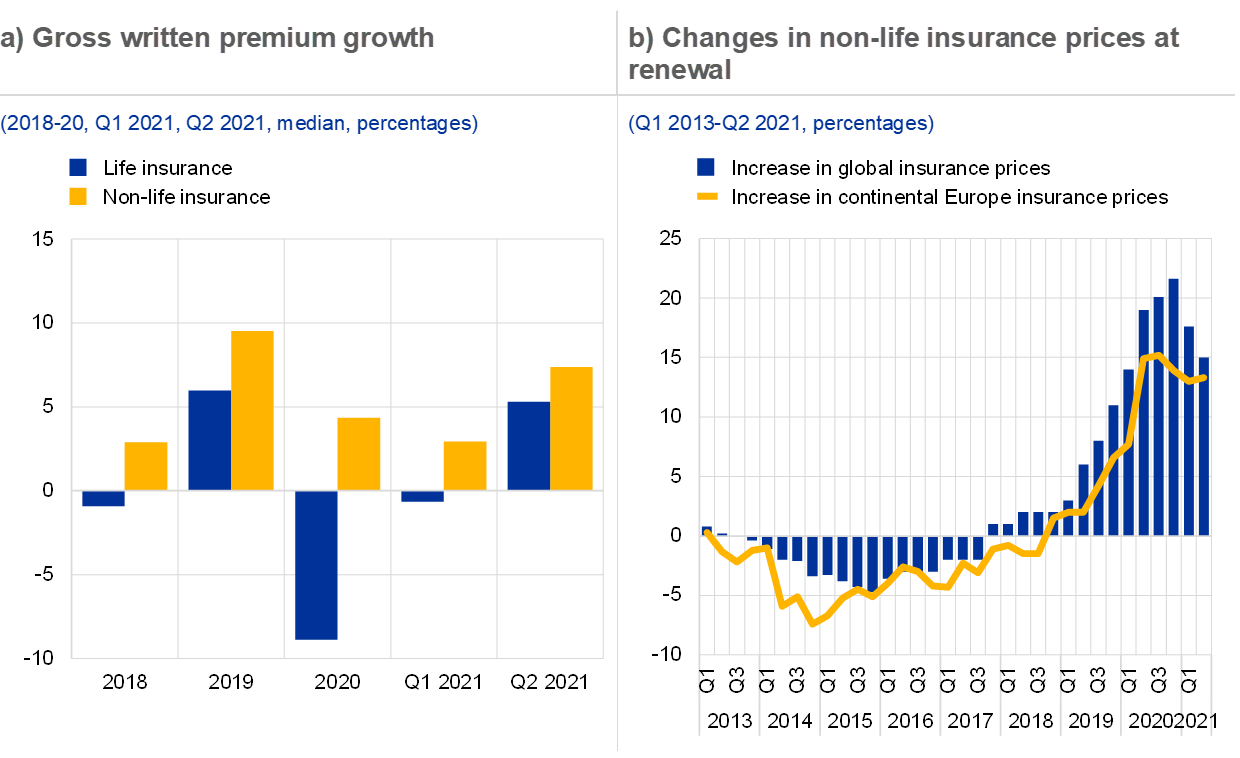
Sources: Marsh, Bloomberg Finance L.P., ECB Insurance Corporations Operations (ICO) dataset and ECB calculations.
Note: Panel a: annual numbers refer to total insurance corporations in the euro area and quarterly numbers are based on available data of a sample of 25 large euro area insurers offering life and non-life products.
Despite the improved outlook, insurers still face conjunctural and structural challenges, including from the cost of cyber incidents. While pandemic-related claims have been lower than expected, there is still considerable uncertainty in some euro area jurisdictions about some 2020 claims with pending resolution of coverage disputes (mainly in life, health and business interruption lines). Separately, the pandemic has accelerated the digitalisation of the economy, leading to an increase in the amount and cost of cyber incidents, including several high-profile breaches.[58] Despite the potentially systemic[59] and cross-border nature of cyber risk, cyber insurance still represents a small proportion of the global non-life insurance market. Patchy data and a poor understanding of cyber risks by both underwriters and policyholders remain major obstacles for greater growth in this business line and hamper the closing of the cyber insurance protection gap.
Chart 4.8
Insured losses from secondary, weather-related perils are rising, while catastrophe bond returns continue to attract investors

Sources: Swiss Re, ECMWF, Copernicus Climate Change Service (C3S), www.artemis.bm and Steve Evans Ltd., Bloomberg Finance L.P. and ECB calculations.
Notes: Panel a: 2021 is a year-to-date estimate taking into account total insured losses from natural catastrophes with available data and best estimates up to beginning of November 2021. Panel b: S&P 500 and EURO STOXX 50 are used as benchmark indices for US and euro area stocks respectively.
Notwithstanding some limited increases in long-term yields during the first half of 2021, the protracted low interest rate environment weighs on insurer profitability and incentivises risk-taking.[60] While the biggest issues arise for small and medium-sized life insurers offering longer-term products with guaranteed returns, low rates affect the sector as a whole through different channels.[61] Despite a recent improvement in profitability, pressure for further risk-taking remains high in the low interest rate environment. In particular, insurers have (i) increasingly shifted their fixed income portfolios towards higher yielding bonds (see Chart 7 in the Overview, panel b), (ii) gradually increased their exposures to higher yielding but potentially riskier alternative assets,[62] and (iii) increased their duration exposure (see Chart 4.2, panel b). An increase in interest rates might benefit insurers’ capitalisation in a benign scenario characterised by an improvement in the economic outlook, given negative duration gaps.[63] But in a stress scenario featuring a sharp and sudden increase in risk premia, the negative impact on insurers could be significant, especially if they faced correlated and larger than expected losses under strong liquidity pressures. For this reason, the Solvency II framework should introduce a symmetric volatility adjustment and more stringent liquidity measures for insurers with a vulnerable liquidity profile (see Section 5.3).
Climate change poses significant and increasing challenges for the euro area insurance sector.[64] Global insured losses from natural catastrophes in the first half of 2021 made this the second-highest six-month period on record after 2011. The summer floods and wildfires in Europe, together with a worse than average Atlantic hurricane season, have also generated significant losses, setting 2021 on course to be one of the most expensive years for (re)insurers ever in terms of natural hazards.[65] Insured losses from both primary and secondary perils have been on an upward trajectory in recent years (see Chart 4.8, panel a).[66] In Europe, secondary perils have already caused significantly more insured losses than primary perils in the last decade. The rise in losses from weather-related secondary perils underscores how climate-related physical risks are already more frequent and have a larger average magnitude than before. In the medium term, increasing risks related to climate change may also lead to lower insurance coverage against natural catastrophes which would worsen the macroeconomic and fiscal impact of such events.[67] This reaffirms the need to act quickly to tackle the risk of a growing insurance protection gap.
The natural catastrophe bond market continues to grow, providing stable extra funds to reinsurance capacity.[68] Catastrophe bonds have been issued at a record-breaking pace in 2021 (see Chart 4.8, panel b), despite the increasing trend of natural catastrophe events and insured losses. In the ongoing search-for-yield environment, natural catastrophe bonds continue to attract inflows as they offer significantly uncorrelated and relatively high returns. In addition, investors prefer the more liquid, transparent and better understood nature of catastrophe bonds (which focus on primary perils) over other segments of the insurance-linked securities (ILS) market (like private ILS funds and collateralised reinsurance) that deal with the greater uncertainty of secondary perils and have suffered some unexpected losses during the last year.
5 Macroprudential policy issues
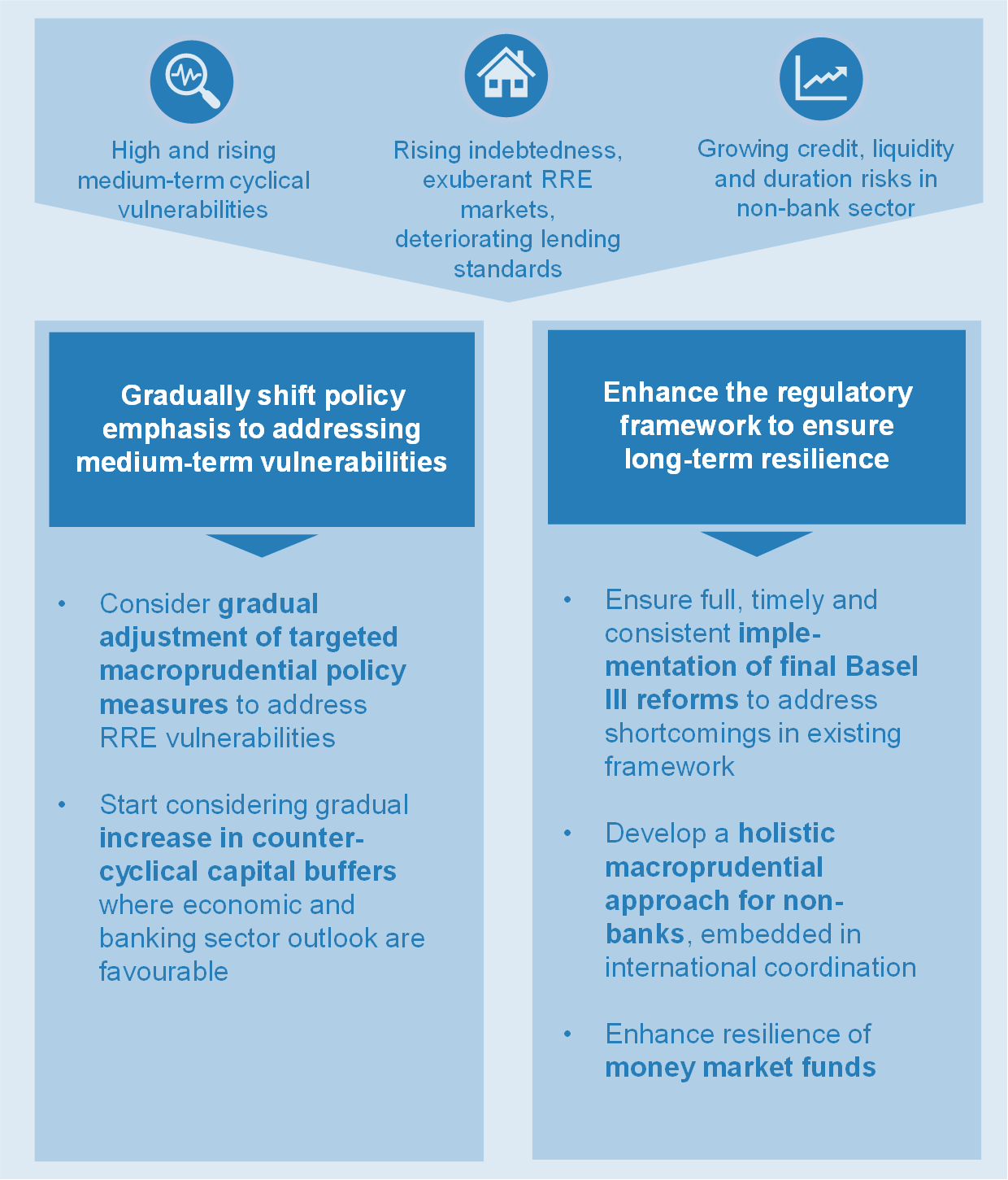
5.1 Emphasis gradually shifts from providing short-term policy support to addressing emerging vulnerabilities
As the economic recovery proceeds, macroeconomic policies that helped limit economic scarring at the height of the pandemic are being gradually adjusted. Given the rebound of the euro area economy sparked by the progress made in the vaccination campaign and the subsequent easing of containment measures, fiscal stimulus has been gradually reduced. It is expected to decline further, from 4.6% of GDP in 2021 to 1.5% and 1.2% in 2022 and 2023 respectively (see Chapter 1). Where not removed completely, fiscal support measures have become more targeted and focused on strengthening solvency of viable firms rather than broad liquidity support, through grants and quasi-equity instruments. At the same time, monetary policy has continued to underpin the recovery by maintaining accommodative financing conditions (see Chapter 2 and Box 8).
Since the May 2021 FSR, a number of financial sector policies that helped preserve financial stability during the pandemic have expired or have been adjusted further. Almost all loan moratoria and government guarantee schemes which helped to support banks’ asset quality have now elapsed, while the recommended restrictions on dividend distributions and share buybacks that had been imposed on euro area banks were lifted in September 2021 (see Chapter 3).[69] At the onset of the pandemic, ECB Banking Supervision allowed banks to temporarily operate below the level of capital defined by Pillar 2 guidance (P2G) and the combined buffer requirement until the end of 2022 at the earliest, making the timeline for P2G replenishment conditional on economic conditions.[70] After the latest stress test results, the ECB confirmed the previously stated timeline for P2G replenishment.
Chart 5.1
Signs of further loosening of RRE lending standards are accompanied by increasing systemic risk measures relevant for macroprudential capital buffers

Sources: Panel a: European Datawarehouse GmbH (EDW), ECB and ECB calculations. Panel b: Eurostat, ECB and ECB calculations.
Notes: Panel a: data available for Belgium, Germany, Spain, France, Italy, the Netherlands and Portugal, total weighted by GDP. The dataset includes loan-level data for asset-backed securities transactions and may therefore not accurately represent the overall lending standards associated with new mortgage loans. In addition, an additional bias may arise as banks may not report the characteristics of defaulted loans. While data coverage for some countries is low, comparison with other data sources shows a high level of congruence with the information in the EDW data. LTI: loan-to-income ratio; LTV: loan-to-value ratio; RRE: residential real estate. Panel b: the d-SRI measures the build-up of risks from credit developments, real estate markets, asset prices, and external imbalances; it has better early warning properties for financial crises in European countries than the Basel credit-to-GDP gap. The d-SRI is based on Lang, J.H., Izzo, C., Fahr, S. and Ruzicka, J., “Anticipating the bust: a new cyclical systemic risk indicator to assess the likelihood and severity of financial crises”, Occasional Paper Series, No 219, ECB, 2019. The yellow area is the 0.25-0.75 interquartile range.
As the recovery progresses, policies should gradually shift to addressing emerging medium-term vulnerabilities in a proportionate and targeted manner. Most notably, residential real estate (RRE) vulnerabilities are on the rise. Although they vary across countries, indicators of household indebtedness, credit and price developments, and overvaluation have risen since the start of the pandemic (see Overview, Chapter 1 and Box 2), while the signs of the loose or deteriorating RRE lending standards in the euro area that had been noted before the pandemic broke out are still there (see Chart 5.1, panel a).[71] Consistent with the role of macroprudential policy as first line of defence in preserving financial stability, a gradual shift towards addressing medium-term vulnerabilities is therefore warranted. In order not to hamper the economic recovery and the ability of banks to provide credit, such action should be proportionate and should target the identified risks.
Countries where emerging vulnerabilities are primarily driven by RRE markets should consider gradually adjusting targeted macroprudential policy measures. Some countries have adopted capital measures, such as higher risk weights, which would enhance banks’ loss-absorption capacities if accumulated housing market risks were to materialise (see Table 5.1). Moreover, several euro area countries have implemented borrower-based macroprudential policies, such as loan-to-value (LTV) or debt service-to-income (DSTI) limits.[72] However, in some countries that received a European Systemic Risk Board (ESRB) warning or recommendation on medium-term vulnerabilities in the RRE sector in 2019,[73] either no macroprudential measures are active or those that are seem to have room for tightening. The implementation (or further tightening) of macroprudential measures should therefore be considered in some of the countries where RRE vulnerabilities are continuing to build up, especially in relation to the deterioration of lending standards and growing household indebtedness. The timely activation of borrower-based measures helps to ensure that borrowers and banks are resilient, while they can be designed and calibrated to limit side effects.[74] Many countries have also tailored the calibration of these measures to allow different limits for different types of borrower (e.g. first-time or buy-to-let buyers) and to allow a certain proportion of new lending to be above the limits. Such targeted limits and allowances can prevent access to mortgage credit from becoming impaired for certain groups of borrowers (e.g. young or low-income borrowers) and can therefore keep the undesired side effects of borrower-based macroprudential measures to a minimum. “Hybrid” measures, such as risk weights calibrated according to different levels of lending standards (e.g. LTV or DSTI), may also be used to increase banks’ resilience while targeting the riskiest borrower segments.
Table 5.1
Overview of macroprudential instruments implemented to address RRE vulnerabilities in euro area countries

Sources: ESRB and national notifications.
Notes: In France, a borrower-based measure will become legally binding as of 1 January 2022. In the Netherlands, the announced Article 458 CRR measure scheduled for Q3 2020 (LTV-dependent risk weight floor for domestic IRB mortgage loan portfolios) was postponed in March 2020 in light of the pandemic and should come into effect on 1 January 2022. In Portugal, the calculation of the DSTI incorporates the impact of an interest rate increase. In Slovenia, the DSTI and maturity limits are legally binding, while the LTV limit is implemented through a recommendation. IRB mortgages: mortgages granted by banks following the internal ratings-based approach; STA mortgages: mortgages granted by banks following the standardised approach.
As signs of medium-term vulnerabilities continue to emerge, authorities could start considering gradual increases in macroprudential capital buffers, where economic and financial conditions allow. Where justified by rising cyclical systemic risk indicators and relevant credit indicators (see Chart 5.1, panel b), increases in the countercyclical capital buffer could be considered. Considering timely CCyB increases is important to allow for the default one-year implementation lag after announcement as well as gradual policy changes. Such increases should take place when supported by favourable economic and banking sector conditions, such as sufficient capital generation capacity, to avoid hampering the economic recovery and impairing the provision of credit. It is reassuring that the latest stress test results show that under the baseline economic scenario, banks would be able to increase their relatively strong capital ratios still further.[75] This implies that unless economic conditions deteriorate markedly, there are unlikely to be bank credit supply constraints in most euro area countries. Overall, the prudential action should be mindful of the potential effect of the European banking supervision timeline for replenishing the P2G and the implementation of the final leg of Basel III reforms on the supply of credit.
More generally, relatively favourable macro-financial conditions in some countries may provide an opportunity to create additional macroprudential policy space by increasing the amount of releasable capital buffers. The pandemic has been a reminder that large, disruptive systemic shocks may occur independently of a country’s position in the financial cycle to respond to unexpected shocks. A higher amount of releasable buffers would strengthen the ability of macroprudential authorities to act countercyclically even in the event of such shocks.
Box 8
The role of financial stability in the ECB’s new monetary policy strategy
Financial stability is a precondition for price stability and vice versa. In recognition of this fundamental tenet, the ECB’s recent strategy review included a thorough assessment of whether financial stability considerations should play a role in monetary policy decisions at all – and if yes, in what form.[76] The analyses covered a wide range of relevant issues, including the side effects of monetary policy on financial stability, the interactions between monetary and macroprudential policies, whether the medium-term orientation of the ECB’s price stability objective can cater for financial stability considerations and how relevant financial stability analyses could be integrated into the analytical framework based on which monetary policy decisions are taken. This box summarises the most relevant aspects and their implications for monetary policy.
More5.2 Enhancing the regulatory framework to ensure the long-term resilience of the financial system
Structural improvements to the regulatory framework, in both the bank and the non-bank sectors, will support the financial system and bring long-term benefits. In the banking sector, on 27 October 2021 the European Commission issued legislative proposals for the EU-wide implementation of the final set of Basel III reforms agreed by the Basel Committee on Banking Supervision (BCBS) in 2017. For non-banks, policy options to address risks in money market funds (MMFs) are being finalised at both the international and the European level, while future policy should target a broader set of entities and activities, including investment funds and margining practices.
5.2.1 Finalising the implementation of Basel III
Implementing the final Basel III reforms is essential to address the shortcomings of the existing framework and to further enhance the long-term resilience of the financial system. Recent events have demonstrated that the international regulatory initiatives introduced after the global financial crisis made the financial system more resilient and more able to withstand a large unexpected shock such as that caused by the COVID-19 pandemic. The final package of Basel III reforms aims to address the remaining shortcomings in the existing framework, among other things by introducing an output floor.[77]
The ECB, the European Banking Authority (EBA) and a large group of European national supervisors and central banks are committed to the full, timely and consistent implementation of the final set of Basel III reforms.[78] The EU must continue to uphold its commitment to international financial standards and cooperation. Implementation approaches that are inconsistent with international agreements should be avoided and, in any case, do not remedy deficiencies in the existing framework. The Commission’s legislative proposals for amending the Capital Requirements Regulation and the Capital Requirements Directive (“CRR III” and “CRD VI”) to implement the final Basel III reforms, published on 27 October, are therefore welcomed. The ECB will publish its opinion on the proposals in due course.
The finalisation of the Basel III reforms as internationally agreed will lead to a level playing field across banks, with only moderate phase-in costs. The impact of the reforms will vary across banks, depending on their business models, size and degree of reliance on internal models. The overall increase in capital is not expected to be significant, save for a few banks that have benefited the most from reduced capital requirements thanks to risk optimisation from the use of internal models. Recent impact studies by the ECB and the EBA show that implementing the final Basel III reforms is likely to entail only modest transitional costs which will be outweighed by the long-run economic benefits.[79] Further delays in the implementation of the final leg of the reforms would only postpone, without any appreciable benefits, the necessary adjustments in the banking sector.[80]
5.2.2 Strengthening the policy framework for non-banks
The policy framework for non-banks should be strengthened to ensure the financial system is resilient. Given the increasing role played by non-banks in financing the real economy and their interconnections with the wider financial system, it is crucial for risks in the sector to be tackled from a system-wide perspective. The market turmoil in March 2020 highlighted the need to strengthen the policy framework for non-bank financial intermediaries,[81] and there has been considerable progress with regard to the international policy agenda for MMFs in 2021. The next step is to develop policies for open-ended investment funds and margining practices.[82] Strengthening the resilience of non-banks from a macroprudential perspective will help mitigate systemic risk in good times, while also reducing the likelihood of the need for costly policy interventions in a crisis.
The reforms should be embedded in international policy coordination. The Financial Stability Board (FSB) has recently issued policy proposals to tackle vulnerabilities in MMFs internationally.[83] The FSB proposals aim to increase the resilience of MMFs by reducing liquidity mismatches and unintended cliff effects arising from any breaches of regulatory requirements, enhancing loss absorption and imposing costs on redeeming investors. Against this background, the ESRB is discussing policy options which could inform the European Commission’s review of the EU’s MMF Regulation[84] in 2022.
Chart 5.2
A higher share of MMF public debt holdings would help managers to deal with large and unexpected outflows, while outstanding short-term public debt would be more than sufficient to meet increased demand
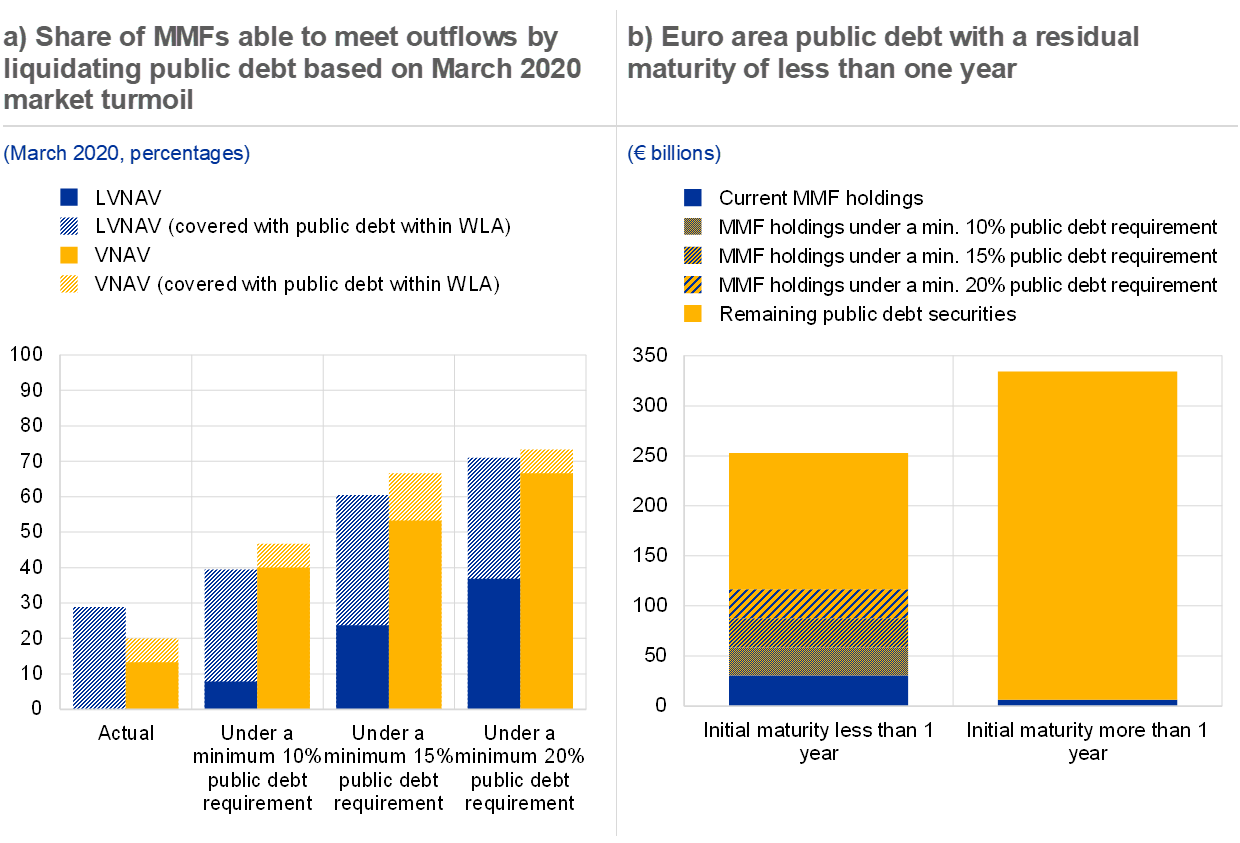
Sources: Crane Data, ECB securities holdings statistics by sector and ECB calculations.
Notes: Panel a) shows the share of MMFs whose public debt at the end of January 2020 was enough to cover their largest weekly outflows in March 2020 for actual and hypothetical values of public debt holdings, including existing government reverse repo assets. This assumes that MMFs unwind their government reverse repo assets and use the proceeds to purchase government bonds outright. The shaded area shows the share of funds that could cover their outflows with public debt that is within their weekly liquid assets (WLA), while the solid area refer to the share of funds that could cover their outflows with public debt that is in excess of their WLA. Panel b) shows short-term euro area government debt (euro-denominated) outstanding with an initial maturity of less than one year (left-hand bar) and longer-term debt with a residual maturity of less than one year (right-hand bar). The shaded parts of the left-hand bar show the additional amounts that euro-denominated MMFs would need to hold if they were required to hold 10, 15 or 20 percentage points of public debt.
Strengthening the asset liquidity of private debt funds should be a key element of MMF reforms in the EU. The overall liquidity requirements should be raised and private debt MMFs required to hold a minimum share of their assets in liquid short-term public debt as a complement to the existing daily and weekly maturing asset requirements.[85] This would limit liquidity mismatches in these funds and diversify their sources of liquidity, thereby helping managers to meet large and unexpected outflows. ECB analysis shows that public debt holdings of, say, 15% would have allowed around 61% of low-volatility net asset value (LVNAV) funds (and 67% of variable net asset value (VNAV) funds) to meet their weekly outflows during the March 2020 market turmoil without having to draw down their other liquidity buffers or sell private debt assets (see Chart 5.2, panel a).[86] To further increase the resilience of MMFs, any impediments to the use of all their liquidity buffers during a crisis should be removed. In addition, the consistent implementation of liquidity management tools, such as anti-dilution levies, could complement the reform agenda.
The calibration of liquidity requirements should take into account possible costs and constraints, while aiming to strengthen the resilience of MMFs. First, if MMFs are required to hold a certain share of public debt, this might lead to a reduction in short-term funding to banks and non-financial corporations (NFCs). This effect would probably be small for NFCs, as MMFs would be more likely to reduce their holdings of higher-rated bank debt than NFC debt, whereas banks would have good alternative sources of short-term funding, including deposits and interbank liabilities.[87] Second, the requirements would increase the footprint of MMFs in short-term public debt markets. However, ECB analysis shows that the amount outstanding of euro-denominated short-term public debt would be more than sufficient to absorb the expected increased demand from a 5-15% public debt requirement (see Chart 5.2, panel b). Finally, public debt requirements might reduce the yields that MMFs could offer should a part of the private debt assets be replaced by lower-yielding public debt. Overall, the calibration should ensure that any costs would be outweighed by the benefit of increased resilience.
In addition, policies for the broader investment fund sector should address liquidity mismatches as a key priority. An important objective is to ensure that asset liquidity is better aligned with redemption terms. For funds investing in illiquid assets such as real estate, minimum notice periods or lower redemption frequencies are often in place in many jurisdictions. Similar measures could also be considered for funds that currently offer daily liquidity but invest in relatively illiquid assets such as loans or high-yield debt. Liquidity buffers or limits on less liquid assets would likewise help to bolster the resilience of funds that offer daily redemptions and invest in less liquid assets. Liquidity management tools, such as swing pricing or anti-dilution levies, may be complementary and can help to reduce first-mover advantages. However, such tools are often difficult to calibrate and can be difficult to deploy in crisis situations without generating adverse effects. In addition, they are not effective in reducing the underlying liquidity mismatch vulnerability.
Furthermore, it is important to understand and tackle the risks associated with leverage in the non-bank financial sector. To monitor and address vulnerabilities arising from the use of leverage, it is important to have globally consistent leverage metrics. Further work should be undertaken internationally to assess the extent and distribution of non-bank leverage, including from the use of derivatives to generate synthetic exposure. This will help inform the policy discussion with a view to mitigating the systemic risk arising from the use of leverage outside the banking sector.
International work on margining practices should aim to increase transparency, reduce excessive margin procyclicality and ensure that non-banks are better prepared for margin calls. As the initial margins collected by some central counterparties (CCPs) may be overly procyclical (too low in good times and/or too high in bad times), their fluctuations can amplify liquidity stress and lead to selling pressures in financial markets. Changes in initial margins during March 2020 suggest that it is important to better understand the models used by CCPs to calibrate initial margin requirements and to possibly review such models (see Box 9).[88] The transparency and predictability of initial margin models used by both CCPs and clearing members should also be improved to ensure that both banks and non-banks are better prepared for margin calls. In addition, all types of non-bank should have adequate liquidity management frameworks in place which ensure they are sufficiently prepared to meet margin calls. This will mitigate liquidity risk across the system, including among MMFs which are used for storing cash, as well as among investment funds, insurers and pension funds, which use derivatives and are therefore subject to margin calls.[89]
Box 9
Lessons learned from initial margin calls during the March 2020 market turmoil
Margin requirements on derivatives portfolios increased significantly in March 2020, exacerbating liquidity stress as entities took action to meet margin demands. In particular, some non-bank financial entities met margin calls by redeeming shares in money market funds, selling bonds or borrowing in repo markets.[90] Extraordinary interventions by public authorities were ultimately crucial in stemming stress in these markets.[91] While margin consists of two main components – initial margin and variation margin – this box focuses on initial margin (IM), since it is subject to model risk and depends heavily on the calibration choices of central counterparties (CCPs) (for centrally cleared transactions) or counterparties (for non-centrally cleared transactions).[92] As IMs are calibrated to reflect possible future changes in market prices, they are sensitive to market volatility. However, if IMs are overly procyclical (too low in good times and/or too high in bad times), their movements can amplify liquidity stress and lead to selling pressures in financial markets.
More5.3 Other ongoing policy initiatives that support euro area financial stability
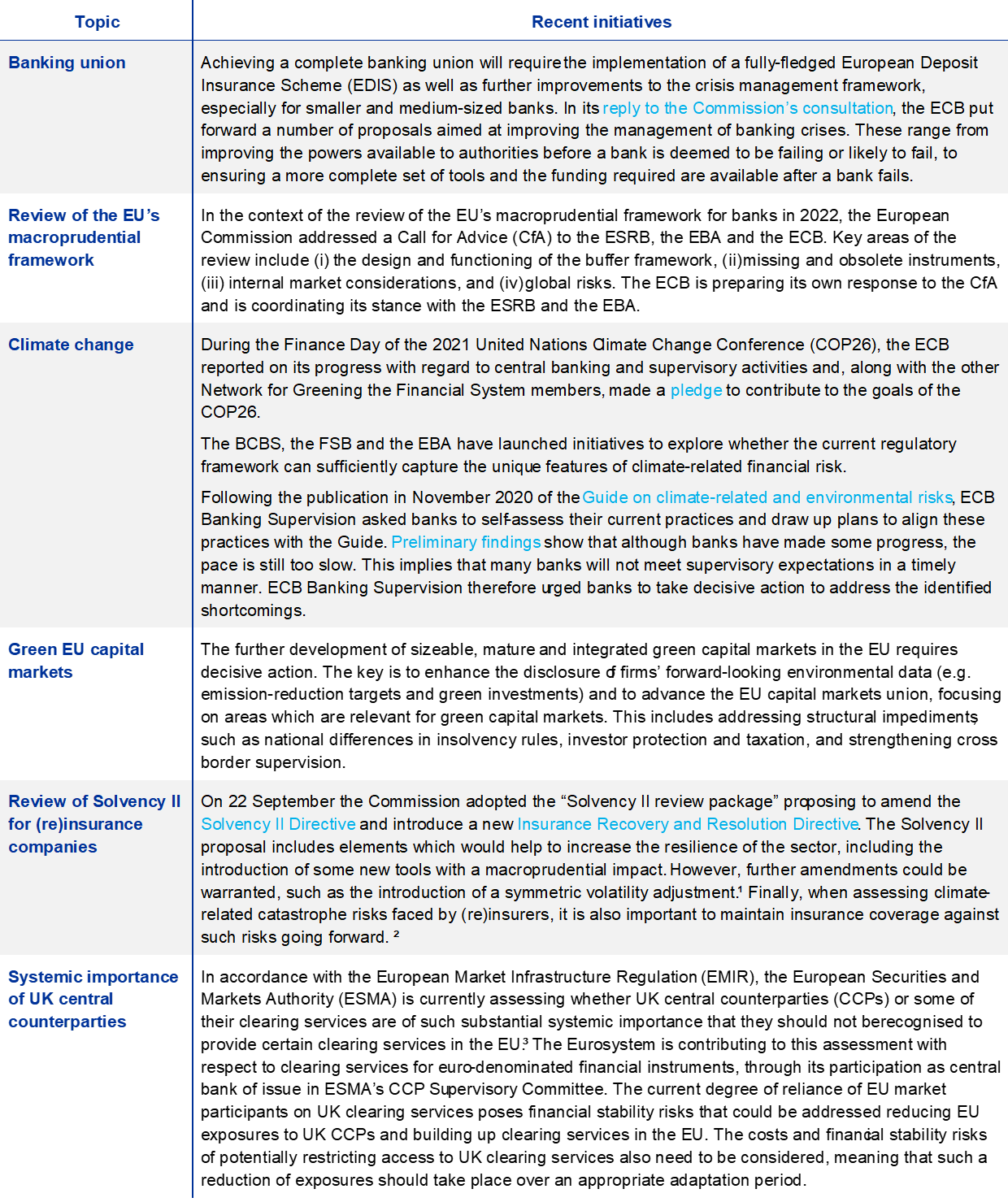
1) See also “Response letter to a consultation of the European Commission on the review of Solvency II”, ESRB, 16 October 2020; “ESRB Response to the EIOPA Consultation Paper on the 2020 review of Solvency II”, ESRB, 2020; and “Enhancing the macroprudential dimension of Solvency II”, ESRB, February 2020.
2) See Fache Rousová, L., Giuzio, M., Kapadia, S., Kumar, H., Mazzotta, L., Parker, M. and Zafeiris, D., “Climate change, catastrophes and the macroeconomic benefits of insurance”, Financial Stability Report, European Insurance and Occupational Pensions Authority, July 2021.
3) See “ESMA publishes methodology for assessing third country CCPs systemic importance”, July 2021.
Special features
Bank capital buffers and lending in the euro area during the pandemic
Bank capital buffers are supposed to help banks to absorb losses while maintaining the provision of key financial services to the real economy in times of stress. Capital buffers that are usable along these lines should lessen the damaging effects that can arise from credit supply shortages. Making use of buffers entails using the capital space on top of regulatory buffers and minimum requirements and, in case of need, also using regulatory buffers. This special feature analyses bank lending behaviour during the pandemic to gain insights into banks’ propensity to use capital buffers and the impact of the regulatory capital relief measures implemented by the authorities. From a macro perspective, the euro area banking system as a whole was able to meet credit demand and withstand stress. However, this aggregate view reflects several factors, including the impact of extraordinary policy measures. A micro perspective thus can help to comprehend how the capital buffer framework and capital releases affected banks’ behaviour during the pandemic. The microeconometric analysis performed in this special feature shows that the banks that had limited capital space above regulatory buffers adjusted their balance sheets by reducing lending which could be interpreted as an attempt to defend capital ratios. This suggests that they were unwilling to use capital buffers. The results also show that the regulatory capital relief measures adopted during the pandemic, which added to banks’ existing capital space, were associated with higher credit supply. While more research is desirable, also on macro aspects, these findings suggests that more releasable capital could enhance macroprudential authorities’ ability to act countercyclically when a crisis occurs.
MoreBank mergers and acquisitions in the euro area: drivers and implications for bank performance
Bank mergers and acquisitions (M&As) have been subdued in the euro area since the global financial crisis. Most M&A activity has had a domestic focus and has involved smaller targets, with larger and sounder acquirers acting as consolidators. Consolidation seems on average to have had a moderately positive impact on the profitability of the banks involved, although high levels of variance reveal the presence of large execution and design risks amid low overall returns on capital in the banking sector. Improved post-transaction profitability can be linked to targets’ lower cost efficiency, liquidity and capitalisation. Cross-border M&A transactions have been concentrated within a few small groups of euro area countries, supported by prior financial links and geographical proximity. Such transactions tend to be followed by a stronger improvement in profitability than domestic mergers, although this effect has diminished since the global financial crisis.
MoreCreditor coordination in resolving non-performing corporate loans
Numerous European and national initiatives have been launched since 2014 to reduce non-performing loan (NPL) stocks on euro area bank balance sheets. NPL ratios have fallen as a result, but very gradually, mainly thanks to sales to non-bank investors. Despite stronger market activity, prices paid by NPL investors have only improved marginally and continue to stand well below values assigned to NPLs by banks. One type of NPL that has proven particularly difficult to resolve is loans to non-financial firms that have borrowed from multiple banks – multi-creditor loans. Analysis of these and other loans finds lower provision coverage by the lending banks, reflecting more optimistic valuations by individual banks and limited recognition of the expected costs of multi-creditor coordination. This special feature proposes a strategy to overcome creditor coordination failures and costs, through the use of data platforms providing ex ante transparency to NPL investors. These, together with NPL securitisation, could substantially reduce the gap between the value of the loans carried on banks’ balance sheets and the prices offered by investors for NPL portfolios.
MoreAcknowledgements
The Financial Stability Review assesses the sources of risks to and vulnerabilities in the euro area financial system based on regular surveillance activities, analysis and findings from discussions with market participants and academic researchers.
The preparation of the Review was coordinated by the ECB’s Directorate General Macroprudential Policy and Financial Stability. The Review has benefited from input, comments and suggestions from other business areas across the ECB. Comments from members of the ESCB Financial Stability Committee are gratefully acknowledged.
The Review was endorsed by the Governing Council on 10 November 2021.
Its contents were prepared by Katharina Cera, Nander de Vette, John Fell, Sándor Gardó, Christoph Kaufmann, Benjamin Klaus, Benjamin Mosk, Allegra Pietsch, Mara Pirovano, Julius Schneider, Tamarah Shakir, Martina Spaggiari, Josep M. Vendrell Simón and Jonas Wendelborn.
With additional contributions from Ugo Albertazzi, Spyridon Alogoskoufis, Desislava Andreeva, Michele Azzone, Federico Babbi, Emil Bandoni, Alexandra Born, Lorenzo Cappiello, Olimpia Carradori, Michal Dvorák, Joachim Eule, Linda Fache Rousová, Angelica Ghiselli, Margherita Giuzio, Lieven Hermans, Paul Hiebert, Barbara Jarmulska, Jan Hannes Lang, Francesca Lenoci, Sujit Kapadia, Simon Kördel, Dejan Krusec, Claudia Lambert, Maria Francina Magalhães Marques, Barbara Meller, Charles O’Donnell, Moreno Roma, Marek Rusnak, Ellen Ryan, Pär Torstensson, Mika Tujula, Ivana Vidakovic Perusko, Moritz Weis, Christian Weistroffer and Balázs Zsámboki.
Editorial, multimedia and production assistance was provided by Clara Dolci, Mike Moss, Peter Nicholson, Federica Parravicini, Katie Ranger, Simon Spornberger and Sophia Suh.
© European Central Bank, 2021
Postal address 60640 Frankfurt am Main, Germany
Telephone +49 69 1344 0
Website www.ecb.europa.eu
All rights reserved. Reproduction for educational and non-commercial purposes is permitted provided that the source is acknowledged.
For specific terminology please refer to the ECB glossary (available in English only).
PDF ISSN 1830-2025, QB-XU-21-002-EN-N
HTML ISSN 1830-2025, QB-XU-21-002-EN-Q
- For a recent discussion of the risks to euro area inflation, see the “Account of the monetary policy meeting of the Governing Council of the ECB held on 8-9 September”.
- See “ECB decides not to extend dividend recommendation beyond September 2021,” press release, ECB Banking Supervision, 23 July 2021.
- See Box 1 entitled “Emerging markets’ vulnerability to a reassessment of risk”, Financial Stability Review, ECB, May 2021.
- Calculated as the change in principal payments divided by the change in total debt outstanding over the period from January 2010 to August 2021.
- Although remaining sizeable, debt service needs are also cushioned by sizable deposits with the Eurosystem and the reinvestments that follow from the pandemic emergency purchase programme (PEPP) and the asset purchasing program (APP).
- These expectations reflect the continuing normalisation of primary deficit ratios as fiscal support is withdrawn.
- For more details, see Pfeiffer, P., Varga, J. and in ‘t Veld, J., “Quantifying Spillovers of Next Generation EU investment”, Discussion Papers, No 144, European Commission, July 2021.
- Ultimately, EU debt will be funded by European taxpayers as it is backed by Member States’ contributions to the EU budget and the EU’s own resources.
- For more details, see Bouabdallah, O., Checherita-Westphal, C., Warmedinger, T., de Stefani, R., Drudi, F., Setzer, R. and Westphal, A., “Debt sustainability analysis for euro area sovereigns: a methodological framework”, Occasional Paper Series, No 185, ECB, April 2017.
- See also the boxes entitled “COVID-19 and the increase in household savings: precautionary or forced?”, Economic Bulletin, Issue 6, ECB, 2020, and “COVID-19 and the increase in household savings: an update”, Economic Bulletin, Issue 5, ECB, 2021.
- Measured as the unconsolidated debt excluding trade credit of non-financial corporations as a ratio of GDP.
- See also Kalemli-Özcan, S., Laeven, L. and Moreno, D., “Debt overhang, rollover risk, and corporate investment: evidence from the European crisis”, Working Paper Series, No 2241, ECB, February 2019.
- For a detailed analysis of house price developments during the pandemic, see the article entitled “The euro area housing market during the COVID-19 pandemic”, Economic Bulletin, Issue 7, ECB, 2021.
- See the special feature entitled “Trends in residential real estate lending standards and implications for financial stability”, Financial Stability Review, ECB, May 2020.
- See Jordà, O., Schularick, M. and Taylor, A., “Leveraged bubbles”, Journal of Monetary Economics, Vol. 76, 2015.
- Falling house prices result in a lower value of available collateral, which in turn means lower credit supply – the “collateral channel of the wealth effect”. The strength of this channel differs across countries due to specificities of residential real estate markets and housing loan contracts.
- See, for example, “World Economic Outlook Update: Fault Lines Widen in the Global Recovery”, International Monetary Fund, July 2021, and “OECD Economic Outlook, Interim Report September 2021: Keeping the Recovery on Track”, Organisation for Economic Co-operation and Development, September 2021.
- US Treasury prices may have temporarily benefited from the drawdown of the Treasury General Account, which declined by around USD 1.7 trillion between 29 July 2020 and 13 October 2021 and is now close to normal pre-pandemic levels. As issuance is expected to pick up, especially also in connection with the US infrastructure bill, US Treasury yields may increasingly face upward pressures.
- See, for example, “Asian Development Outlook (ADO) 2021 Update: Transforming Agriculture in Asia”, Asian Development Bank, September 2021, which revises down its forecasts for South Asia, South-East Asia and the Pacific, citing differences in vaccination progress and control of COVID-19 outbreaks as drivers.
- The duration of an asset is a measure of the sensitivity of its value to an increase in underlying yields.
- Straight bonds (i.e. bonds without embedded options) have a positive convexity, which implies that the duration increases when rates decline.
- See Plessen-Mátyás, K., Kaufmann, C. and von Landesberger, J., “Funding behaviour of debt management offices and the ECB’s Public Sector Purchase Programme,” Working Paper Series, No 2552, ECB, May 2021.
- The 2013 “taper tantrum” in the United States provides an example of a case where rates increased sharply, as the ten-year Treasury yield increased by 137 basis points in around four months.
- Intuitively, the relationship between interest rate sensitivity and price-to-dividend ratios may be understood from the perspective of a dividend discount model. When prices are relatively high compared with current dividends, this must be justified by higher expected cash flows in the future. The present value of more distant cash flows is more sensitive to changes in interest discount rates.
- EBITDA stands for earnings before interest, tax, depreciation and amortisation.
- See Special Feature A entitled “Corporate zombification: post-pandemic risks in the euro area”, Financial Stability Review, ECB, May 2021.
- See, for example, recent assessments in “Global Financial Stability Report”, International Monetary Fund, October 2021, and “BIS Quarterly Review”, Bank for International Settlements, September 2021.
- The Financial Industry Regulatory Authority (FINRA) publishes the combined margin debt of member firms’ customers. In September 2021, the FINRA margin debt stood at USD 903.1 billion.
- In credit markets, for example, there seems to be less differentiation between assets with a variety of credit characteristics. This was described in Special Feature A entitled “Corporate zombification: post-pandemic risks in the euro area”, Financial Stability Review, ECB, May 2021.
- Staking is a practice which pools tokens to form a larger “stake”. For blockchains that operate under the “proof of stake” principle, larger stakes can lead to certain rewards. See also “What is staking?”, Coinbase.com.
- See “3rd Annual Global Crypto Hedge Fund Report 2021”, PricewaterhouseCoopers.
- See ECB Crypto-Assets Task Force, “Stablecoins: Implications for monetary policy, financial stability, market infrastructure and payments, and banking supervision in the euro area”, Occasional Paper Series, No 247, ECB, September 2020; and Bullmann, D., Klemm, J. and Pinna, A., “In search for stability in crypto-assets: are stablecoins the solution?”, Occasional Paper Series, No 230, ECB, August 2019.
- See “Share of Trade Volume by Pair Denomination”, The Block.
- Cash balances at central banks and other demand deposits in the ECB supervisory statistics data collection were reported together with loans until the second quarter of 2020. It was therefore not possible to disentangle their contribution. The aggregate figure for cash balances at central banks and other demand deposits for a balanced sample of 92 significant institutions in the euro area increased from €1.6 trillion in the fourth quarter of 2019 to €3.7 trillion in the second quarter of 2021.
- Stage 2 loans are still performing but are assessed by banks to have experienced a significant increase in credit risk after origination.
- Storz et al. demonstrate that weak banks are more likely to roll over loans to weak firms, thus postponing recognition of borrowers’ problems and perpetuating the existence of zombie firms. A similar mechanism may be at work with respect to loan classification. See Storz, M., Koetter, M., Setzer, R. and Westphal, A., “Do we want these two to tango? On zombie firms and stressed banks in Europe”, Working Paper Series, No 2104, ECB, October 2017.
- The results are consistent with those obtained for corporate profit margins in Box 3 entitled “Do corporate fundamentals explain differences in sectoral NPLs?”, Financial Stability Review, ECB, May 2019, based on a panel model covering twelve euro area countries and spanning a longer time period, but not capturing information on economic sectors.
- Since the model is estimated over a period of pronounced reduction in NPLs, the results should be generally more reliable for country-sector groups that are not characterised by pronounced NPL disposals during the calibration period (i.e. 2014-20). At the same time, measures put in place to support corporates during the COVID-19 pandemic may have hidden more structural issues and lengthened the duration of the pass-through from firms’ financial health to NPLs.
- See also “Credit risk: Acting now paves the way for sound resilience later”, a blog post by Elizabeth McCaul, Member of the Supervisory Board of the ECB.
- In the FSR, the four-quarter average of total equity is used in the denominator, while net income is annualised using trailing four-quarter sums. ECB Banking Supervision annualises quarterly data by multiplying them by four, resulting in a different headline profitability number.
- The second half of 2021 refers to all data available at the time of FSR publication.
- Investment banking is defined as financial intermediation consisting of financial advisory, primary market and secondary market activities, as well as proprietary trading. See “The Role of Investment Banking for the German Economy”, Zentrum für Europäische Wirtschaftsforschung, October 2011.
- See, for example, the analyst’s report on Société Générale’s earnings for the second quarter of 2021.
- See, for example, “European Investment Banks Face A Continued Fight To Remain Competitive”, S&P Global, September 2020.
- See also Special Feature B entitled “Climate-related risks to financial stability”, Financial Stability Review, ECB, May 2021.
- See also Special Feature B entitled “Prospects for euro area bank lending margins in an extended low-for-longer interest rate environment”, Financial Stability Review, ECB, November 2020.
- Macroprudential stress test of the euro area banking system amid the coronavirus (COVID-19) pandemic, ECB, October 2021.
- The two scenarios employed in the macroprudential stress test are aligned with the scenarios from the recently published EU-wide stress test (see ESRB, Macro-financial scenario for the 2021 EU-wide banking sector stress test, 2021). The baseline scenario is equivalent to the Eurosystem and ECB staff macroeconomic projections from December 2020, and was revised upwards in September 2021. The adverse scenario follows a different scenario selection procedure to that described in Box 6 of the November 2020 edition of the FSR.
- The dynamic modelling approach builds on a macro-micro model tracking the evolution of all 19 euro area economies and that of 89 significant banks covering approximately 70% of the euro area banking sector. Banks’ behavioural responses are modelled with empirical relationships representing their reactions in terms of lending volumes, loan pricing, liability structure and profit distribution. A more detailed description of the methodology and structure of the Banking Euro Area Stress Test (BEAST) model and of the implementation of stress test scenarios can be found in Budnik et al., “Banking euro area stress test model”, Working Paper Series, No 2469, ECB, November 2020.
- In terms of assumptions, the main differences between the constant and the dynamic balance sheet stress test exercises can be summarised by the presence of additional amplification mechanisms, the release of additional constraints such as zero recovery rates and constant dividend payout ratios. The differences and their implication are discussed in detail in Macroprudential stress test of the euro area banking system amid the coronavirus (COVID-19) pandemic, ECB, October 2021.
- See Financial Stability Review, ECB, November 2020, Section 4, Chart 4.1 (left panel).
- See Section 4.1, Financial Stability Review, ECB, May 2021.
- On the back of continued inflows and increasing valuations, equity funds are larger than bond funds in terms of total assets since November 2020 and account for 32% of the euro area investment fund sector as of August 2021. According to ECB statistics, bond funds had been the largest segment since 2008 but only account for 25% of the investment fund sector as of August 2021.
- See the special feature entitled “Climate-related risks to financial stability”, Financial Stability Review, ECB, May 2021.
- Although not all open-ended funds offer high frequency redemptions, liquidity mismatches remain a key vulnerability in the open-ended commercial real estate fund sector (EU Non-bank Financial Intermediation Risk Monitor, No 6, ESRB, August 2021).
- According to the European Securities and Markets Authority, leverage (including both financial and synthetic leverage) in the alternative fund sector is concentrated in hedge funds. While end-2020 median and third quartile leverage stood at 124% and 250% respectively, there is evidence of single funds with higher leverage (ESMA Report on Trends, Risks and Vulnerabilities, No 2, ESMA, September 2021; EU Alternative Investment Funds, ESMA, April 2021). There is also evidence of highly leveraged bond funds (see the special feature entitled “Towards a framework for calibrating macroprudential leverage limits for alternative investment funds”, Financial Stability Review, ECB, November 2016).
- See Molestina Vivar, L., Wedow, M. and Weistroffer, C., “Burned by leverage? Flows and fragility in bond mutual funds”, Working Paper Series, No 2413, ECB, May 2020.
- According to estimates by Cybersecurity Ventures, the global cost of cybercrime could exceed USD 6 trillion in 2021. Ransomware attacks increased over 400% since 2019, according to CrowdStrike, with the average total cost of a ransomware breach being around USD 4.5 million in 2021, according to IBM.
- See Systemic cyber risk, ESRB, February 2020.
- See Lower for longer – macroprudential policy issues arising from the low interest rate environment, ESRB, June 2021.
- See the special feature entitled “Euro area insurers and the low interest rate environment”, Financial Stability Review, ECB, November 2015.
- See Chart 4.7 in Financial Stability Review, ECB, May 2021.
- See Chart 4.8 in Financial Stability Review, ECB, May 2021.
- See Climate-related risk and financial stability, ECB-ESRB Project Team on climate risk monitoring, ECB, July 2021, and the special feature entitled “Climate-related risks to financial stability”, Financial Stability Review, ECB, May 2021.
- For example, Cresta (a subsidiary of catastrophe data provider Perils) estimates gross insured losses of USD 11 billion from the flooding affecting Belgium, Germany, France, Luxembourg, the Netherlands and Austria in mid-July.
- Primary perils refer to big events such as earthquakes, tsunamis or tropical cyclones. Secondary perils are high-frequency, low-to-medium-severity weather-related events such as thunderstorms, hailstorms, wildfires, droughts and flash floods.
- See Fache Rousová, L., Giuzio, M., Kapadia, S., Kumar, H., Mazzotta, L., Parker, M. and Zafeiris, D., “Climate change, catastrophes and the macroeconomic benefits of insurance”, Financial Stability Report, European Insurance and Occupational Pensions Authority, July 2021.
- Catastrophe bonds are financial instruments designed to transfer part of the risk associated with catastrophes from the (re)insurance sector to capital markets.
- See Recommendation of the European Central Bank of 23 July 2021 repealing Recommendation ECB/2020/62. In accordance with the ESRB Recommendation ESRB/2020/15 repealing Recommendation ESRB/2020/7, the relevant authorities should request financial institutions under their supervisory remit (including banks) to refrain until 30 September 2021 from making dividend distributions or buying back ordinary shares.
- See ECB Banking Supervision press release dated 12 March 2020 and the FAQs on ECB supervisory measures in reaction to the coronavirus.
- Chart 5.1 (panel a) uses information on securitised mortgage loans only (potentially resulting in selection bias) which may not accurately represent the overall lending standards associated with new mortgage loans. In addition, aggregation across countries may hide heterogeneity in the underlying developments and the effect of enacted policies. However, similar trends were identified before the pandemic using data from euro area significant institutions representing roughly 75% of the entire RRE loan market in the euro area. See Special Feature A entitled “Trends in residential real estate lending standards and implications for financial stability”, Financial Stability Review, ECB, May 2020.
- See Box 3 entitled “Macroprudential policy for residential real estate before, during and after the COVID-19 pandemic”, Economic Bulletin, Issue 7, ECB, November 2021.
- Germany and France were subject to a warning from the ESRB, while Belgium, Luxembourg, the Netherlands and Finland received ESRB recommendations. See “ESRB issues five warnings and six recommendations on medium-term residential real estate sector vulnerabilities”, ESRB press release, 23 September 2019.
- As LTV and DSTI limits apply to new loans, rather than outstanding loans, these measures should be adopted in a timely manner during a real estate boom to prevent large pockets of credit with loose lending standards emerging (see the article entitled “Macroprudential analysis of residential real estate markets,” Macroprudential Bulletin, No 7, ECB, March 2019). Several euro area countries have already implemented such measures structurally to prevent the future deterioration of lending standards.
- See the July 2021 release of the SSM-wide stress test results.
- See the ECB’s monetary policy strategy statement and Overview, as well as the report of the Eurosystem work stream on macroprudential policy, monetary policy and financial stability entitled “The role of financial stability considerations in monetary policy and the interaction with macroprudential policy in the euro area”, Occasional Paper Series, No 272, ECB, September 2021.
- See the BCBS note entitled “Basel III: Finalising post-crisis reforms”. A key objective of the revisions incorporated into the framework is to reduce the excessive variability of risk-weighted assets (RWAs) and to help to restore the credibility of the calculation of RWAs.
- See the ECB-EBA letter entitled “EU implementation of outstanding Basel III reforms” and the joint letter to the European Commission from several national authorities in the EU calling for the full implementation of Basel III, both of which were addressed to the European Commission on 7 September 2021, and the speech by Andrea Enria entitled “Basel III implementation: the last mile is always the hardest”, 3 May 2021.
- See the article entitled “Macroeconomic impact of Basel III finalisation in the euro area”, Macroprudential Bulletin, No 14, ECB, July 2021; and “Basel III reforms: updated impact study”, EBA, 2020.
- The aforementioned ECB impact study suggests there would be no (or only marginal) additional benefits or capital relief from a further delay of Basel III finalisation and the application of EU-specific provisions.
- See “Holistic Review of the March Market Turmoil”, FSB, 17 November 2020.
- See BCBS, CPMI and IOSCO, “Consultative report: Review of margining practices”, Bank for International Settlements and International Organization of Securities Commissions, October 2021.
- See “Policy Proposals to Enhance Money Market Fund Resilience – Final report”, FSB, October 2021.
- Regulation (EU) 2017/1131 of the European Parliament and of the Council of 14 June 2017 on money market funds.
- See “Eurosystem contribution to the European Securities and Markets Authority (ESMA) consultation on the framework for EU money market funds”, ECB, 30 June 2021.
- For a 10% public debt requirement, the corresponding figures are 39% for LVNAV funds and 47% for VNAV funds; for a 20% requirement, this covers 71% of LVNAV and 73% of VNAV funds’ outflows.
- Assuming that MMFs aim to avoid large changes to the overall risk/return profile of their portfolio, they have an incentive to reduce their holdings of higher-rated bank debt and replace them with public debt, rather than replace their holdings of higher-yielding NFC debt.
- This would also be in line with the ESRB recommendations related to the need to limit cliff effects in relation to the demand for collateral and mitigate procyclicality in the provision of client clearing services; see “Recommendations of the European Systemic Risk Board of 25 May 2020 on liquidity risks arising from margin calls (ESRB/2020/6)”.
- The ad hoc group established by the BCBS, CPMI and IOSCO is currently consulting on potential further work on these and other areas; see BCBS, CPMI and IOSCO, “Consultative report: Review of margining practices”, Bank for International Settlements and International Organization of Securities Commissions, October 2021.
- See Box 8 entitled “Interconnectedness of derivatives markets and money market funds through insurance corporations and pension funds”, Financial Stability Review, ECB, November 2020 and BCBS, CPMI and IOSCO, “Consultative report: Review of margining practices”, Bank for International Settlements and International Organization of Securities Commissions, October 2021.
- See, for instance, “The ECB’s commercial paper purchases: A targeted response to the economic disturbances caused by COVID-19”, blog post by Luis de Guindos and Isabel Schnabel, April 2020; Box 7 entitled “Recent stress in money market funds has exposed potential risks from the wider financial system”, Financial Stability Review, ECB, May 2020; Holistic Review of the March Market Turmoil, Financial Stability Board, November 2020.
- Initial margins are typically collected to cover potential future exposure over the appropriate close-out period in case of counterparty default. IMs are calibrated using historical market price volatility during a certain “look-back period” and tend to increase when recent volatility significantly exceeds previously observed values – but the exact sensitivity to market volatility depends on the underlying model and its calibration. Variation margins are collected and paid out to set the current market exposure to zero, reflecting market prices changes.
- The authors are grateful to Nathaniel Butler Blondel, Antonella Pellicani and Wouter Wakker for excellent research assistance.
- 17 November 2021


